The Brazilian Amazon
Amazon Rainforest
The Brazilian Amazon is a vast rainforest covering Northern Brazil and a large area of the South American continent. It’s home to the Amazon Rainforest and River, an immense amount of biodiversity and wildlife, indigenous tribes, eco-activities, river cruises and millions of people. We spent over a week in the region, splitting our time between a multi night river boat tour and in the city of Manaus.
River Cruise
We booked a four day, three night river boat tour of the Amazon and Rio Negro from Manaus. We cruised up and down the river, stopping at various white sand beaches to swim in the piranha infested waters and with pink river dolphins. By day, our guide brought us hiking and camping in the rainforest, to cooling cold springs, on a tour of an indigenous village, fishing for piranha and searching for caiman. At night, we slept in woven hammocks stretching across the upper deck of the wooden river boat. All meals were included, including several Amazonian fish dishes and fruit juices.
Amazonian Rivers
We visited two Amazonian rivers on our tour. The mighty Amazon River, its largest tributary, The Rio Negro and the location where both rivers meet.
The Amazon River. The world’s largest river, winding 4,000 miles across South America. Its muddy brown waters are a lifeline to the Amazon Rainforest, its biodiversity and indigenous communities.
The Rio Negro. The largest tributary feeding the Amazon River named after its dark colored water. By volume, it’s one of the largest rivers in the world.
The Meeting Waters. The location where the milky brown water of The Amazon River and dark brown waters of the Rio Negro meet.
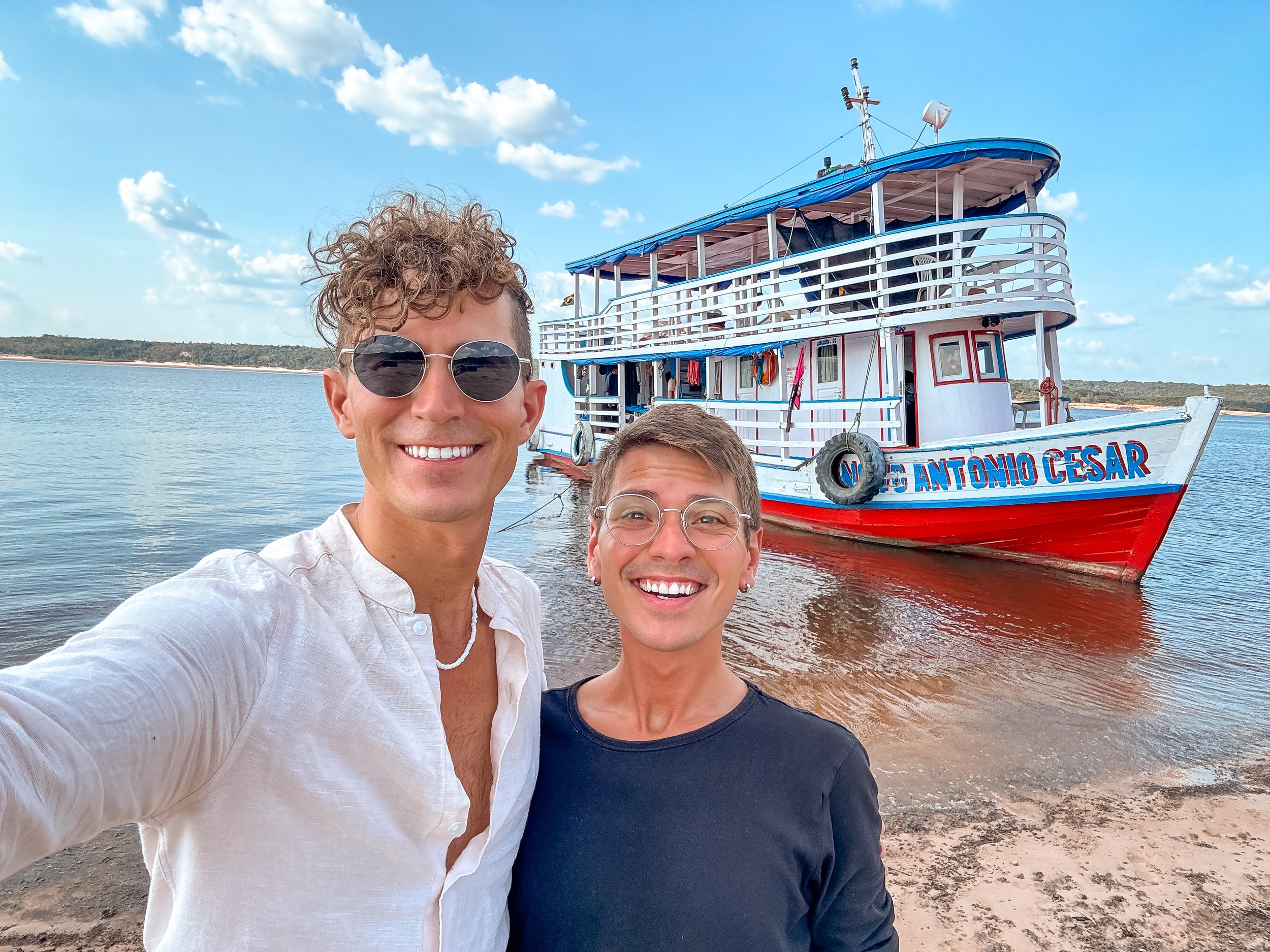
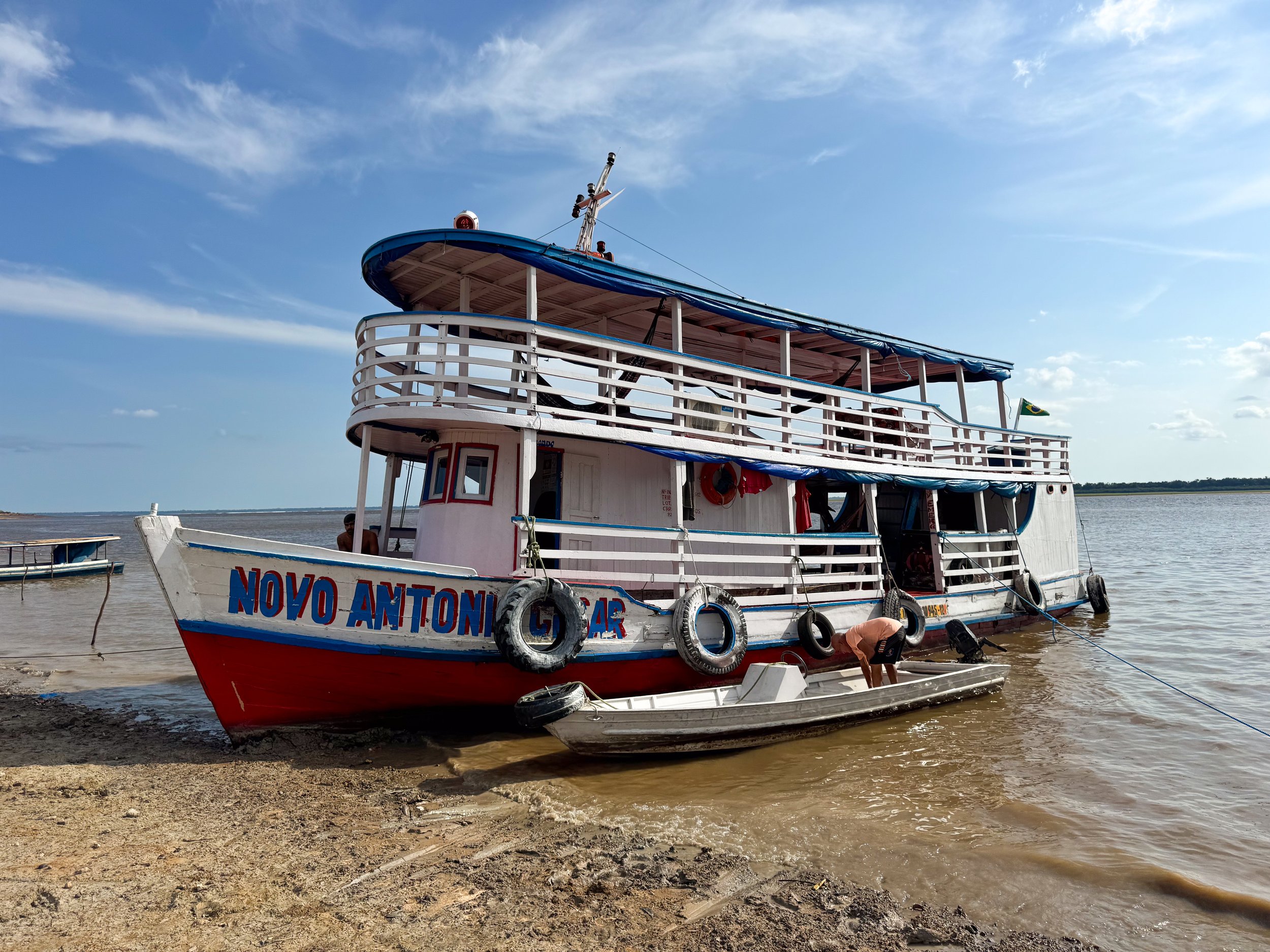
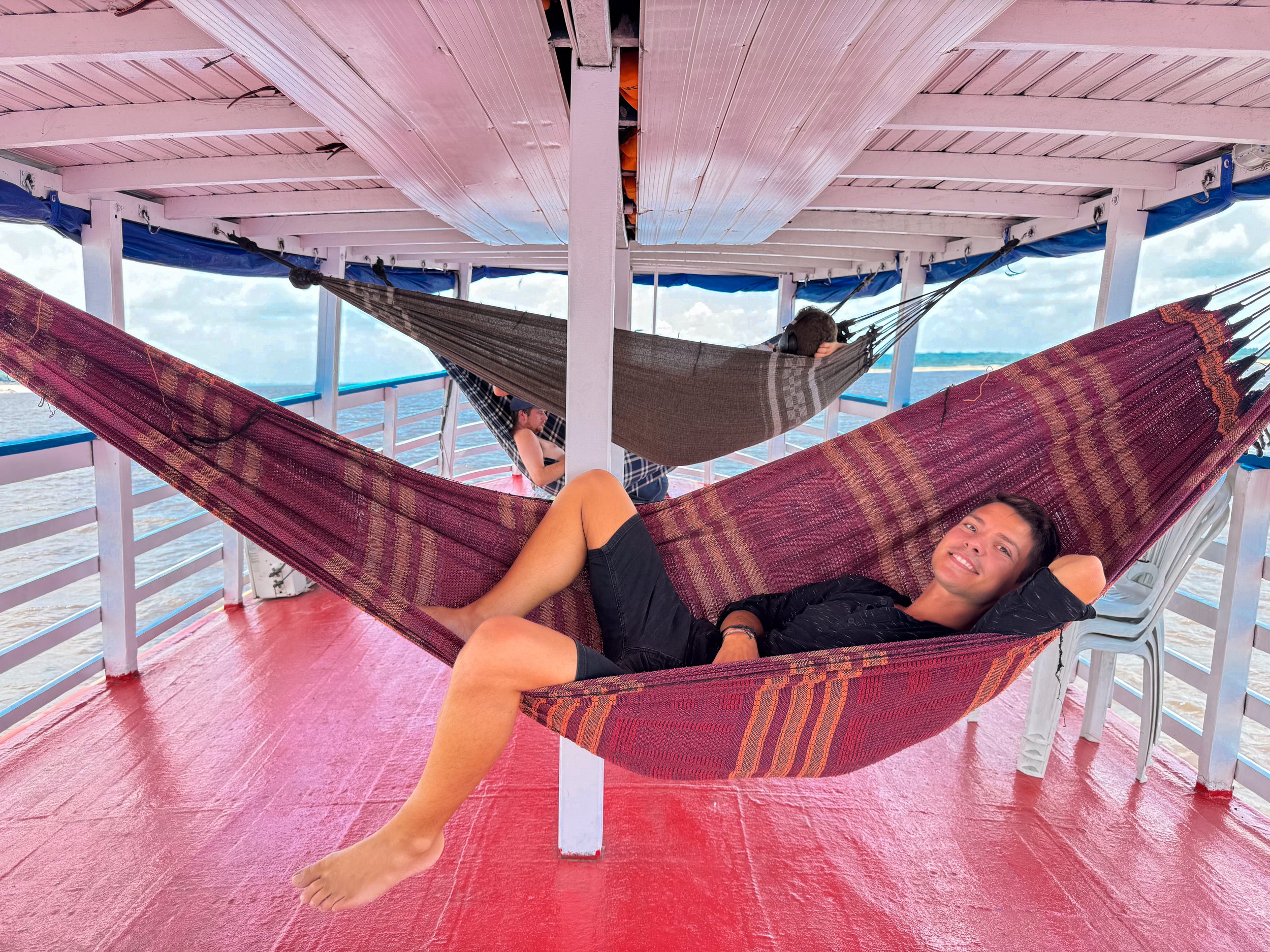

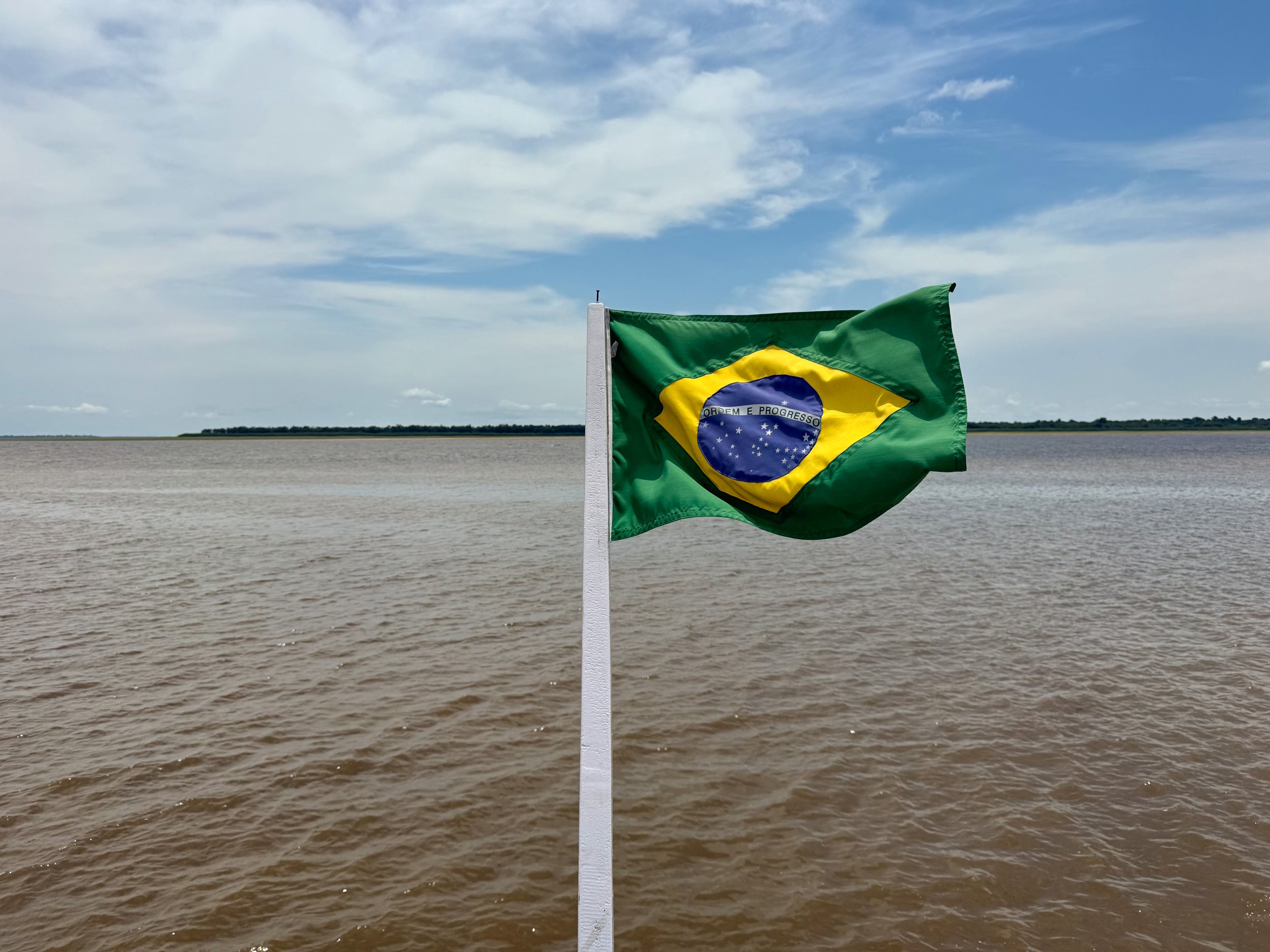
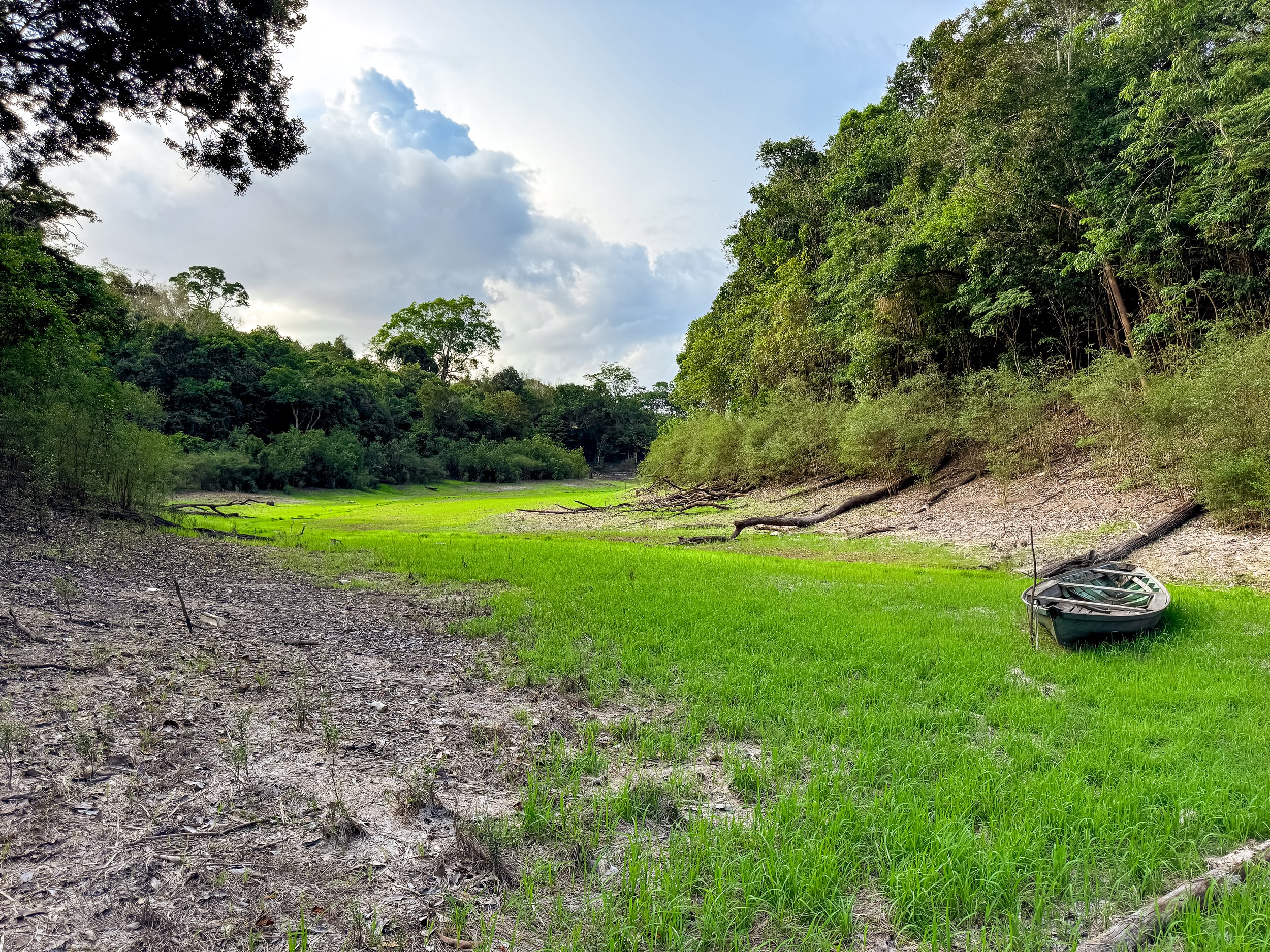
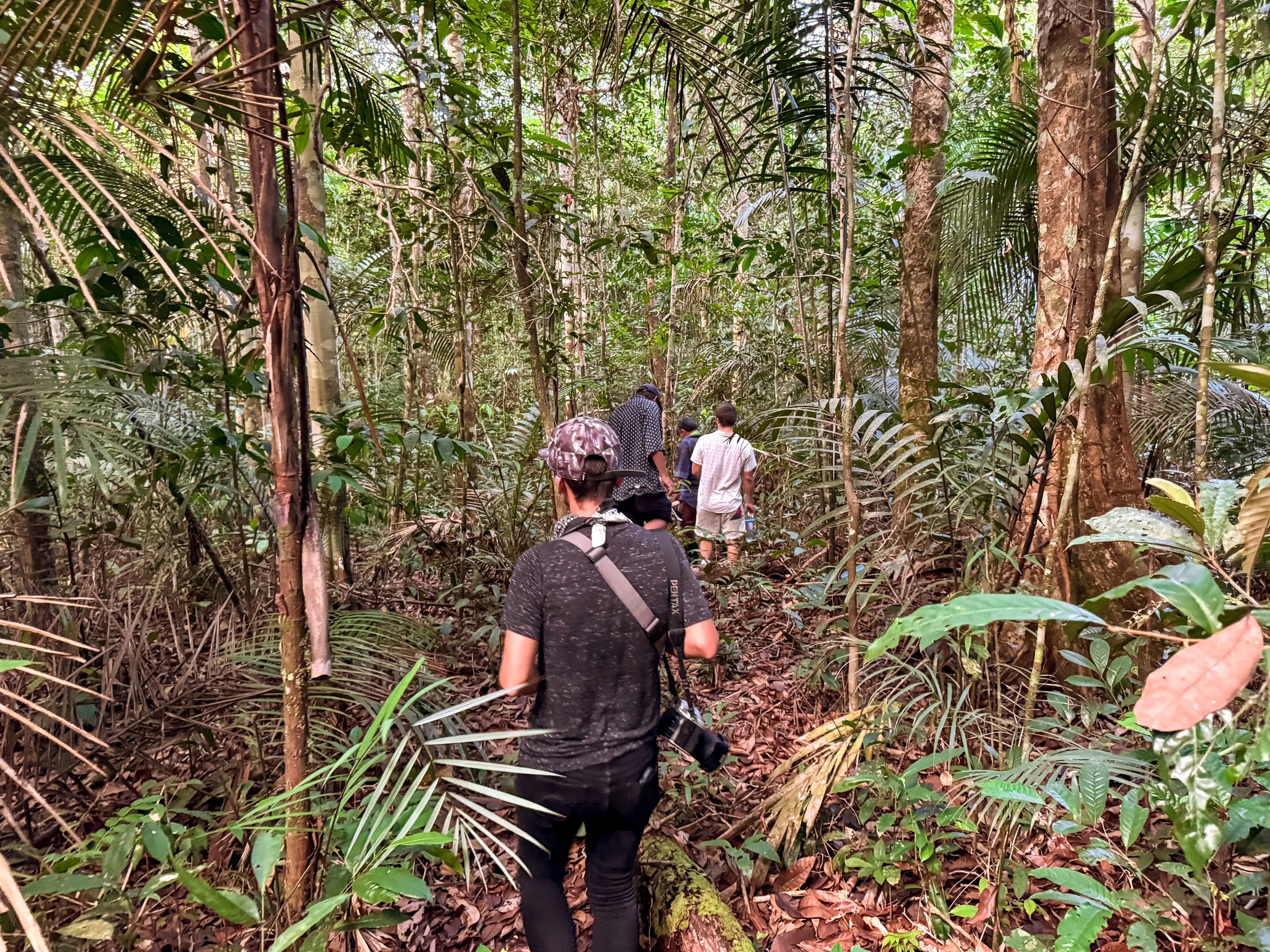
Day One
We spent our first day in the Amazon on the Rio Negro and our first night, sleeping in a hammock within the jungle.
At the Manaus Harbor, we boarded a speed boat and navigated through a storm and choppy water along the Rio Negro to reach The Meeting Waters where we floated between both rivers. We retuned to Manaus where we refueled, stocked up on groceries and ate breakfast at a floating gas station before continuing up river. From the bow of the boat, the Rio Negro stretched far over the horizon. Along its banks were surprisingly white sand beaches, dense tree lines and the occasional river boat, eventually including ours. Arriving at the boat, the crew welcomed us on board and showed us to the upper deck where we would be sleeping in hammocks for the following nights. We relaxed for the afternoon, enjoying fried pirarucu and cashew juice for lunch.
Late in the afternoon, we packed an overnight bag with our hammocks and were led ashore and into the jungle by our guide. Along the trail, he stopped to point out Amazonian fruits, medicinal plants, poisonous spiders and demonstrated how the rubber tree is processed. As night fell, we made camp under a small hut, hung our hammocks and ate fried piranha for dinner. While lying in our hammocks, the noise of the jungle kept us awake for some time. We listened to the roar of howler monkeys, chirps of crickets, croaks of frogs, squawks of birds and hum of cicadas fill the air.
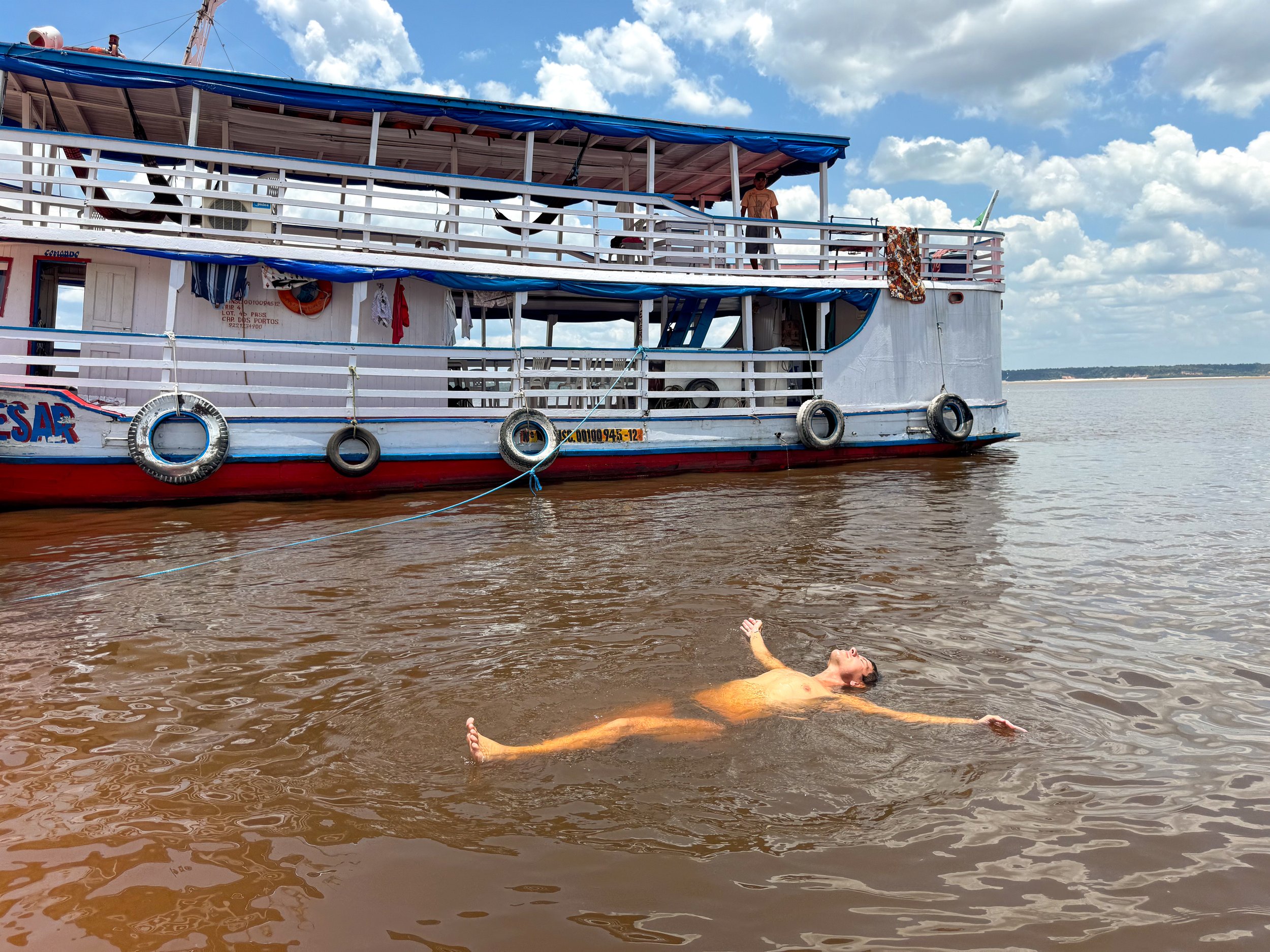
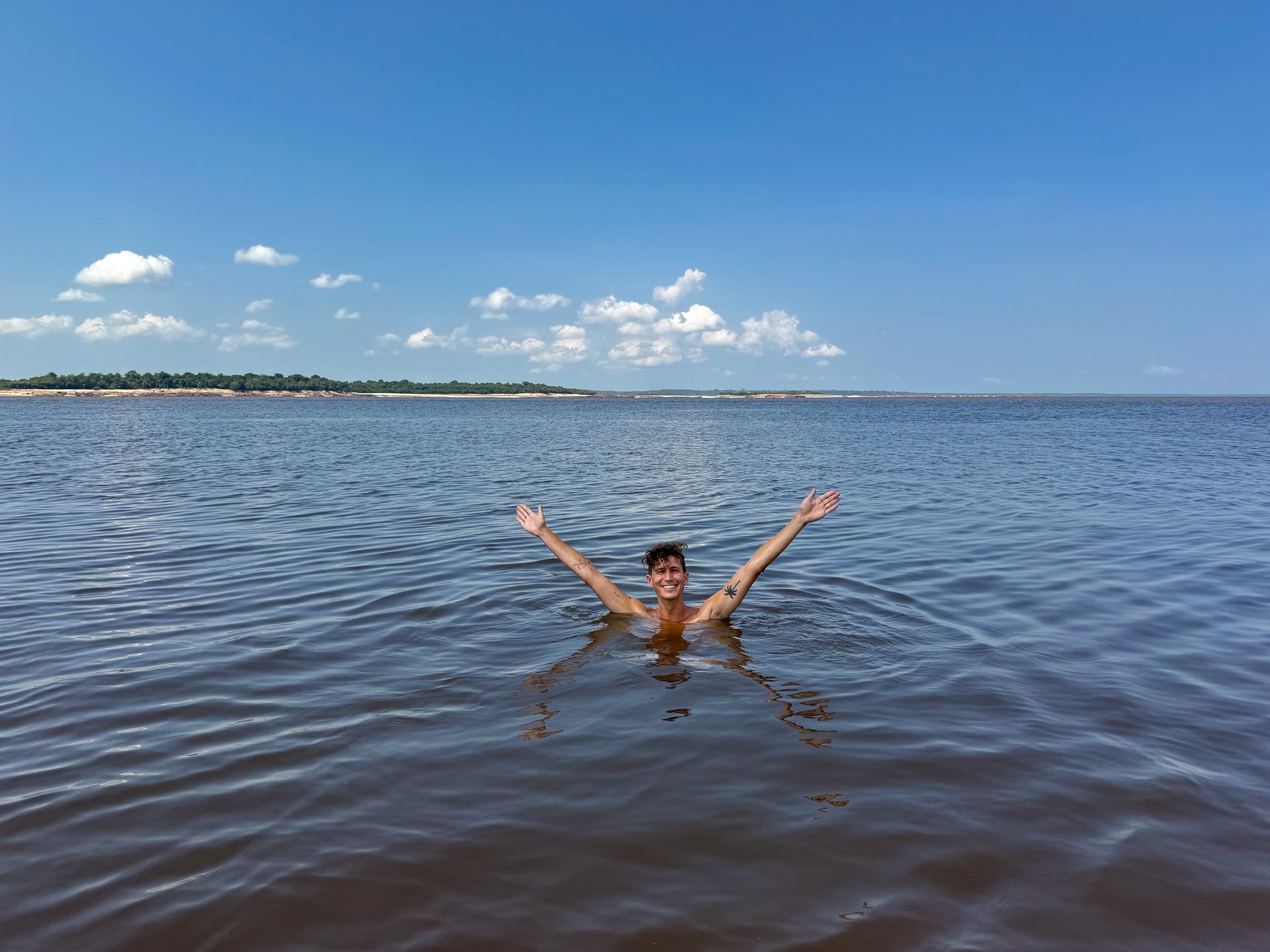
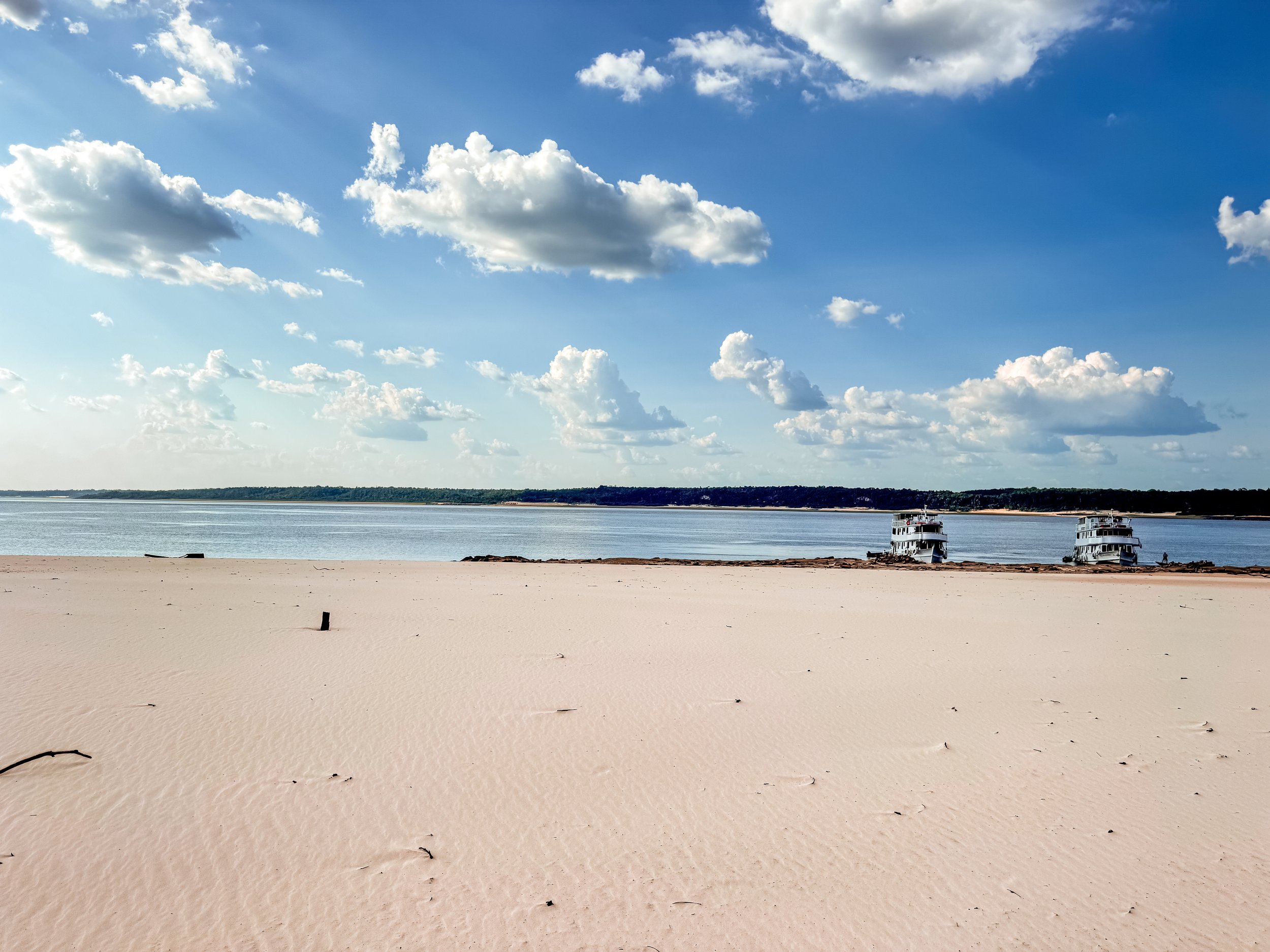
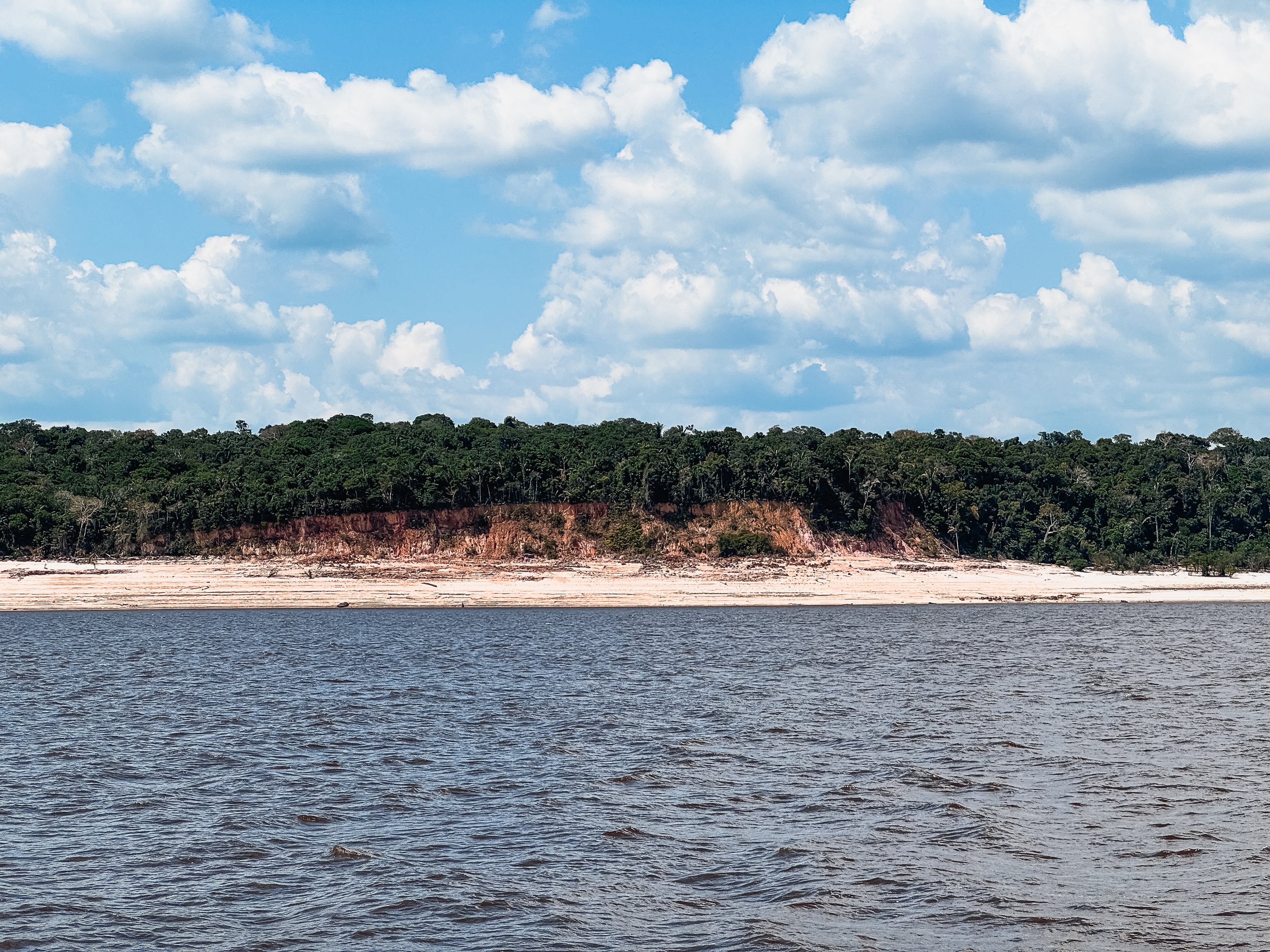
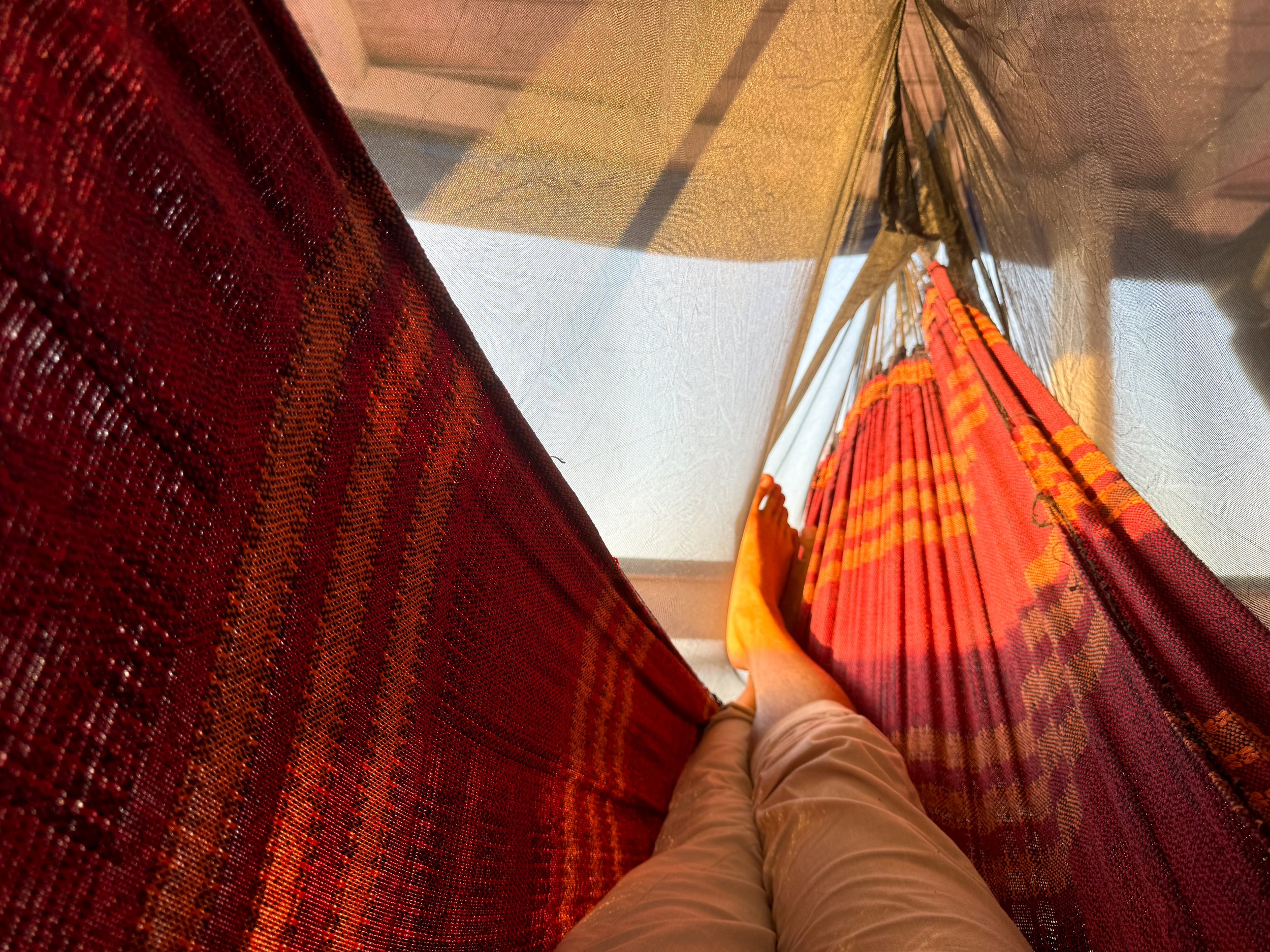
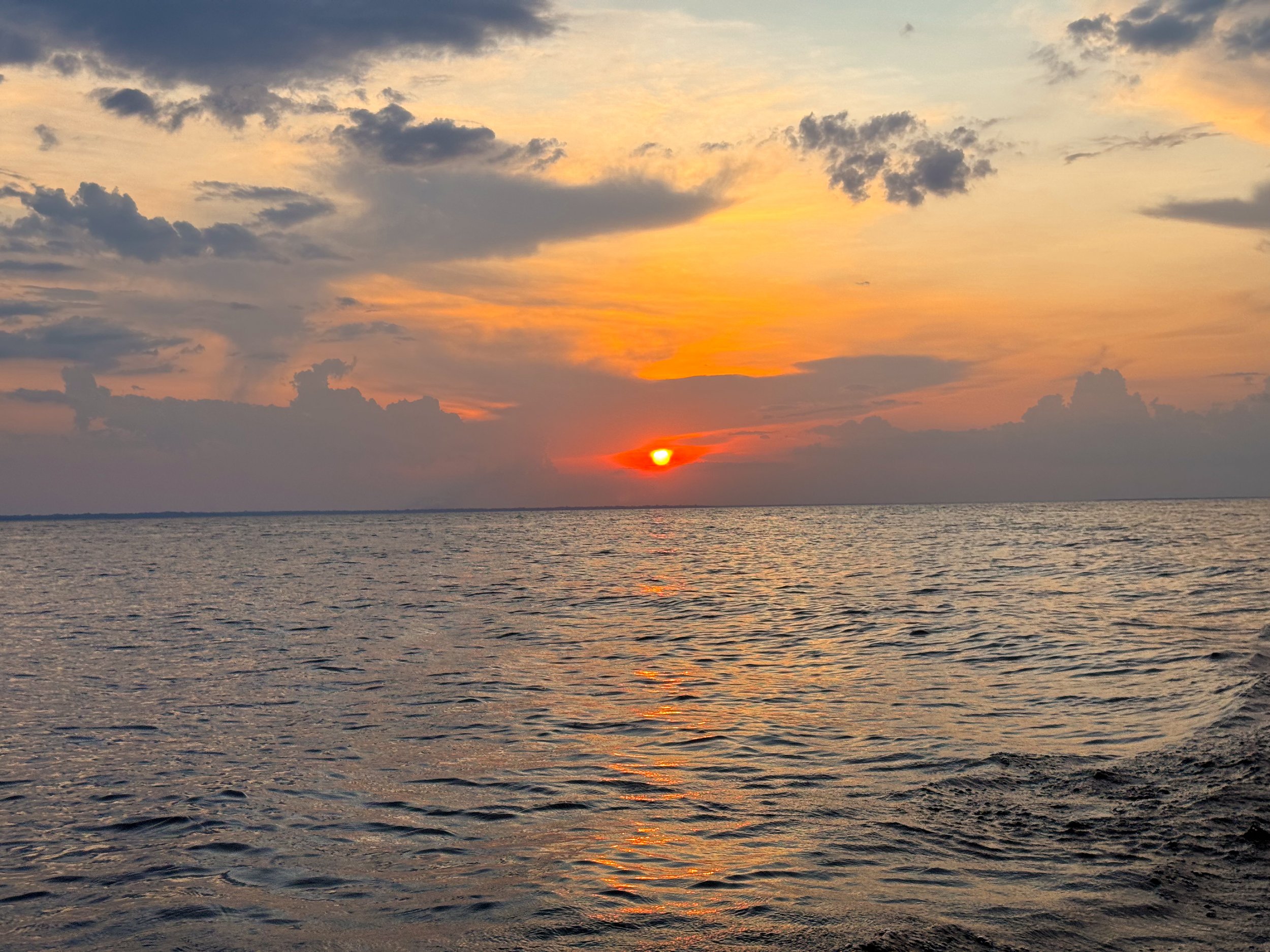
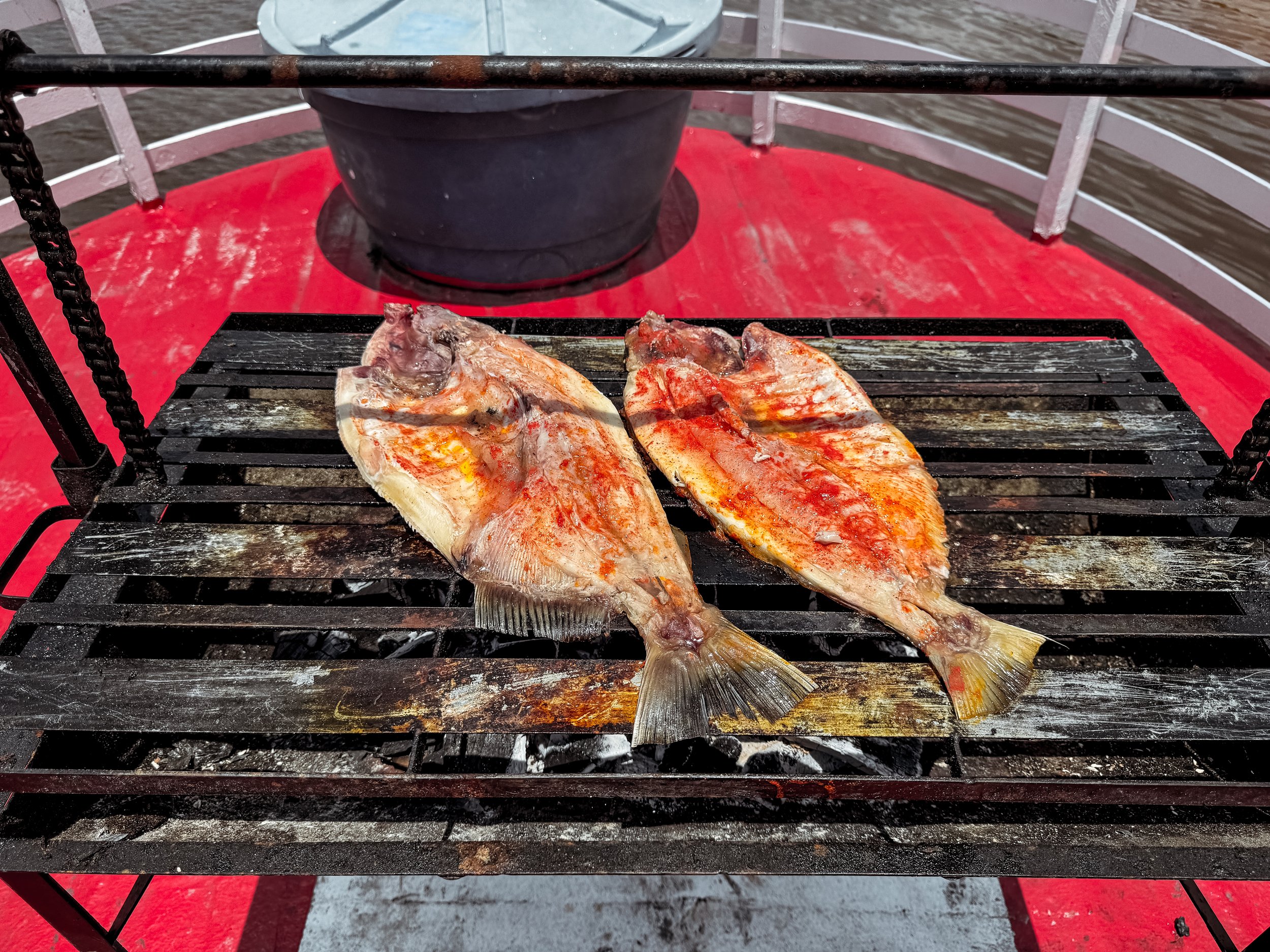
Day Two
We spent our second day in the Amazon swimming in the Rio Negro, relaxing in our hammocks and cooling off in cold stream.
After our night in the jungle, we retuned to the river boat for eggs, tropical fruits and avocado juice. While eating, we cruised down river and moored at white sand beach. We spent the morning here sunbathing on shore, spotting dolphins and swimming in the warm waters of the Rio Negro. As we swam, little fish nibbled at our toes, thankfully not a school of piranha! For lunch, the crew grilled fish, tambaqui de banda, an Amazonian staple. We spent the afternoon on board, feasting on the meal, sipping on Brazilian beer and relaxing in our hammocks.
As the late afternoon heat peaked, our guide brought us ashore to bathe in a cold stream at the base of the indigenous Tatuyo Village, which translates to “Big Snake.” In the village, we visited an indigenous friend of our guide, who invited us into his palm thatched home for coffee. At sunset, we made our way back to the boat, meeting the village Shaman along the way. He invited us back to the village the next morning for a ceremonial ritual.
After sunset and dinner, we laid in our hammocks, reminiscing on the day as the gentle waves rocked the boat and us to sleep.
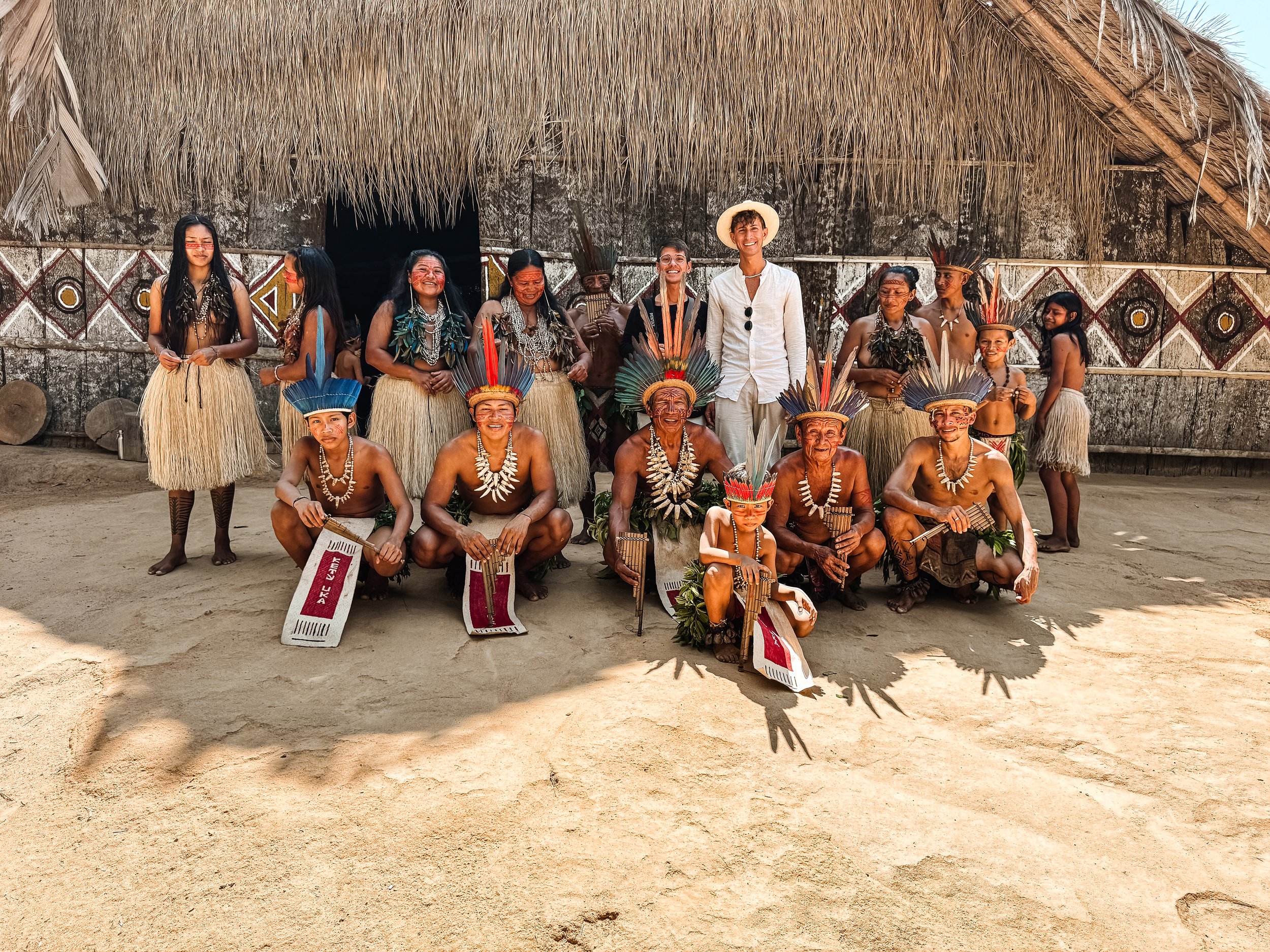

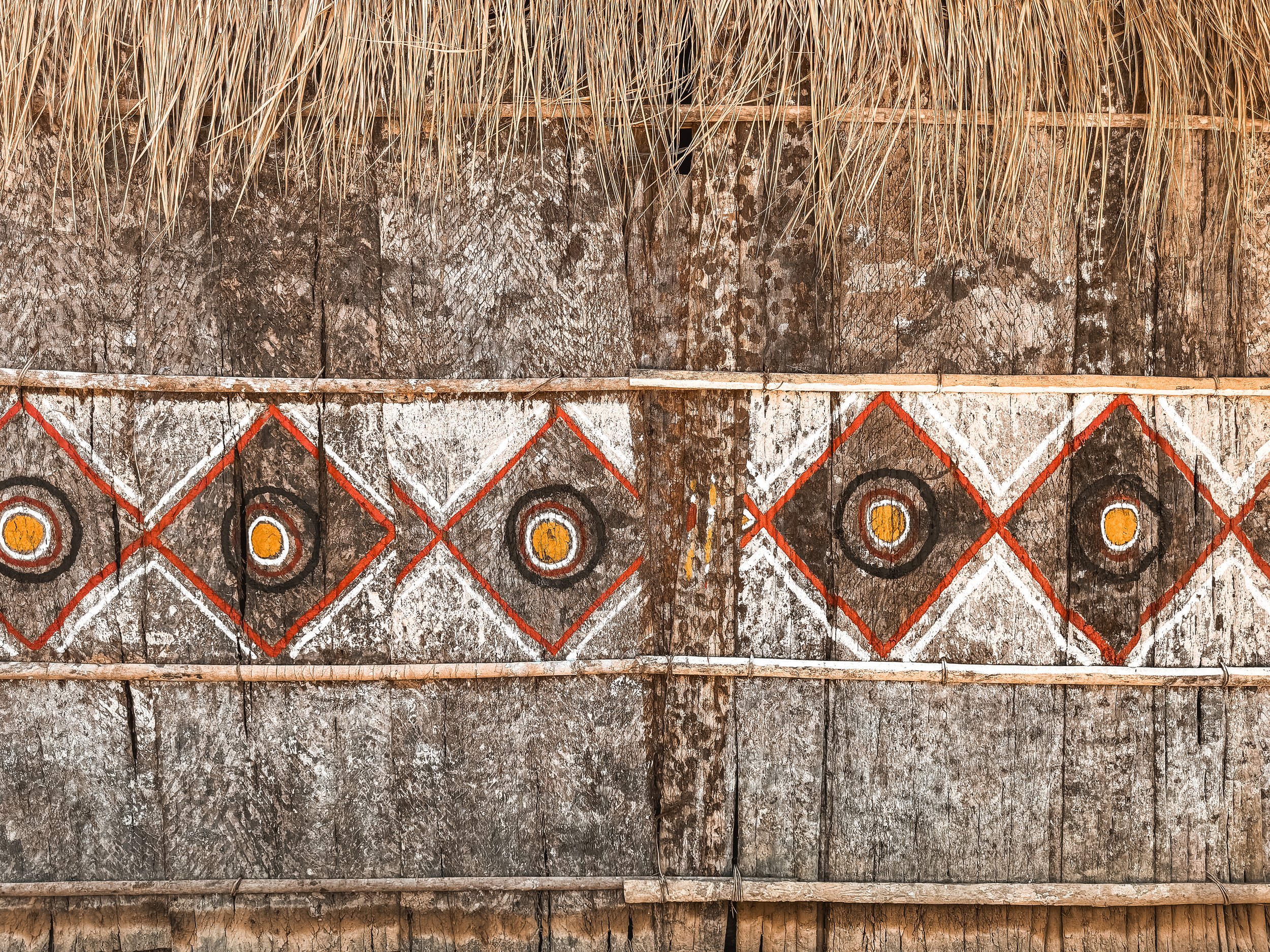
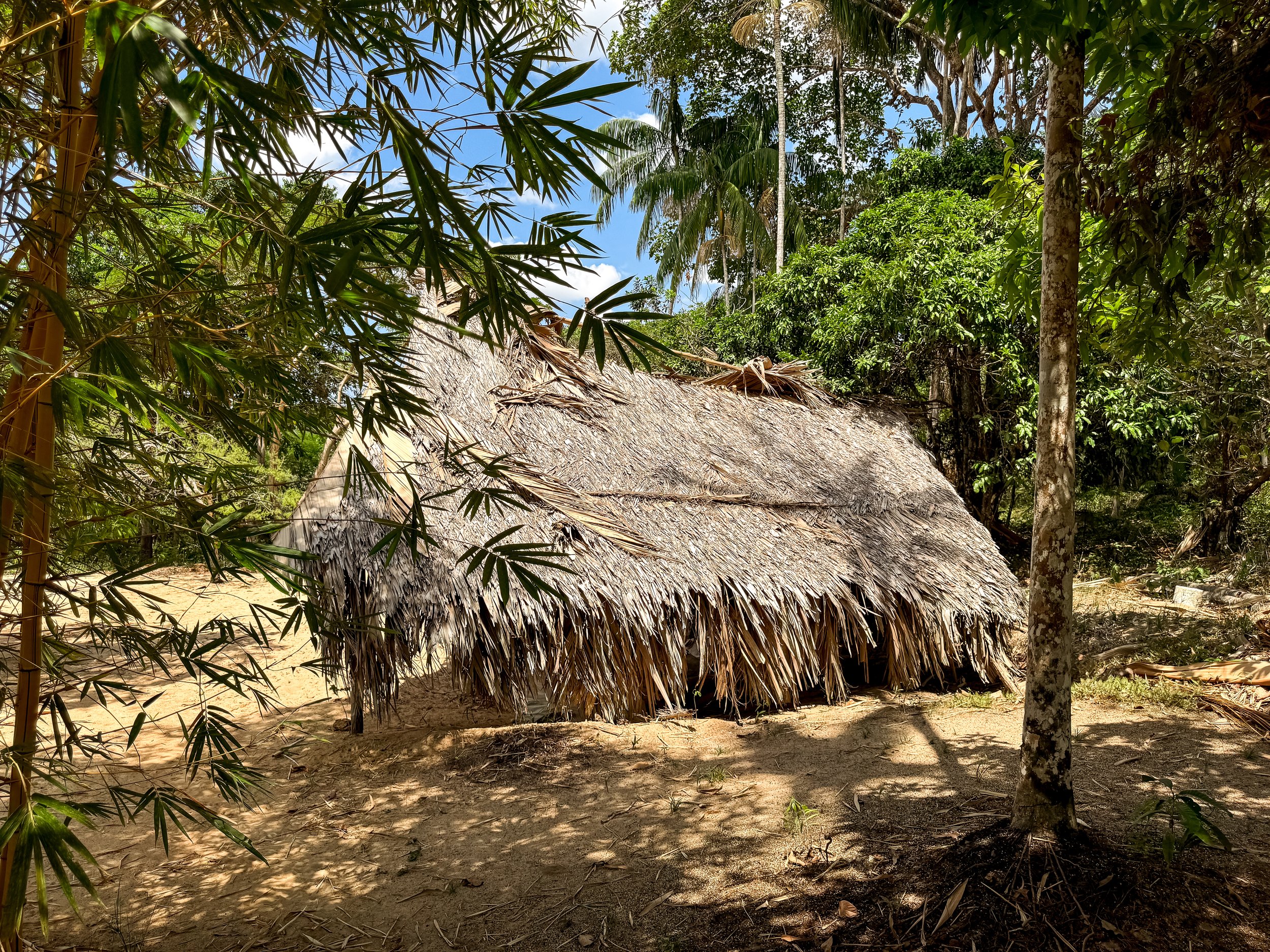
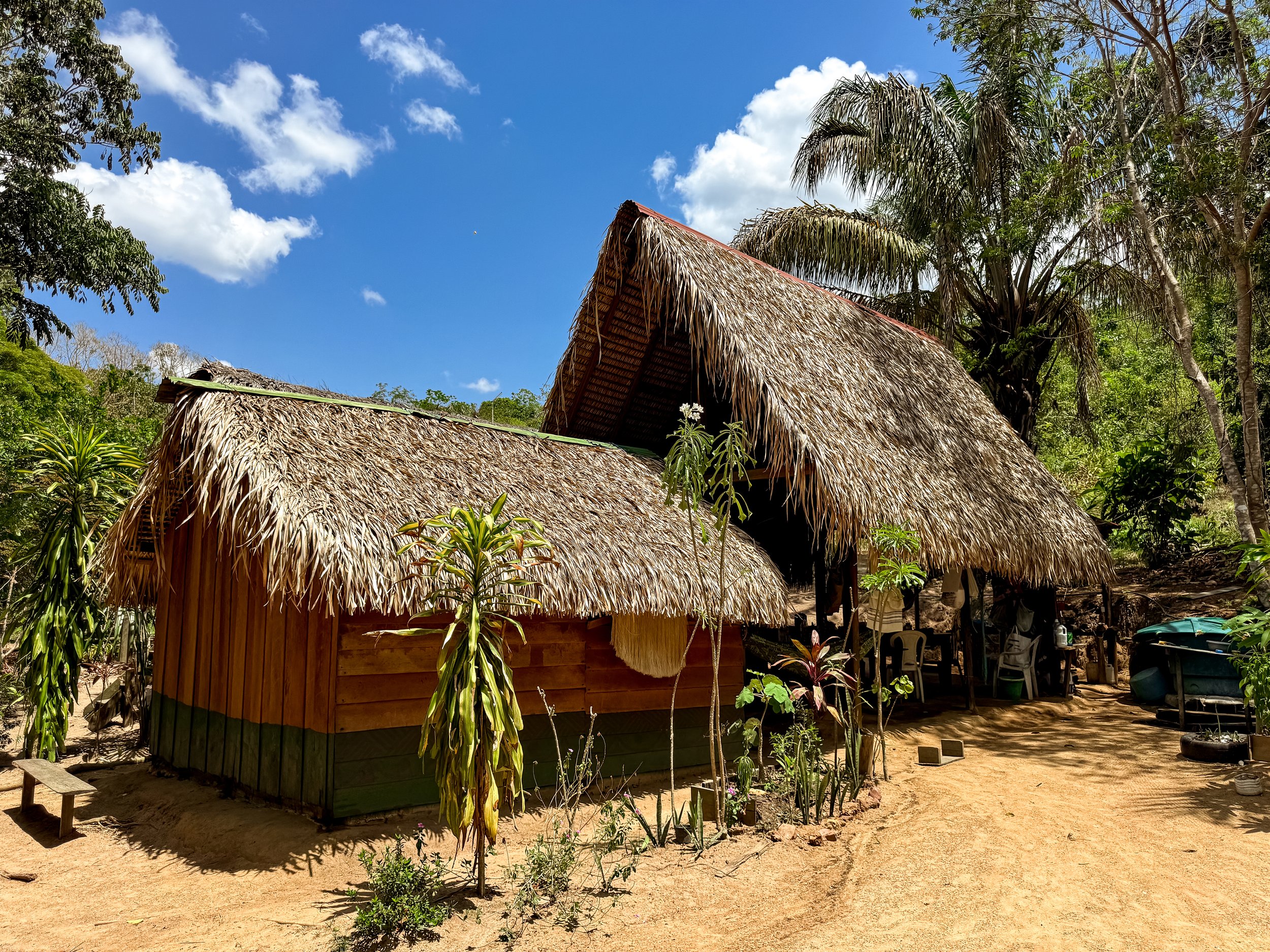
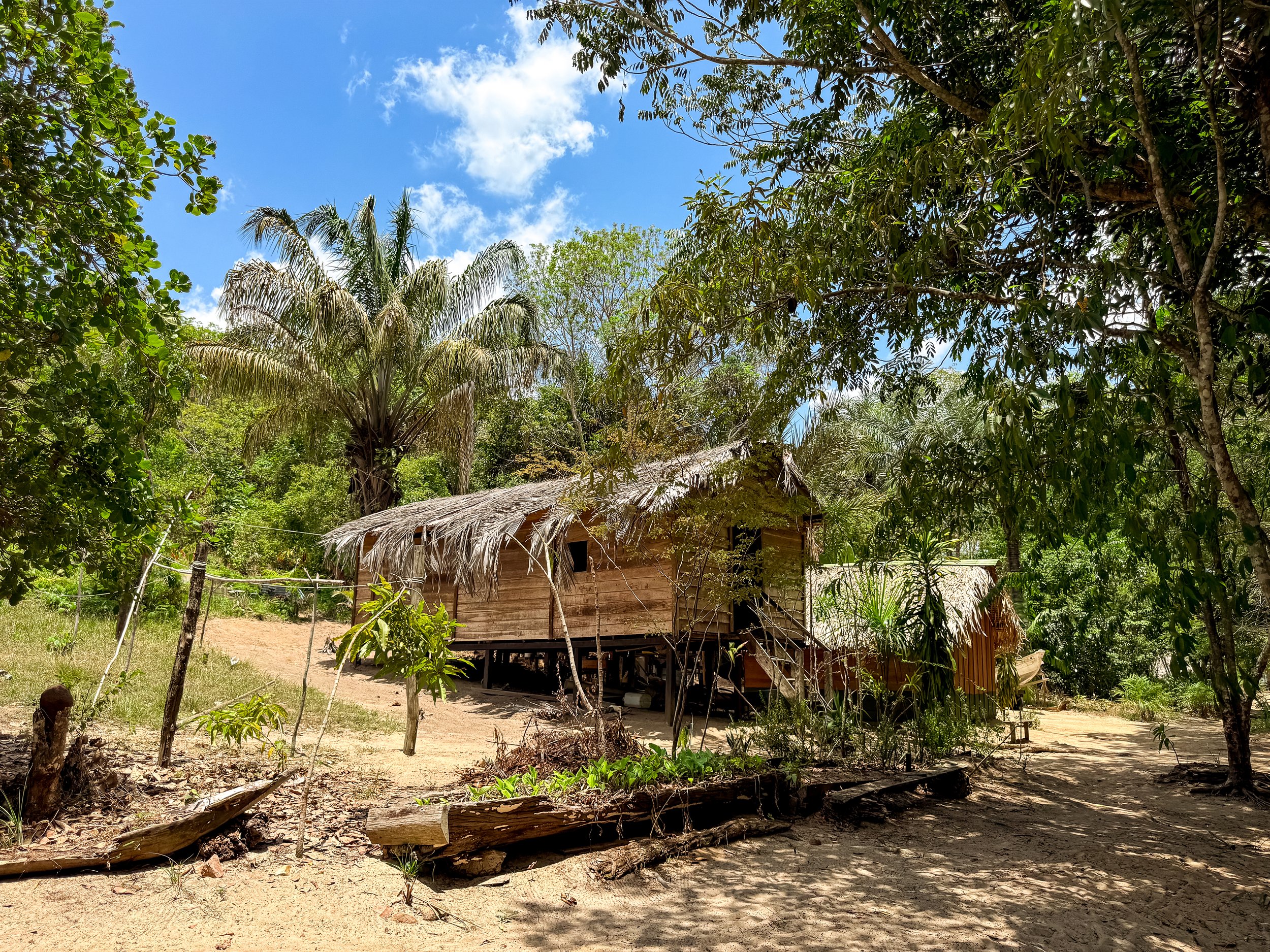
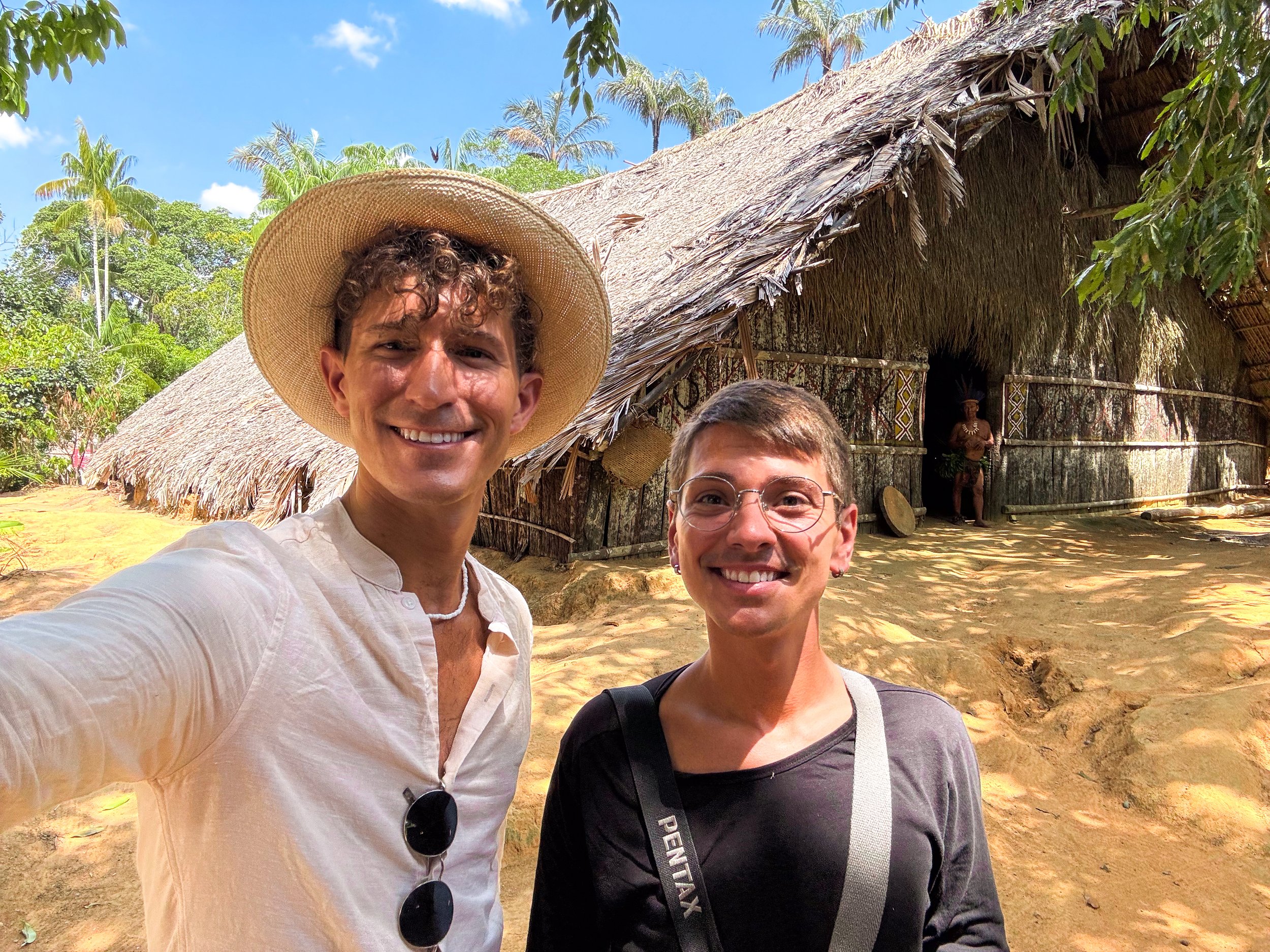
Day Three
We spent our third day in the Amazon at the indigenous village of Tatuyo for a ritual ceremony, bathing in a cold spring, fishing for piranha and spotting caiman.
As dawn broke, we woke up to warmth of the sun hitting our hammocks and met the crew downstairs for breakfast. Once we finished eating, we retuned to the Village of Tatuyo for the ceremonial ritual. The shaman and several others, dressed in ceremonial attire, greeted us at a large palm thatched pavilion with wooden walls painted in a snake like pattern. Women wore large feather earrings that covered their breasts, açaí bead necklaces and grass skirts. Men wore feather headpieces, caiman and jaguar teeth necklaces and skirts made of leaves. All of which had red painted patterns on their faces similar to the ones on the walls of the pavilion.
The shaman explained the ritual and ceremonial dances they were going to share with us. Each symbolized and important moment in a person’s life while the final dance is used for general celebrations. Led by two women, we were able to participate in the latter. Each dance was unique, involving different flute like musical instruments, songs and choreography. The group danced in circular, spiral and figure eight patterns as the smell on incense filled the pavilion.
Once the ritual ceremony had completed, we met our guide’s friend who showed us a cold spring where we bathed in the refreshingly cool water. After cooling off, we retuned to the boat for lunch and to hike along the river bank listening to macaws and howler monkeys in the jungle.
Near sunset, we cruised to a cove to fish for piranha! Using bamboo poles baited with meat, we splashed them around in the water to attract piranha. Within seconds one would bite, often tearing off the bait. Luckily our guide caught several piranha which the crew fried in farina for dinner.
After dark, we took the speedboat to look for caiman, shining a light along the shoreline looking for the glow of their eyes. The light attracted tiny fish that jumped out of the water, one landing in my lap (thankfully not a piranha). Within moments, we spotted a caiman lurking in the shallows. After a very full day, we returned to the riverboat and fell asleep of on deck in our hammocks.
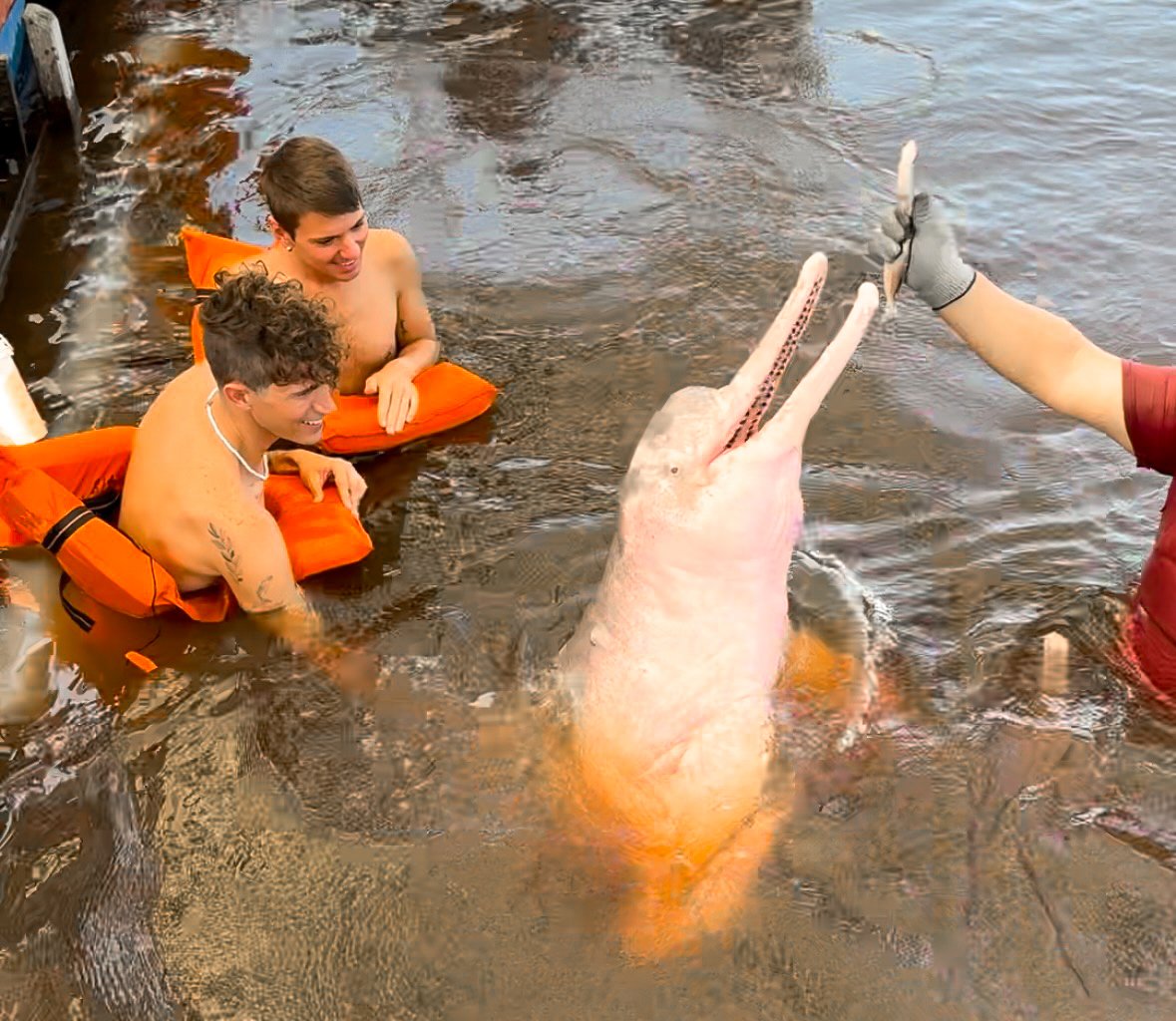
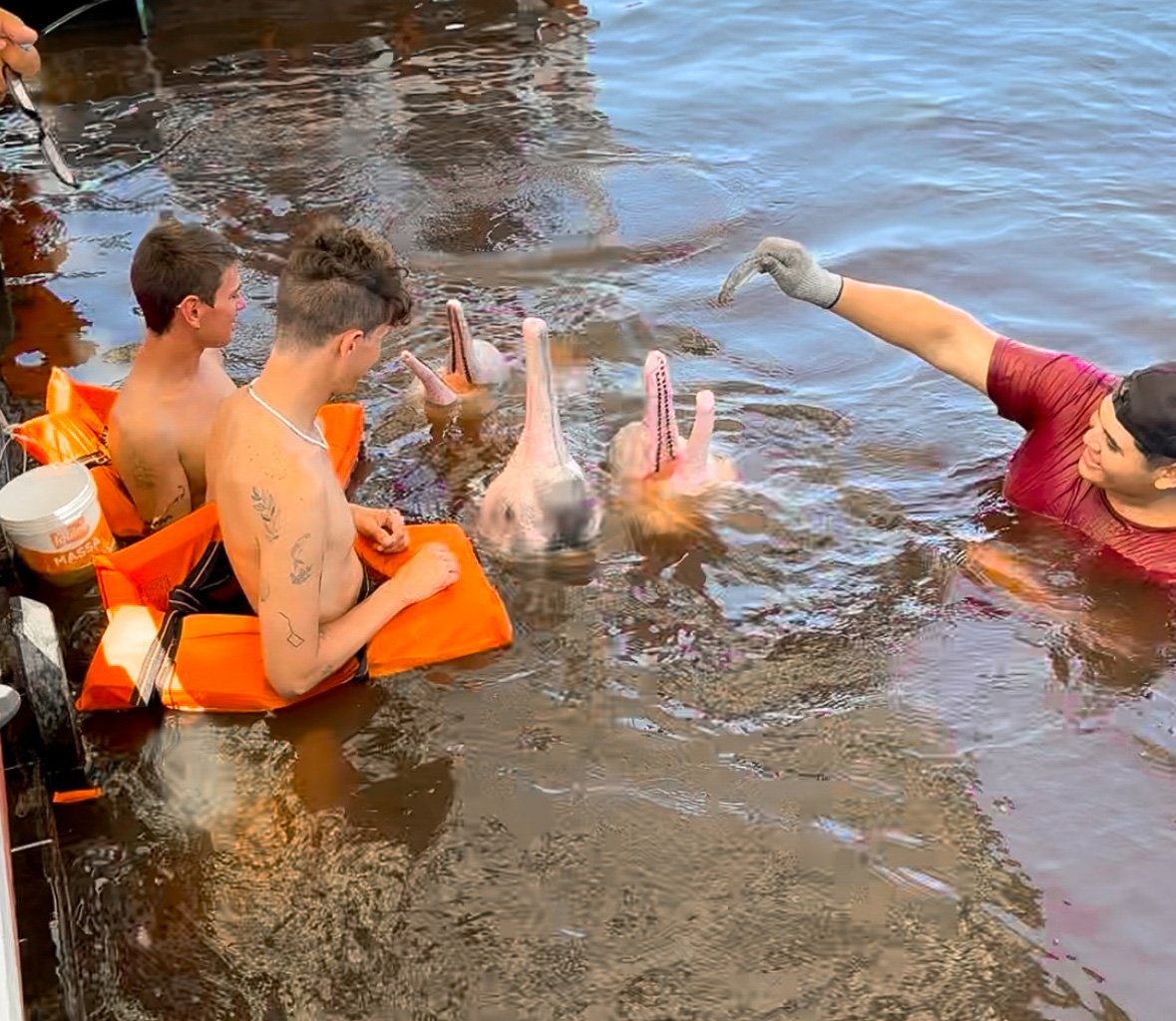
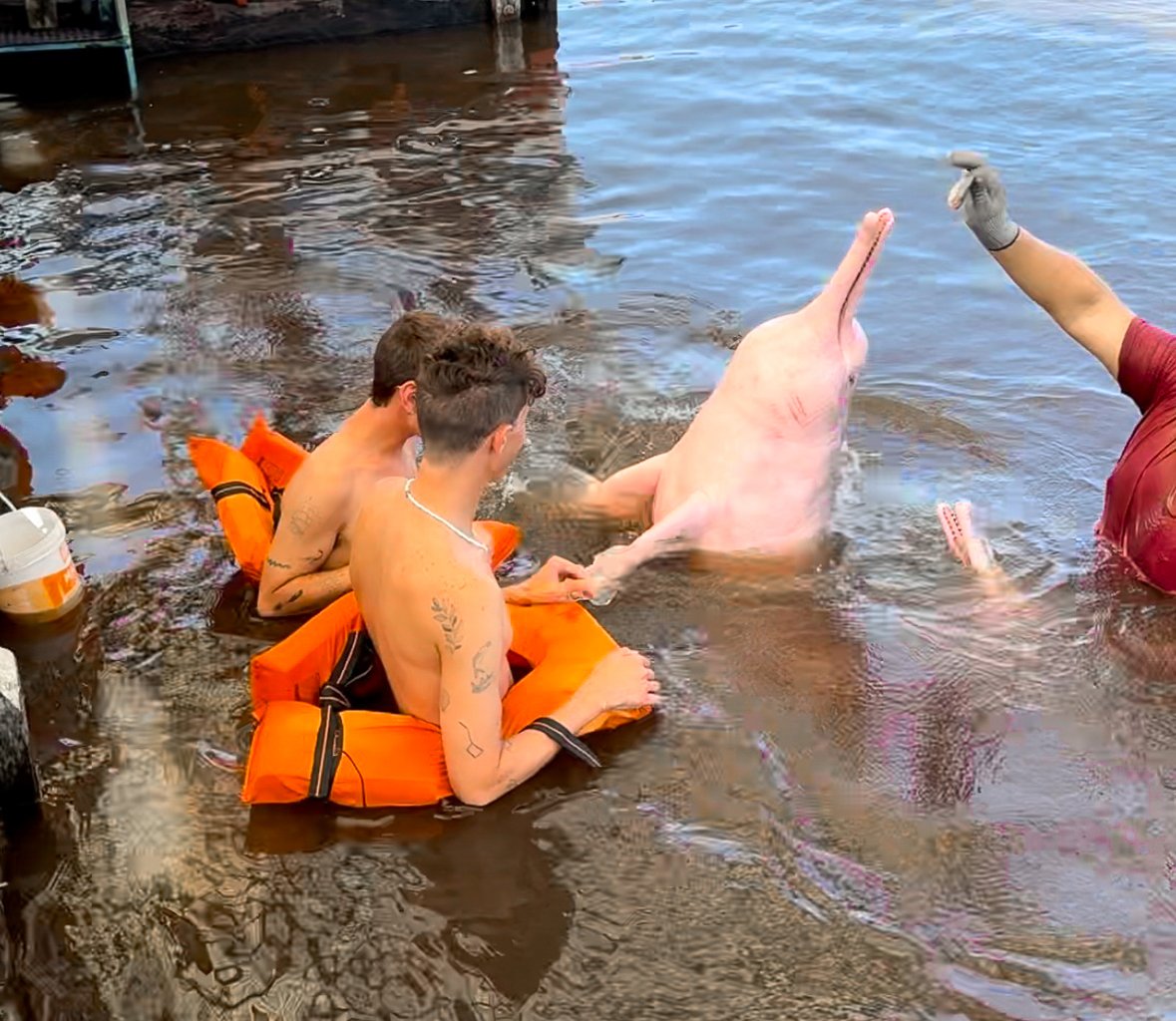
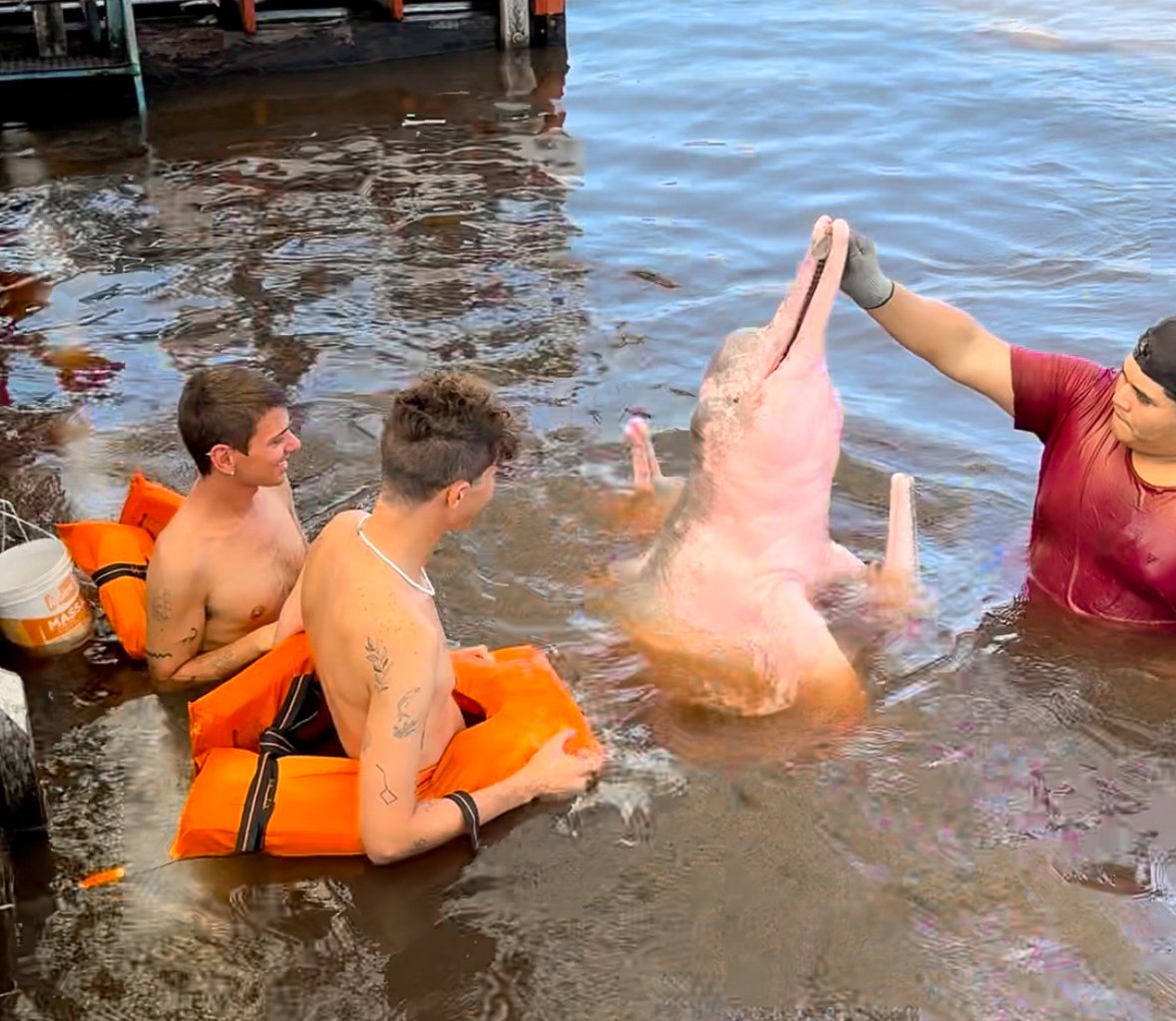

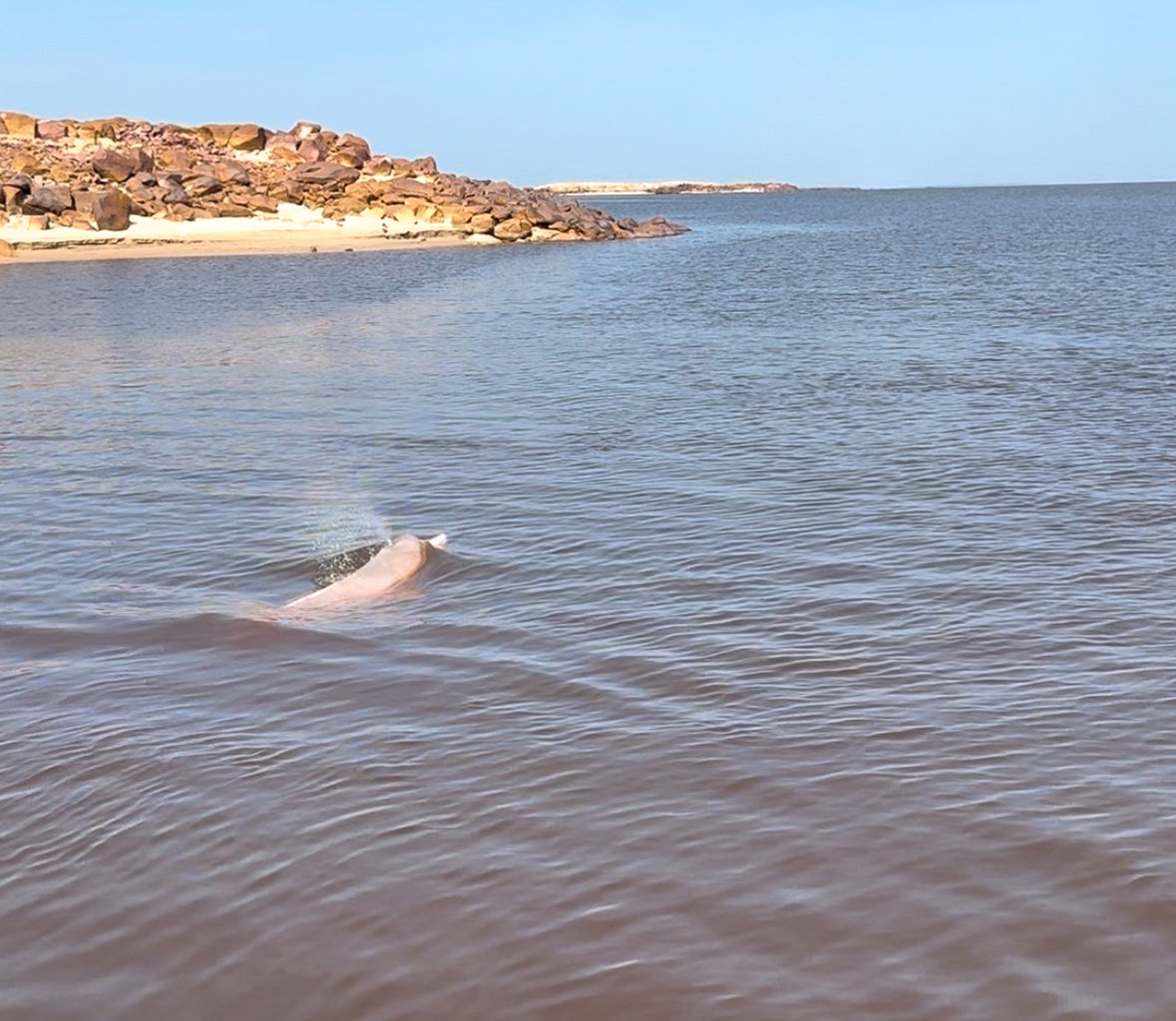
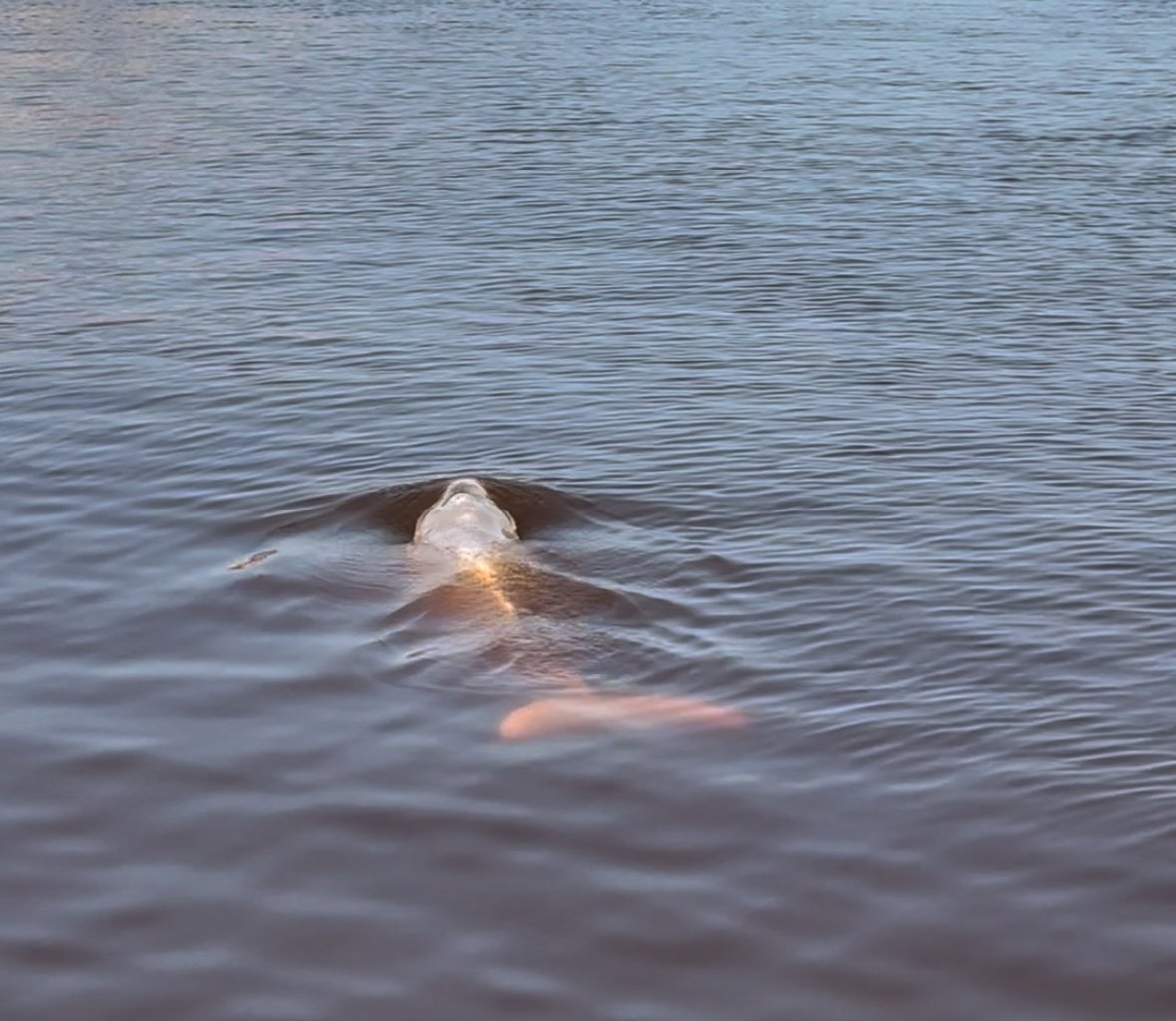
Day Four
We spent our fourth day in the Amazon swimming with pink river dolphins and relaxing at a beach before retuning to Manaus.
We woke up to breakfast with fresh fruit and tapioquinha while watching pink river dolphins swim around the boat. In a nearby cove, we watched as a handler fed the dolphins fish. Up close, we could admire them in detail. They have pink skin with grey splotches, long mouths lined with rows of nail like teeth and a wide upper fin. In the water, the dolphins swam around our legs, poked their heads up and swam off when fed. It was truly an incredible Amazonian experience!
After swimming with the dolphins, the crew began preparing lunch, tambaqui de banda. As the fish grilled, we stopped to swim at a white sand beach and enjoyed the last meal onboard the boat. After lunch, we napped in our hammocks as we cruised back to Manaus.
Good to Know:
Cell Service. As we expected, this area is very remote, there is little to no cell service or data outside of Manaus.
Mosquitos. We brought a mosquito net specifically to cover our hammock at night. In addition, we wore copious amounts of insect repellants when in the jungle.
Piranha. The carnivorous fish are generally not attracted to humans. Still, it’s best to avoid entering the water with an open wound, making sudden movements and splashing around.
Pink River Dolphins. Unlike many “dolphin encounters” the pink river dolphins are protected and remain wild. It’s regulated how many fish can be fed to them per day as not to build a dependency.
Cost. Multi night Amazon tours are not cheap. They can range from several hundred dollars well into the thousands per person.
Where to Book. We booked our tour with Amazon Amazing Tours on Get Your Guide. It was one of the more cost effective tours and well worth the experience!
Amazonian Cuisine
A huge part of our time in the Amazon was trying the cuisine! The flavors of the Amazon are as vast as the rainforest itself including tropical fruits, starchy root vegetables, fresh water river fish and even insects.
Amazonian Fruit
Açaí. The tiny Amazonian super fruit from the Açaí palm. By itself, it has a bitter blackberry like flavor. It’s often served as a sorbet with other fruits, granola and honey. Its pits are used for jewelry and decor.
Cupuaçu. A brown podlike fruit with a with seeded spongy interior. It’s often processed into a cream and added to drinks, deserts and açaí.
Tapereba. An Amazonian fruit with an orange skin and the flavor of a plum and mango but less sweet. It’s served in juices, ice cream, fresh or peeled and sautéed.
Brazil Nut. Technically not a fruit, however the nut is sold at some food carts and stands around Manaus.
Tropical Juices. Many Amazonian fruits are used to make tropical juices including avocado, cashew, maracujá and guava.
Avocado Juice. Avocado blended with milk and sugar. If you’ve never had it, it sounds strange but is tasty and mildly addicting.
Cashew Juice. Juice made from the cashew fruit, the source of the cashew nut. It has a unique, slightly acrid, sweet flavor. When underripe, it has a mango like flavor.
Maracujá Juice. The sweet sour juice from passion fruit, with seeds and all.
Guava Juice. Juice made from guava, it has a tangy plumelike flavory and creamy texture.
Other common fruits are watermelon, papaya, pineapple, mango, banana, orange and coconut.
Amazonian Fish
Tambaqui. A popular freshwater fish from the Amazonian rivers. At restaurants, halves of the fish called Tambaqui Banda, are often served grilled or fried for multiple people to share. Its ribs (yes literal ribs), called Tambaqui Costela, are served as individual portions either grilled or fried. The fish can also be prepared in a savory vegetable stew called Caldeirada de Tambaqui. We tried it all ways and it’s easily one of the most flavorful fish we’ve ever tasted!
Pirarucu. A very large freshwater fish from the Amazonian rivers. It’s a common menu item at restaurants served alone or inside various dishes. It has a tender, buttery texture and the flavor of a white fish. It’s locally known as the “Cod of the Amazon.” Filets measuring a few inches to several feet long can be bought fresh or salted from the fish market.
Red Bellied Piranha. The well known tiny carnivorous Amazonian fish with razor like teeth. They are served fried or grilled and have a tender flavor similar to any white fish. Multiple are typically served at one since each only has a few bites of meat.
Amazonian Dishes
Farinha. An Amazonian “grain” specific to the region made from ground cassava prepared in fine to large granules. It’s served as a side and topping on many dishes.
Tapioquinha. A Brazilian style crepe made from tapioca flower and filled with Amazonian fruits, eggs, cheese or meats. It’s a popular breakfast dish.
Ants. Though not common, they are a delicacy stemming from Indigenous Amazonian tribes. The two most popular are Saúva Ants and Maniwara Ants. The first is a burgundy colored leaf cutter ant with a tangy grassy flavor. The second is a larger tan ant with a sweet toasty flavor.
Vatapá. A creamy paste like strew made with coconut milk, shrimp and tomatoes. It has a savory, somewhat bitter and starchy flavor.
Tacacá. A soup made from boiled cassava broth, cassava gel, herbal jambu leaves and salted shrimp. It’s traditionally served in a calabash (a bowl made from a gourd) and sipped on using a wooden skewer to eat the jambu greens and shrimp. It’s popular in Amazonia, even on scorching hot days.
Amazonian Beverages
Guaraná Antarctica. A very popular soda made from the guaraná fruit. It has a bubbly honey like flavor.
Guaraná Baré. Manaus’s version of Guaraná Antartica. It has a similar flavor, it is less carbonated and slightly sweeter.
Guaraná Smoothie. A smoothie made with guaraná syrup and power mixed with peanuts and milks.
Caipirinha. A cocktail made with Cachaça (a Brazilian rum), muddled limes, sugar and ice. It’s commonly served at bars in its classic form or with Amazonian fruit flavors.
Manaus
Manaus is a city in the heart of the Brazilian Amazon where concrete jungle meets literal jungle. It’s an adventurous hub for Amazonian excursions including multi-night river tours, cultural experiences with indigenous tribes, rainforest hikes and swimming with pink river dolphins. The city is famed across the region for its Amazonian markets, restaurants and historic architecture dating back to the “rubber boom” of the late 1800s.
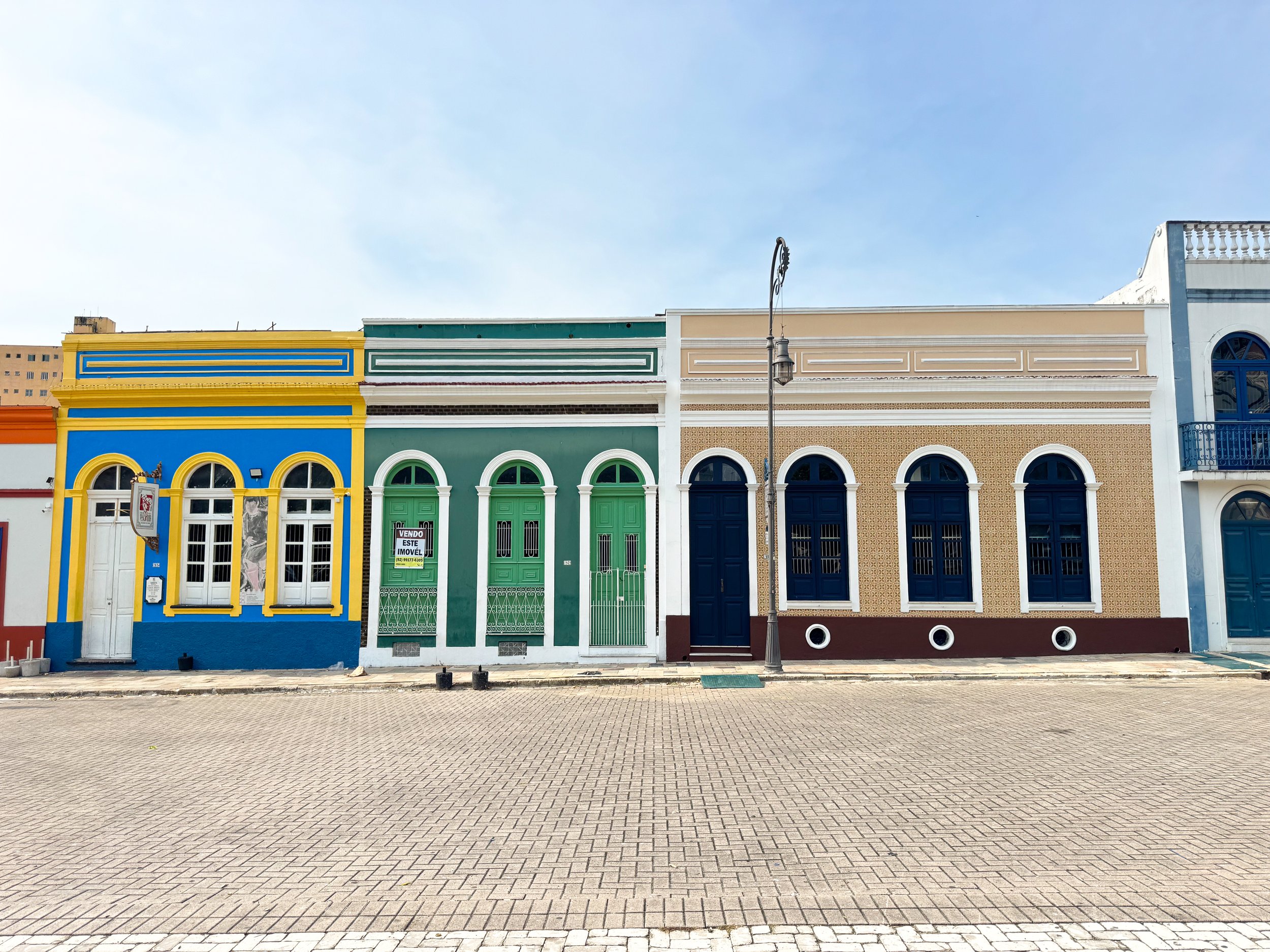
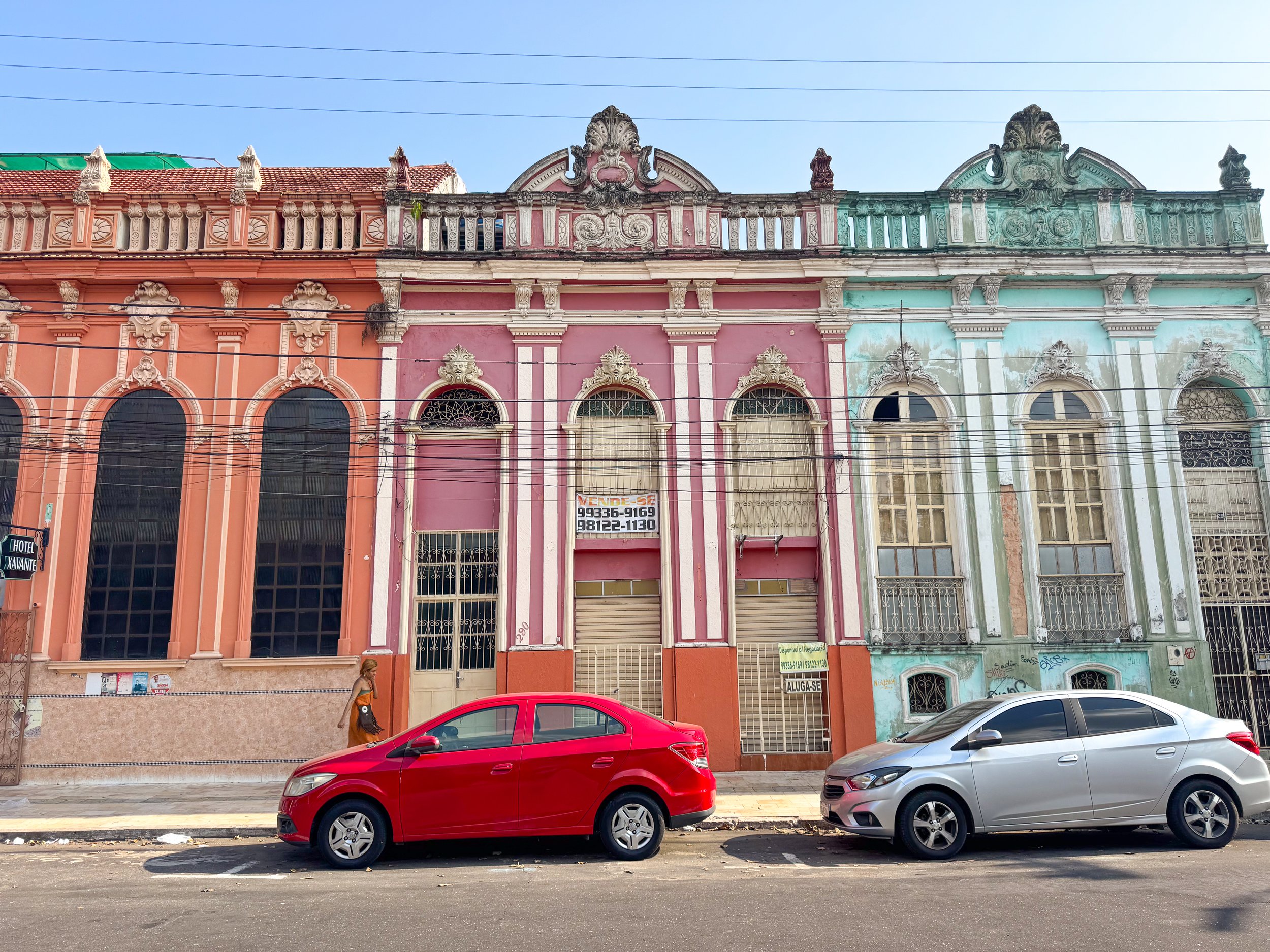
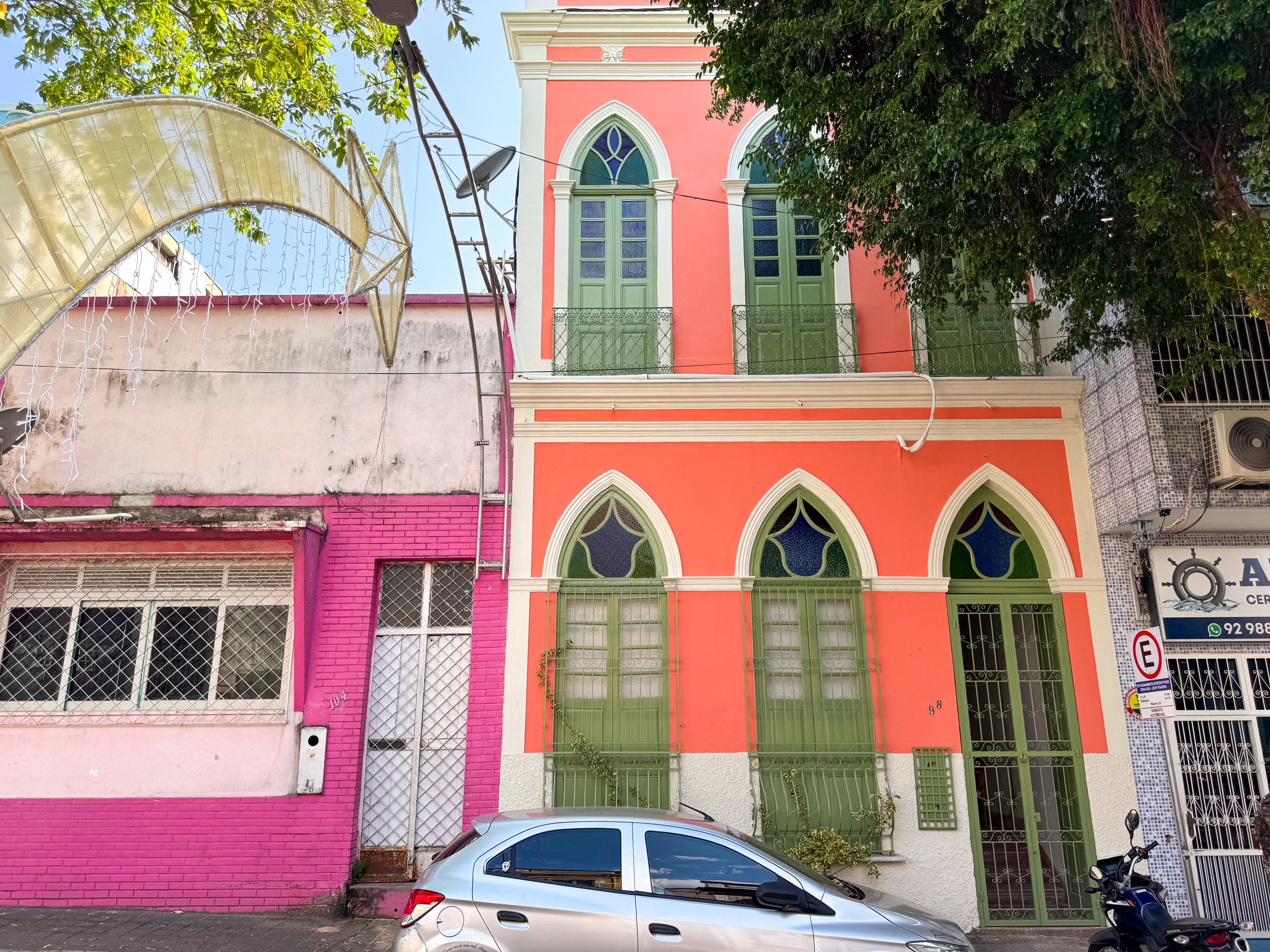
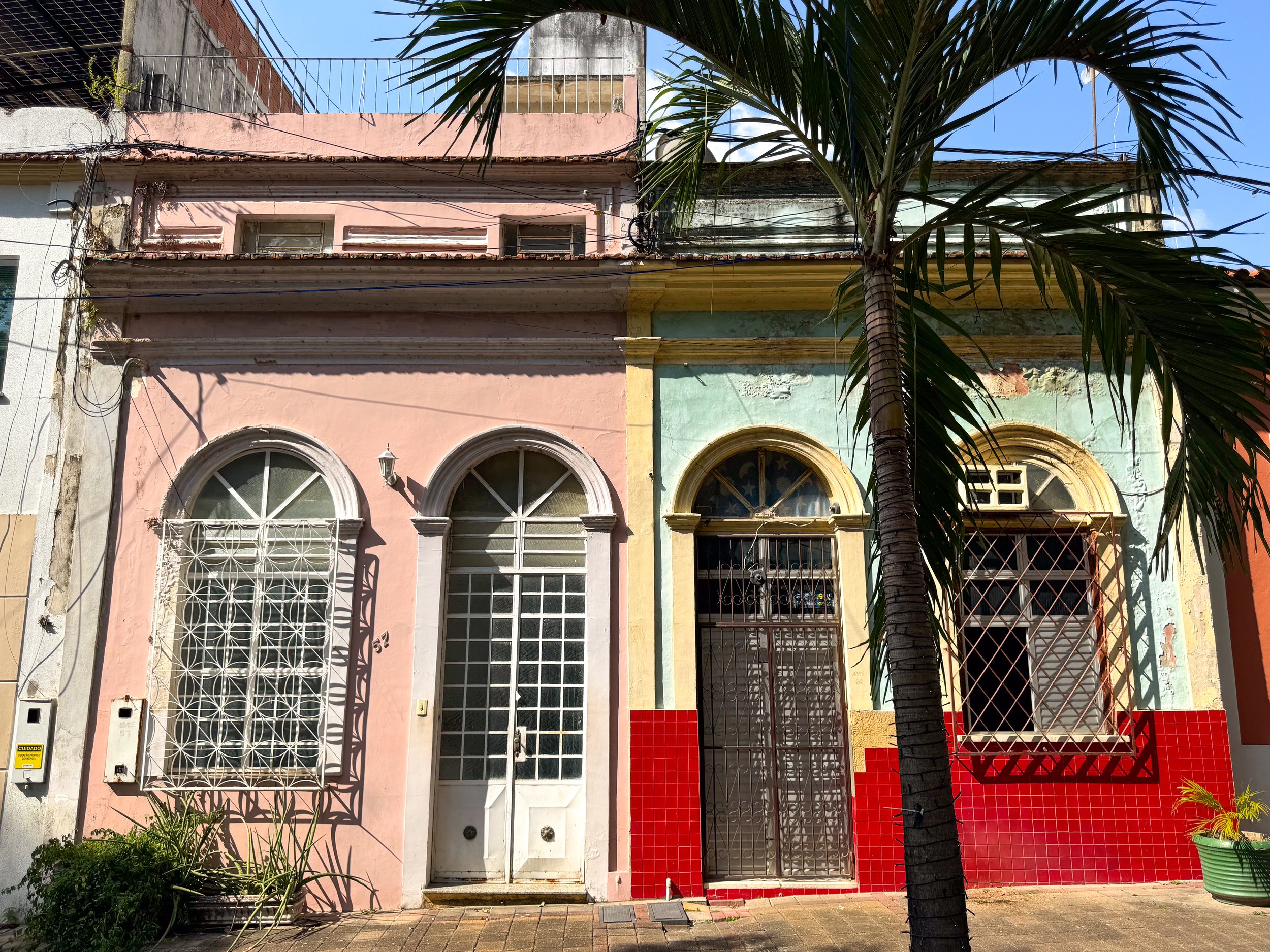
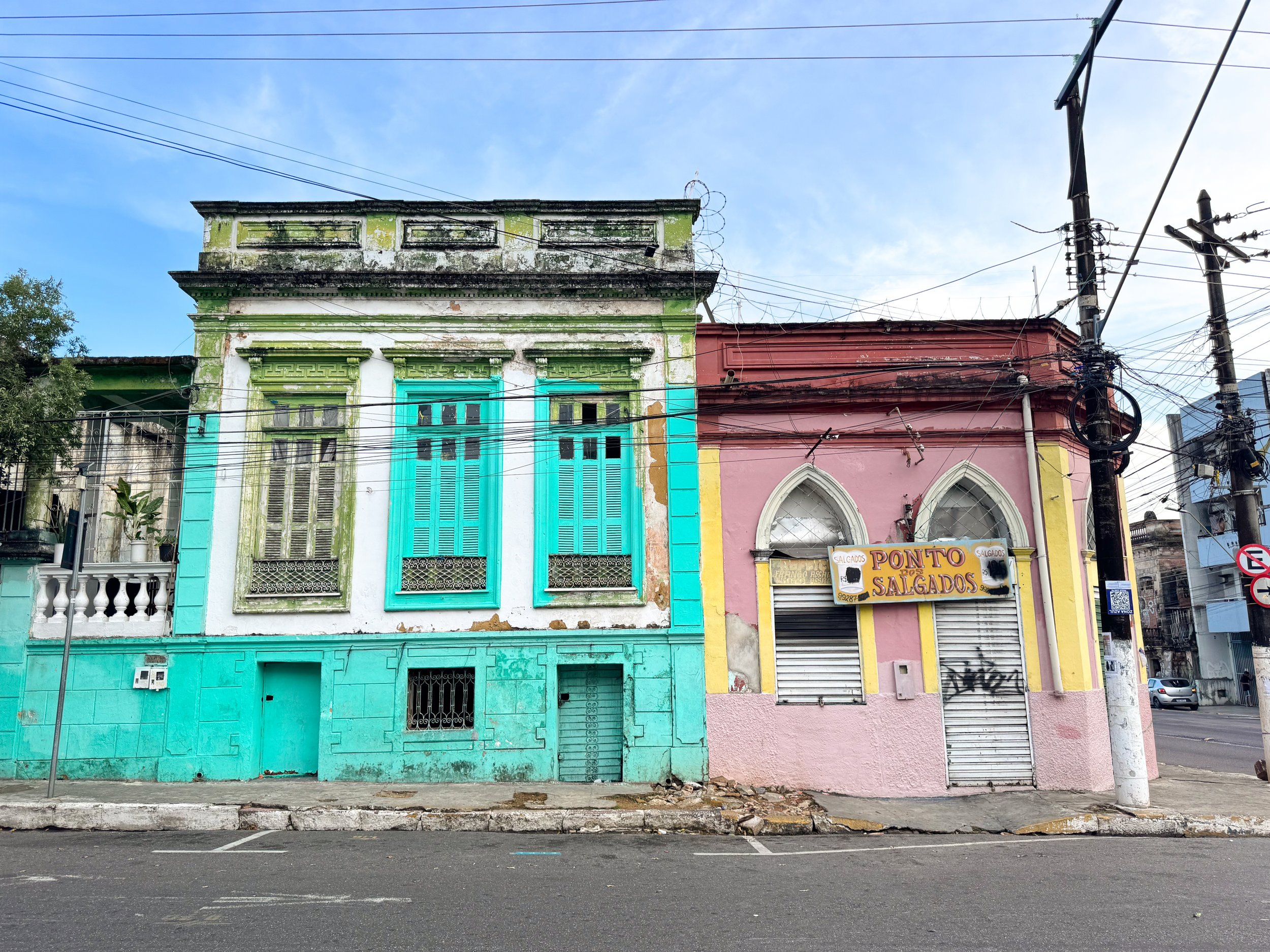
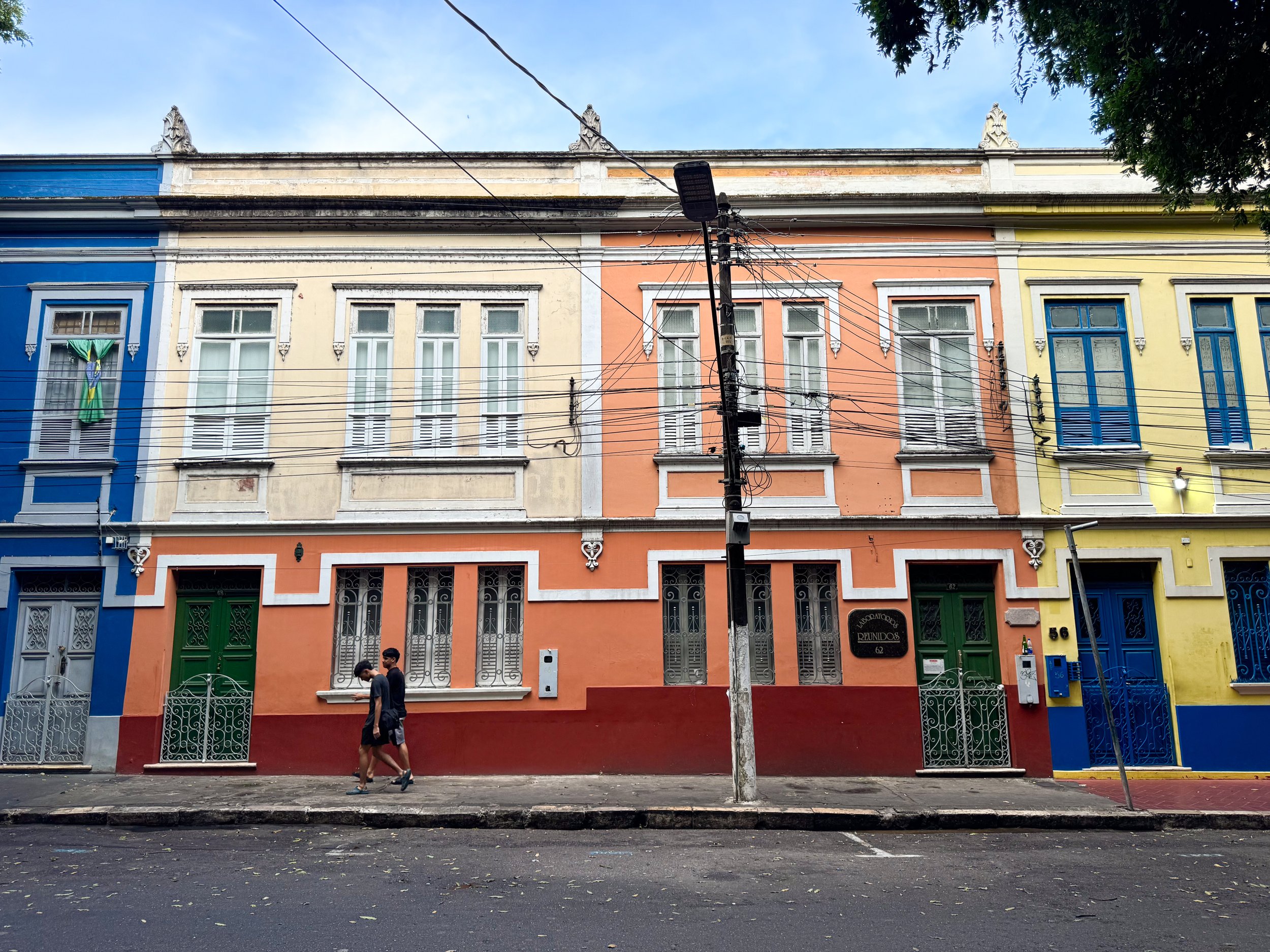
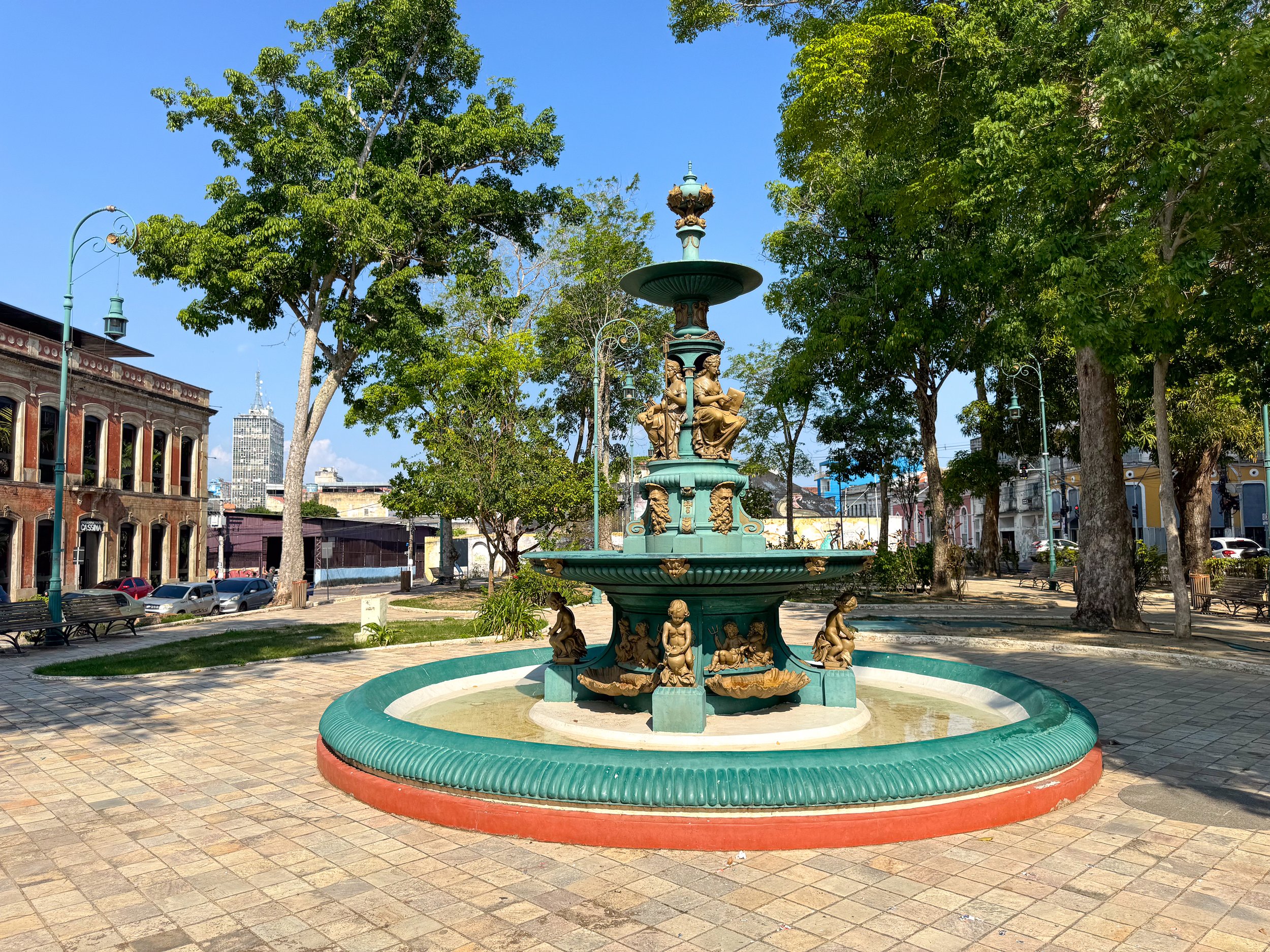
Sights
There are many sights to see around Manaus, especially in the city’s central neighborhood including historic landmarks, treelined plazas and indigenous themed murals. Across the city are nature parks, beaches and harbors overlooking the river.
El Centro. The historic neighborhood of Manaus with tree lined streets, pink stone roads, beautiful plazas, countless food carts, Amazonian restaurants and colorful Portuguese style architecture decorated with tiled facades.


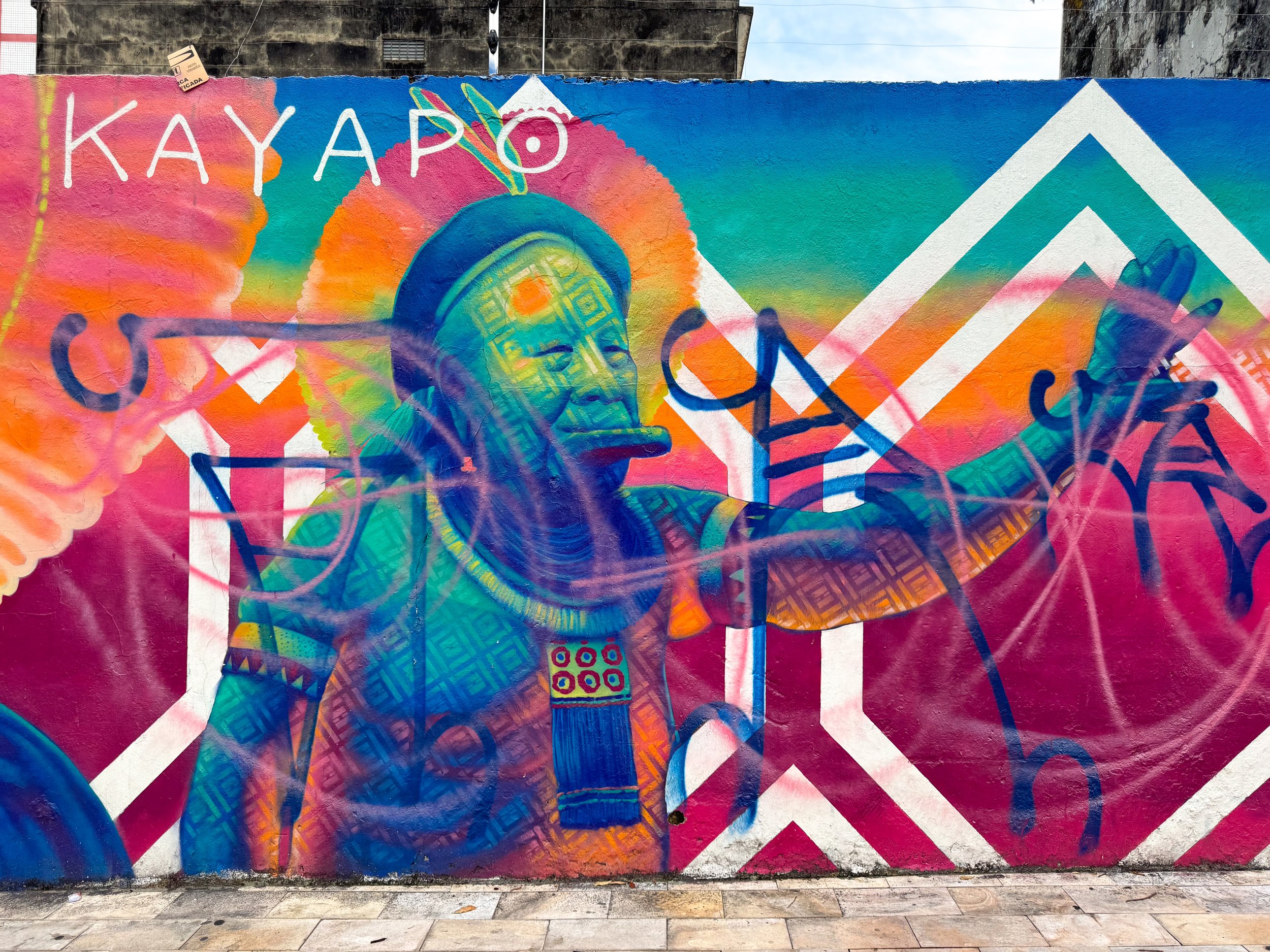

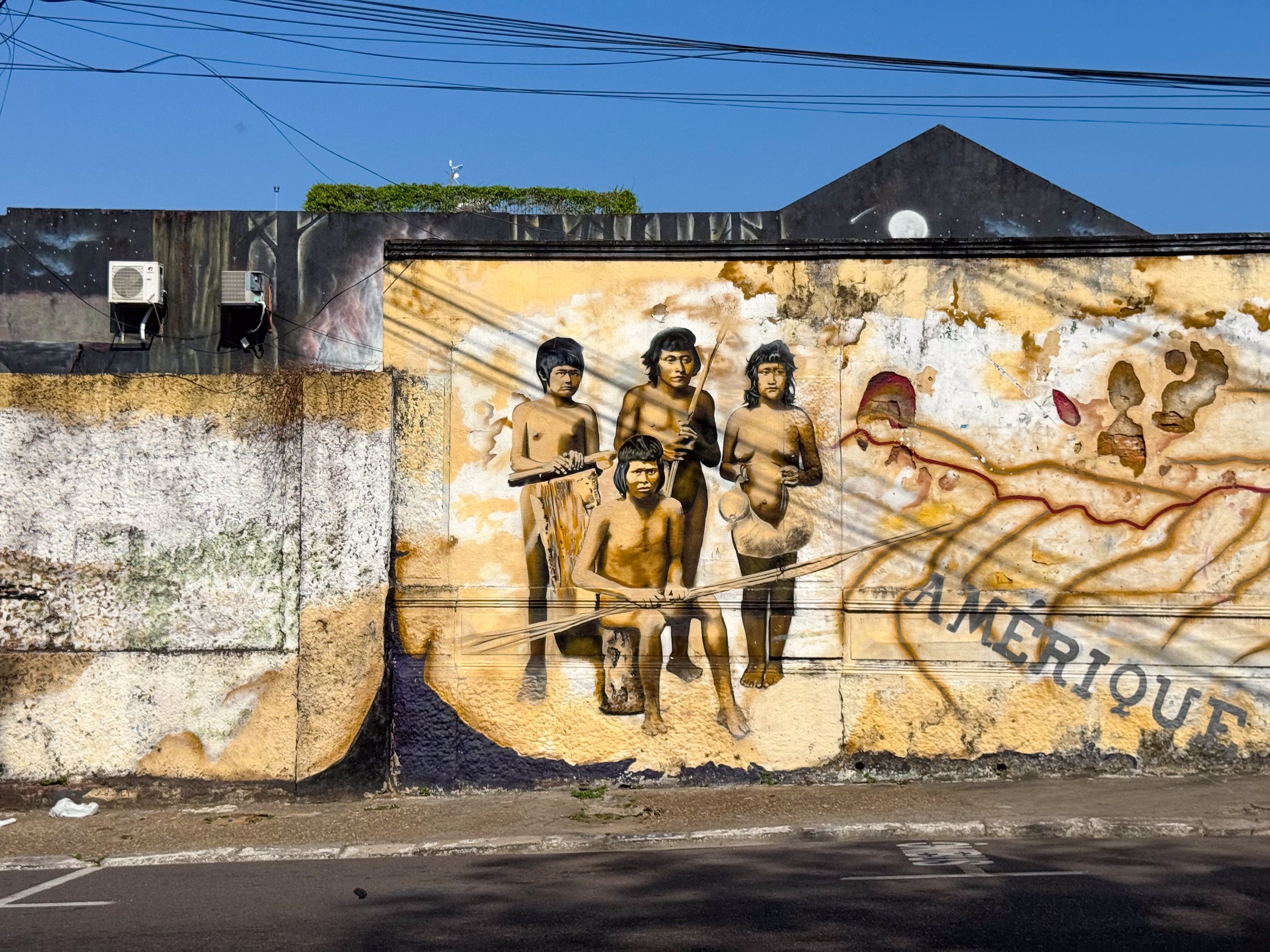
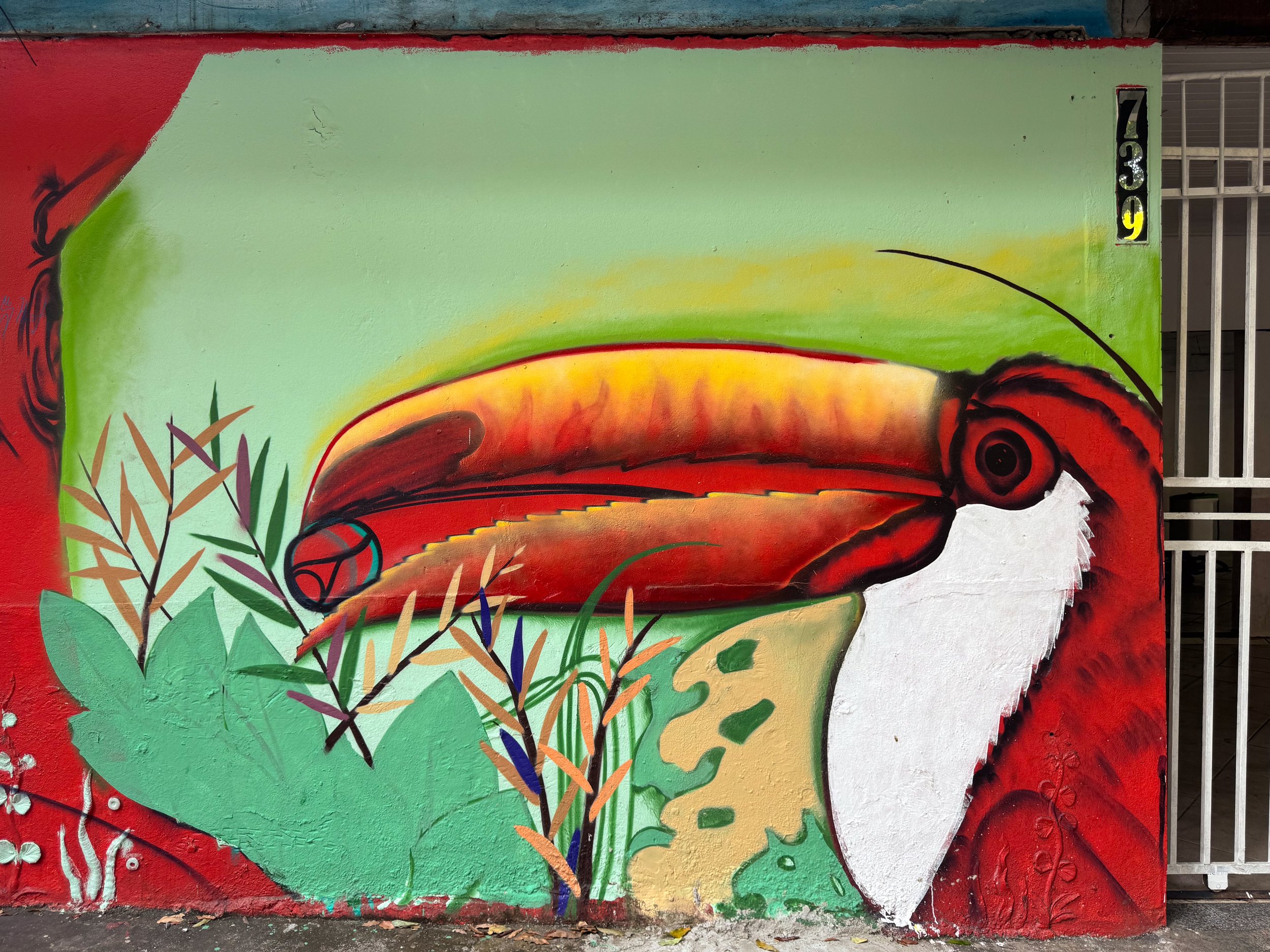

Indigenous Artwork. There is indigenous themed artwork and murals across the city, some spanning the height of entire skyscrapers. The best place to admire the art is around the streets of El Centro.
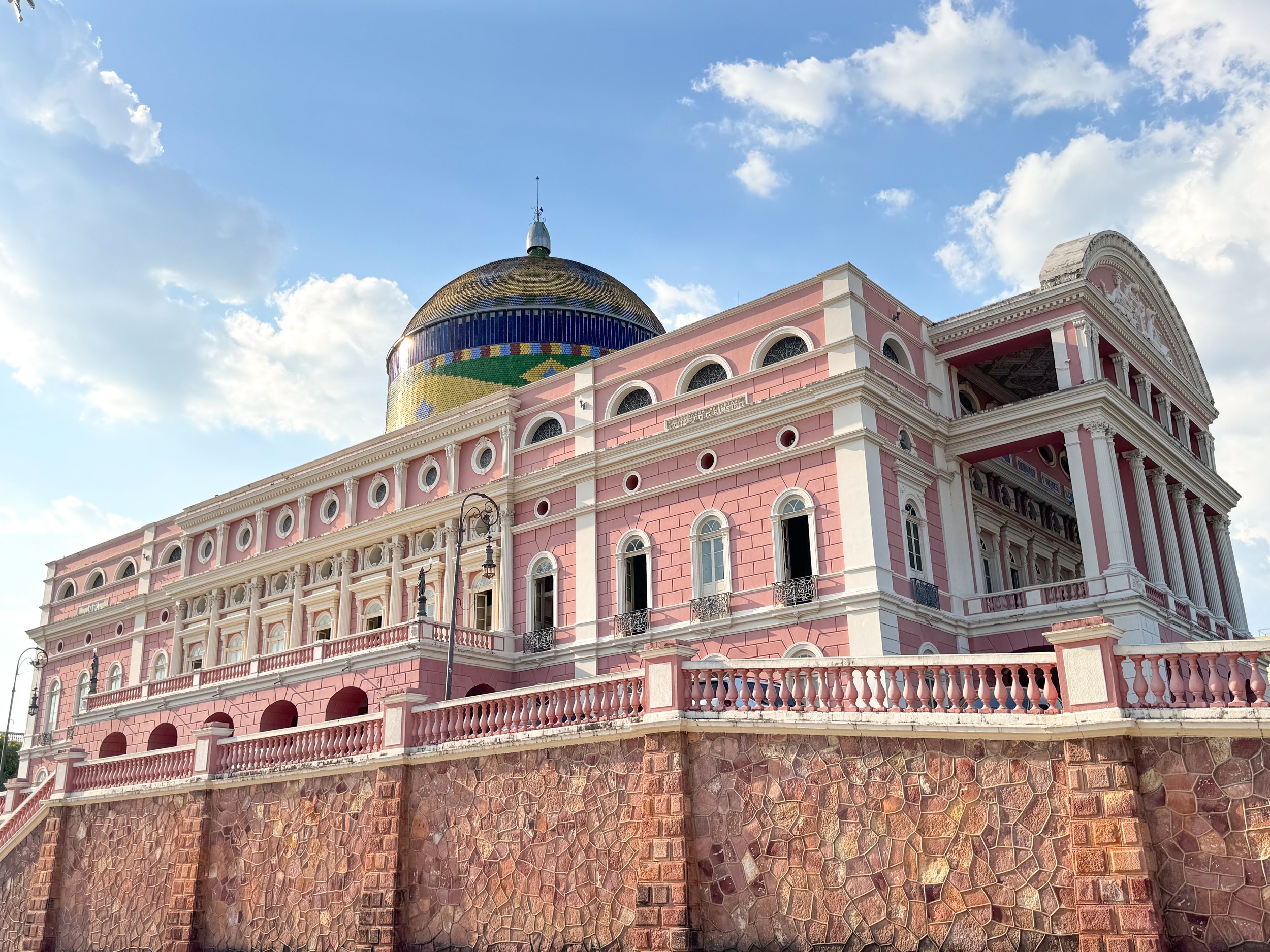
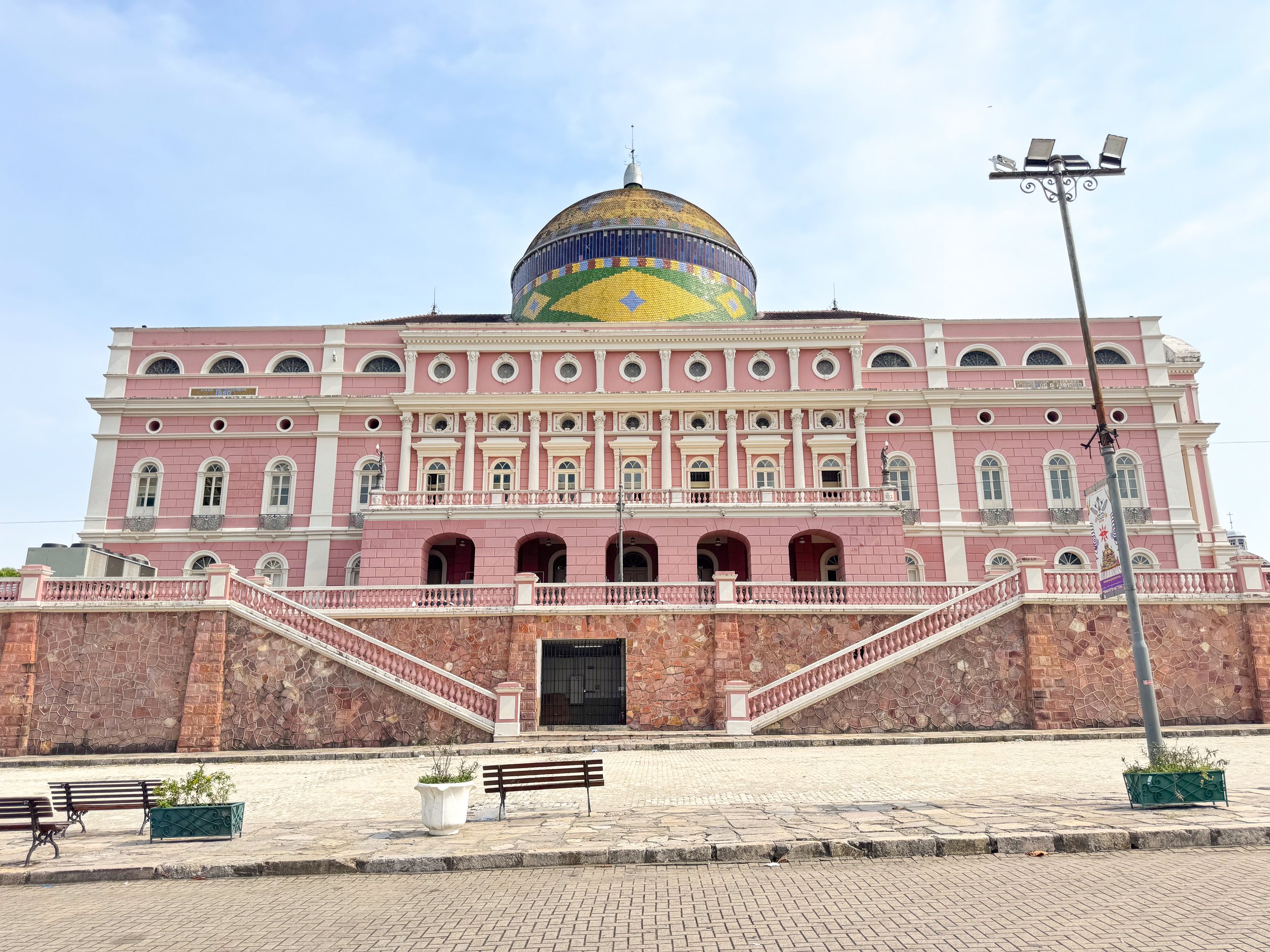


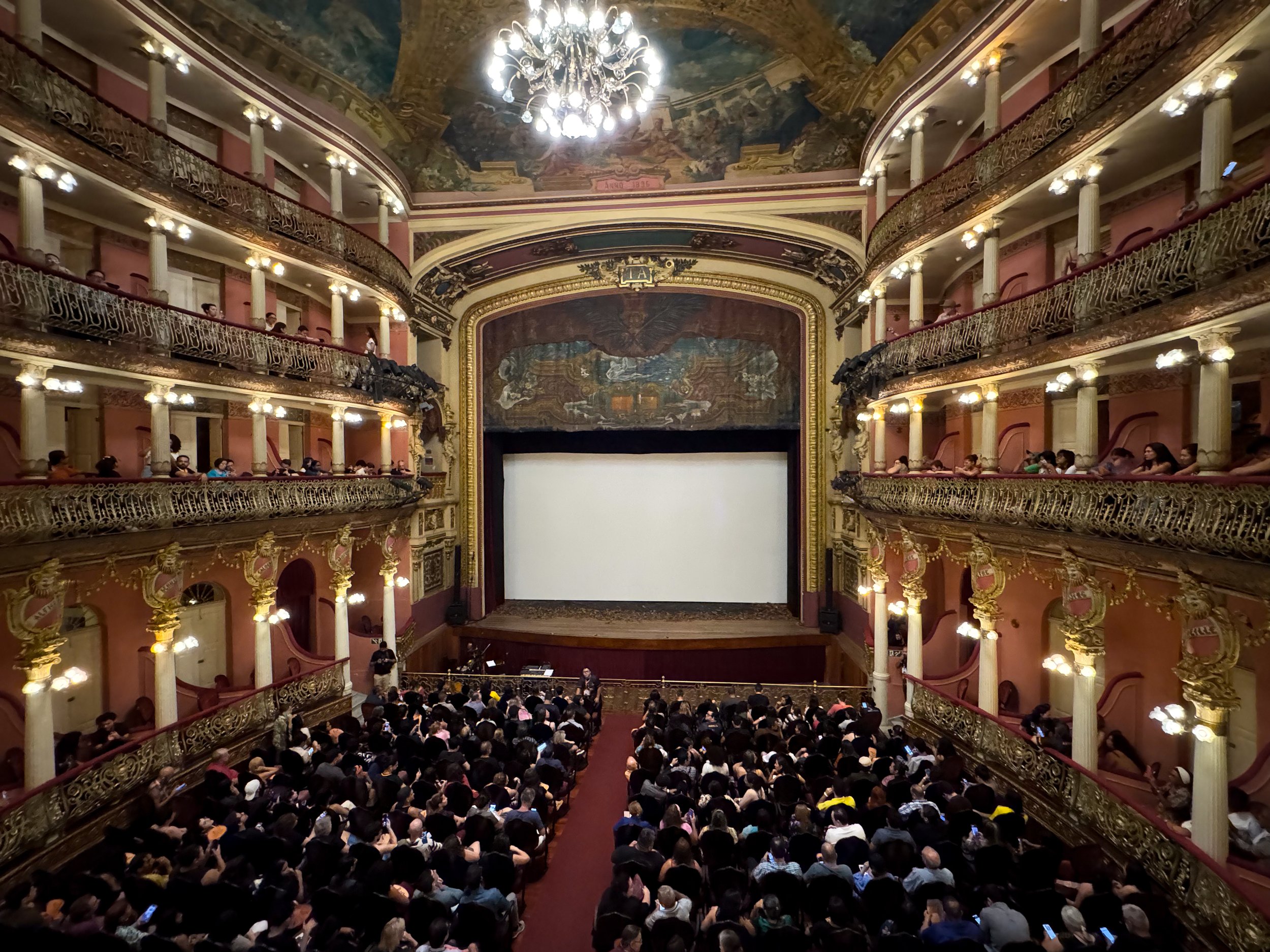
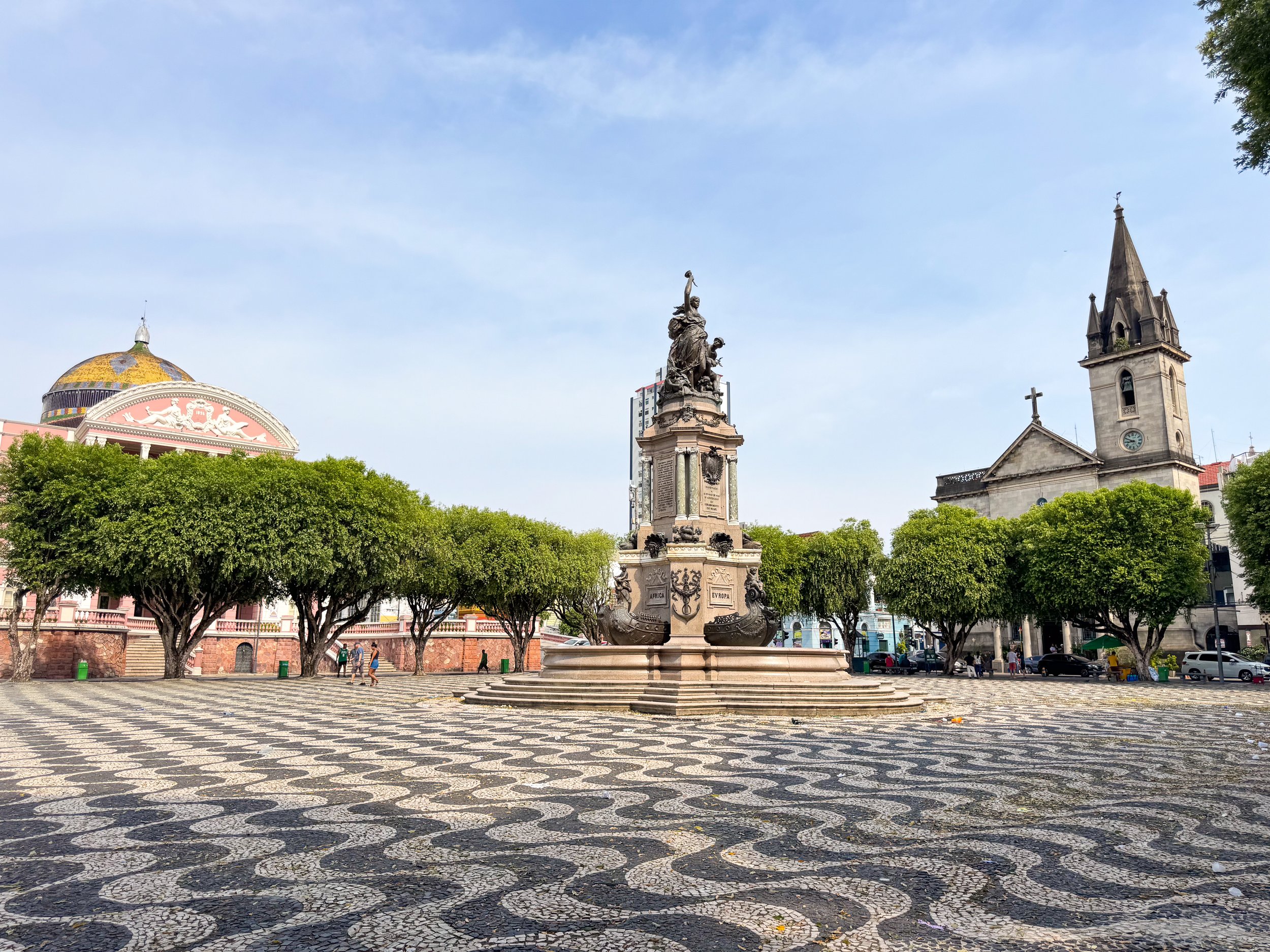

Amazon Theater. A grand and historic theater built from pink and white stones topped in with mosaic tiled dome featuring the Brazilian flag. The interior is elaborately designed with ornate details, velvet seats, warm lighting and multiple levels of opera boxes.
We visited during the Festival of the Theater of the Amazon and saw a free live performance dedicated to the women of the Amazon. The story spoke to the loss of tradition and indifference felt by many indigenous women through male control and westernization. We watched from an opera box with new friends we met in line.
Largo de Sao Sebastiao. A wavy black and white tiled plaza with a large nautical fountain at its center in front of the Amazon Theater. It’s lined with native trees home tropical birds. We saw a flock a macaws and parquets fly over, a reminder we were in the Amazon even within the city. The plaza is a hub for music and food! Surrounding restaurants serve Amazonian cuisine while vendors sell tacacá, açaí, cassava chips, popcorn and caipirinhas.
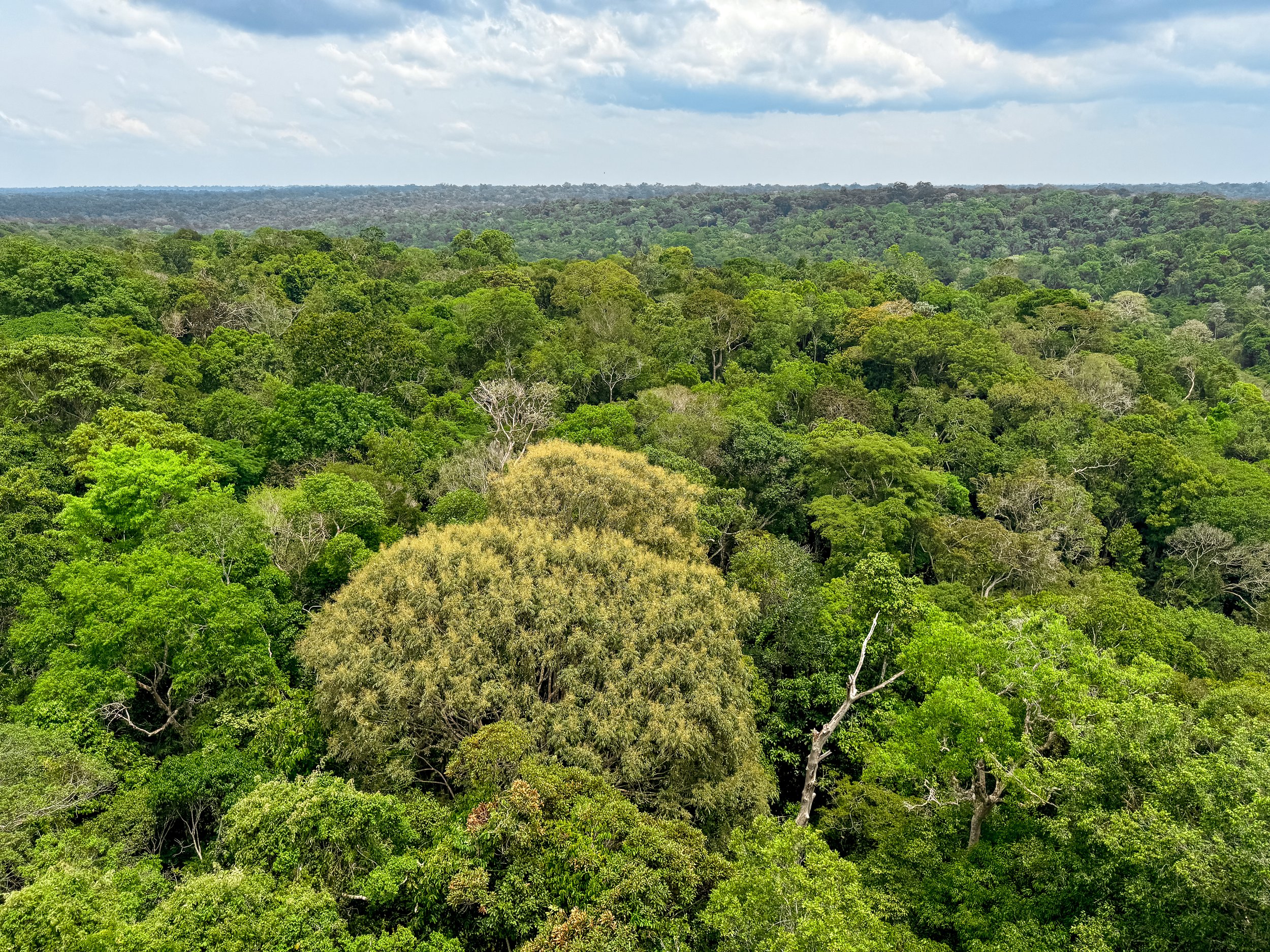
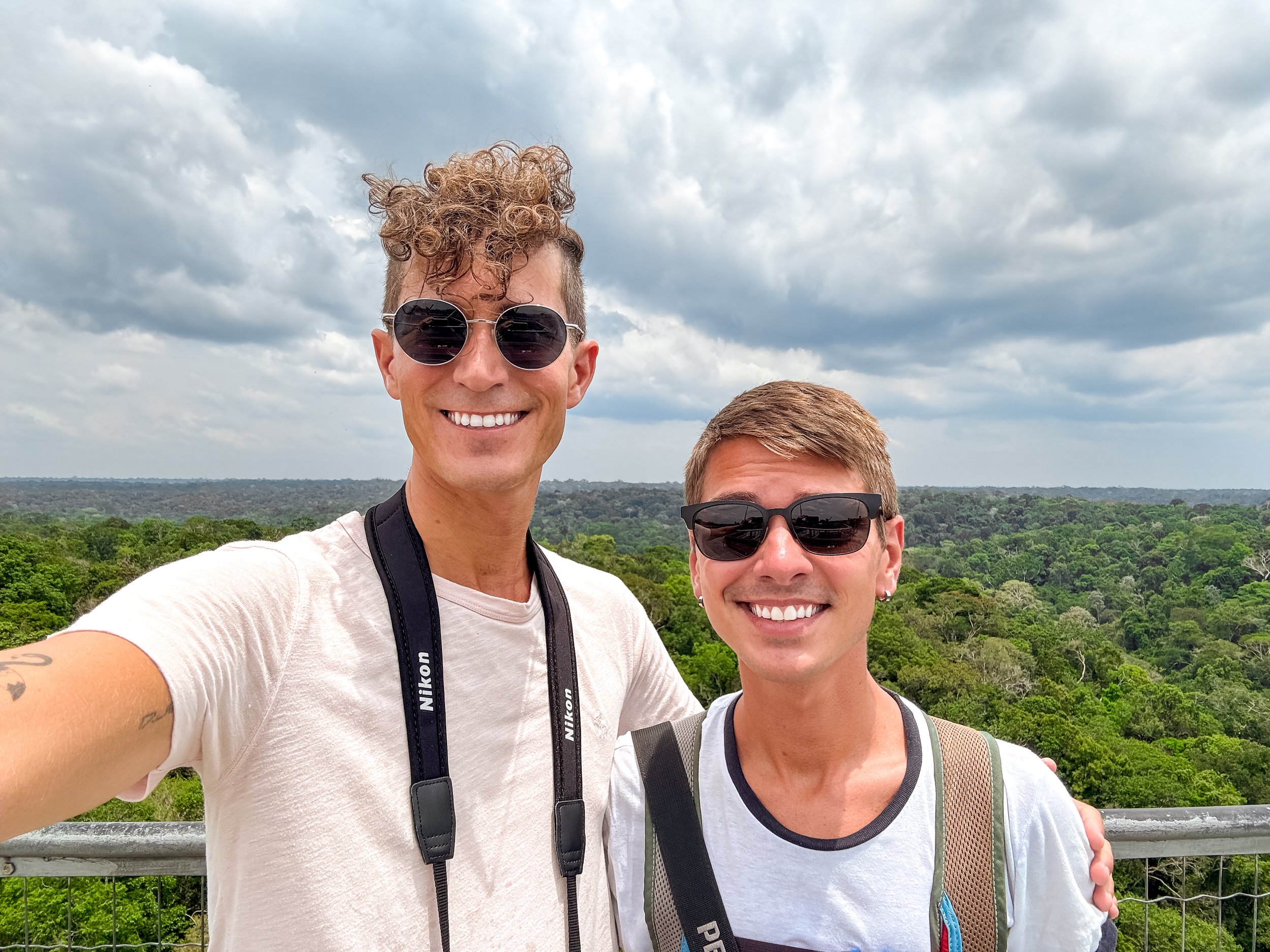

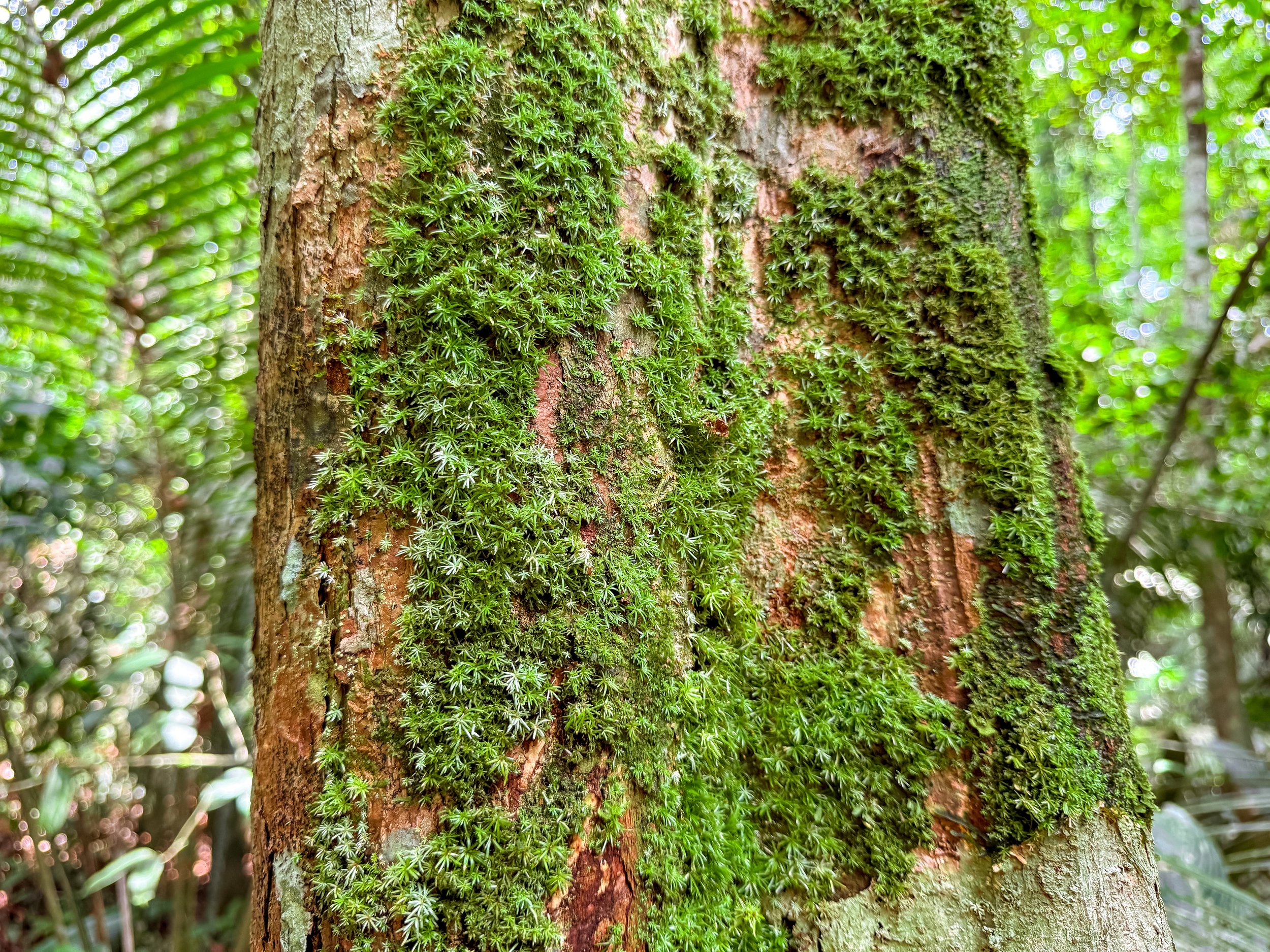
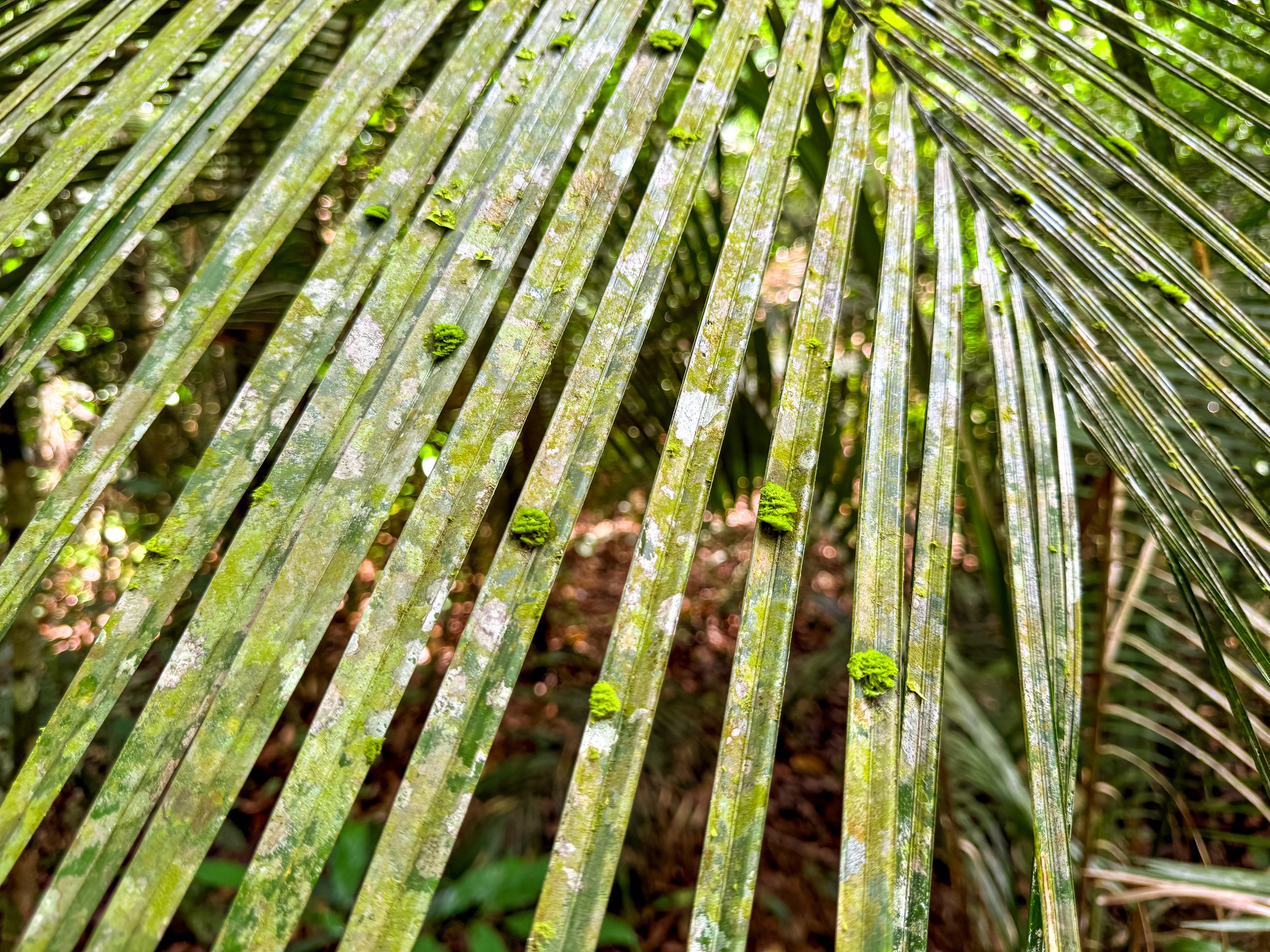
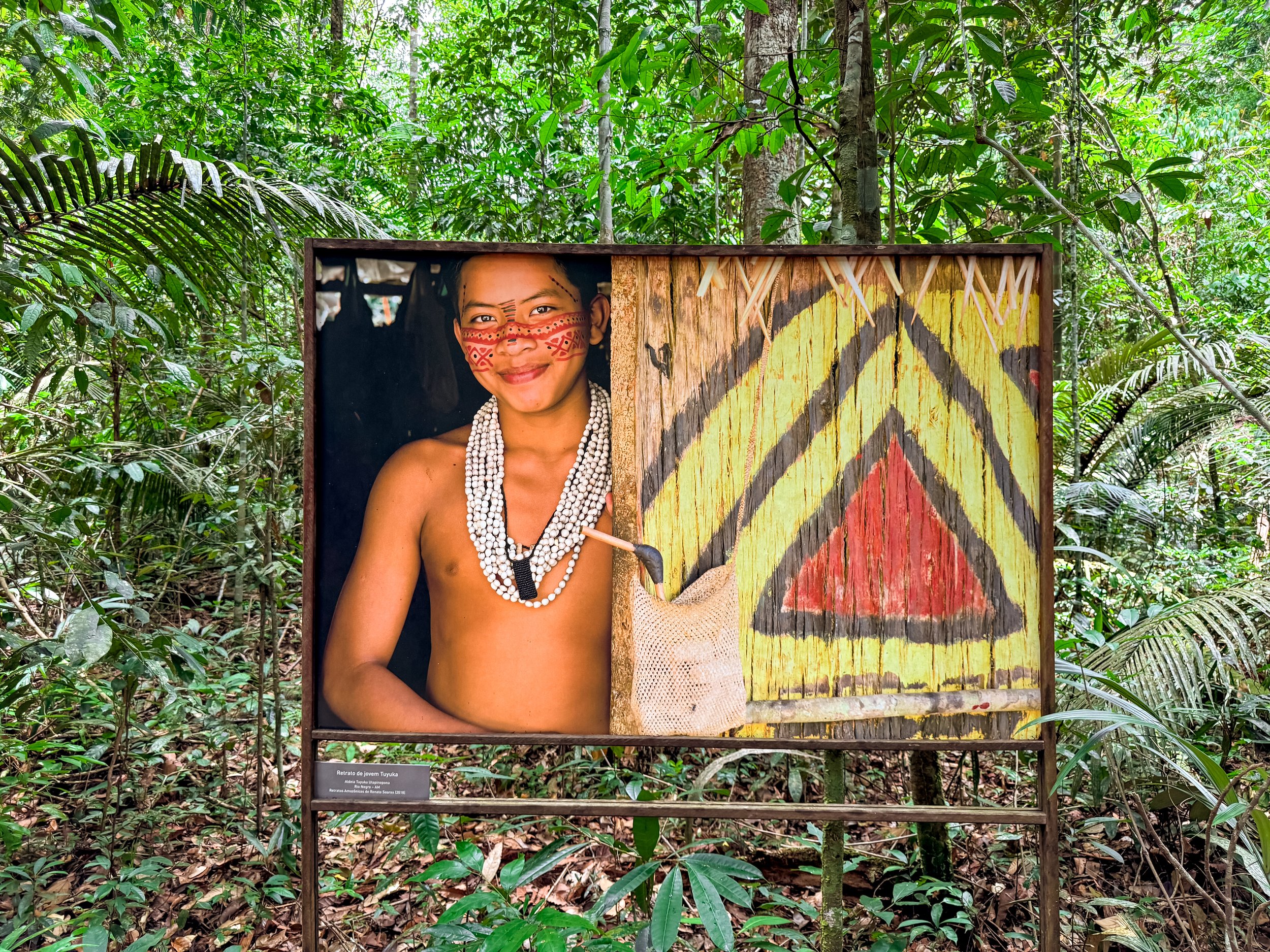
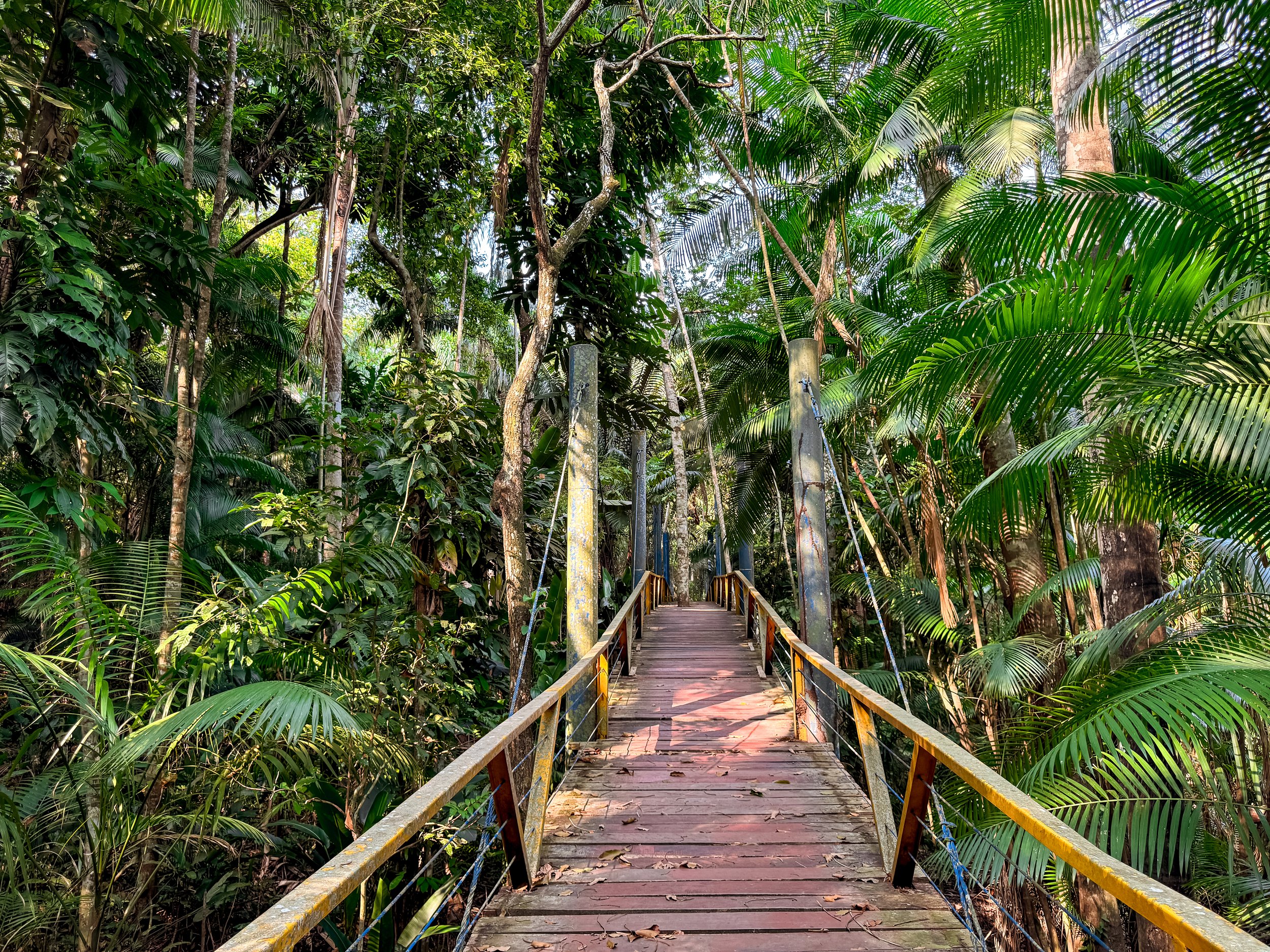


Museu da Amazonia (MUSA). A rainforest reserve at the edge of the city with nature trails through the jungle. Come here to overlook the treetop canopy and spot monkeys from the lookout tower, admire the indigenous photography lining the trails and visit exhibits and gardens with Amazonian species including palms, ferns, snakes, spiders, butterflies, cicadas and mushrooms. The park is located about 40-45min from El Centro by Uber or car. Ubers cost about $15 one way.
Parque do Mindu. A lesser maintained city park with nature trails, açaí palm trees, flocks of parquets, leaf cutter ants and many flying insects. We walked the trails while listening to the calls of birds including macaws, toucans and mocking birds. Wear plenty of insect repellant when visiting.
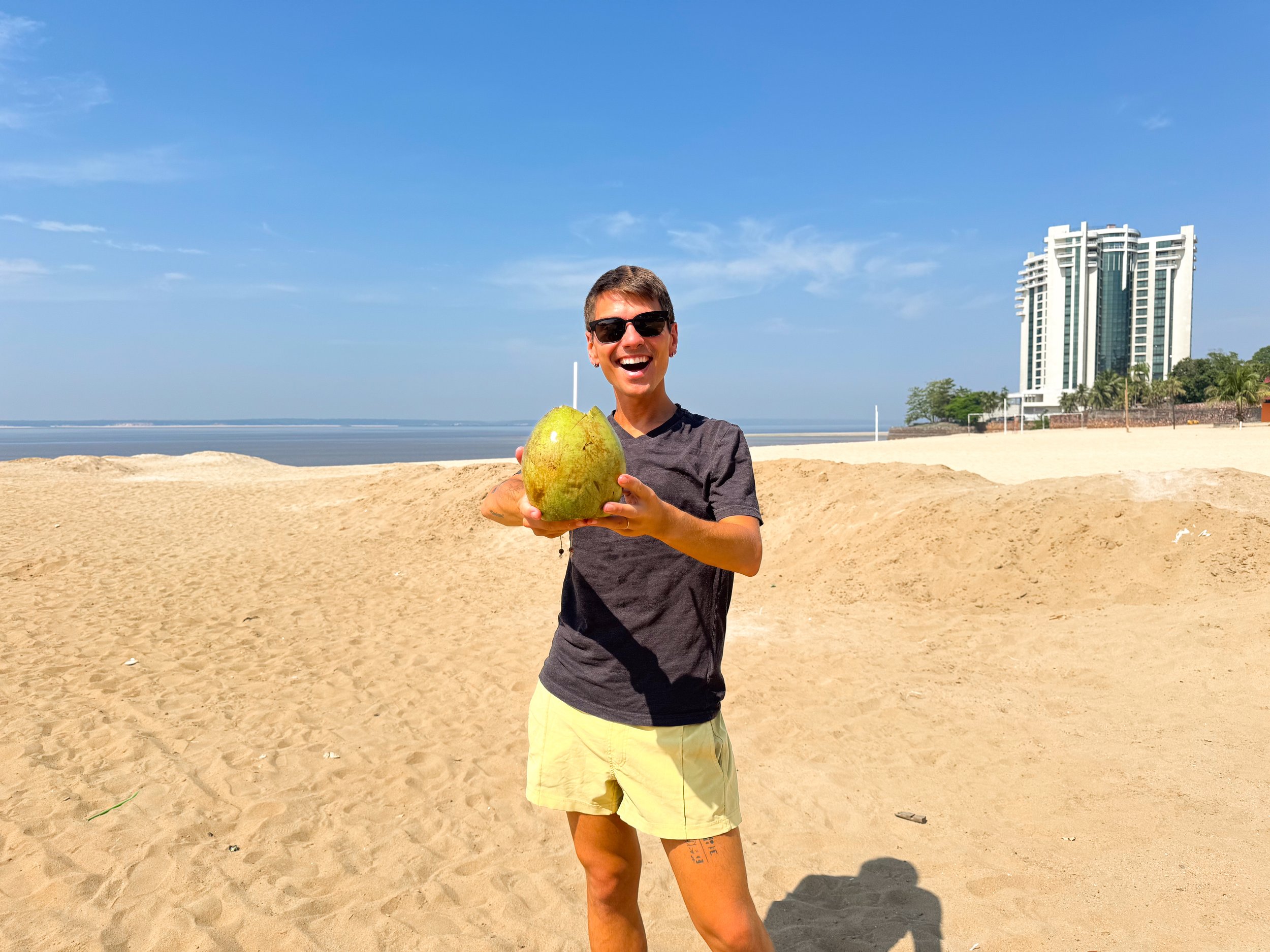
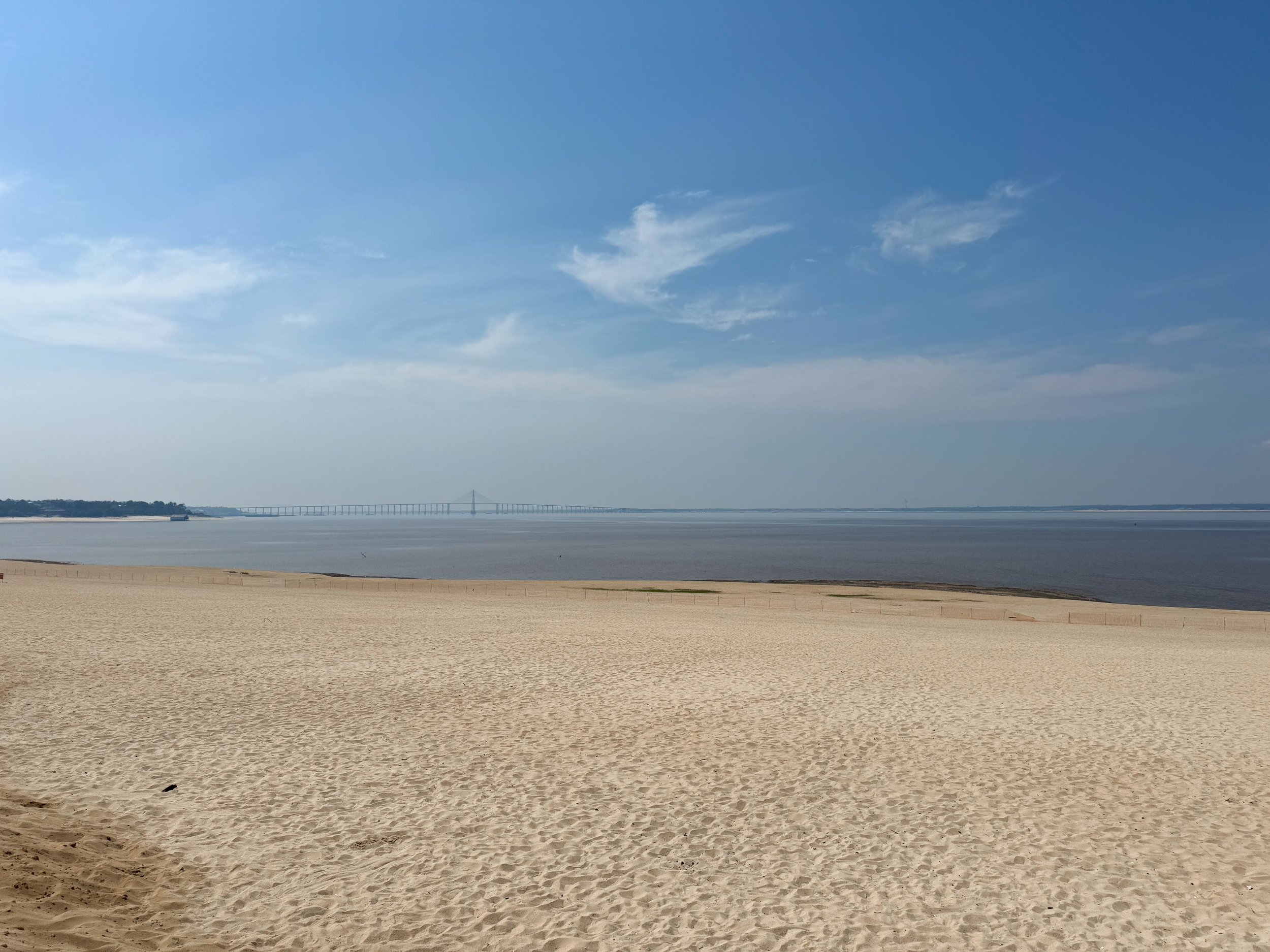
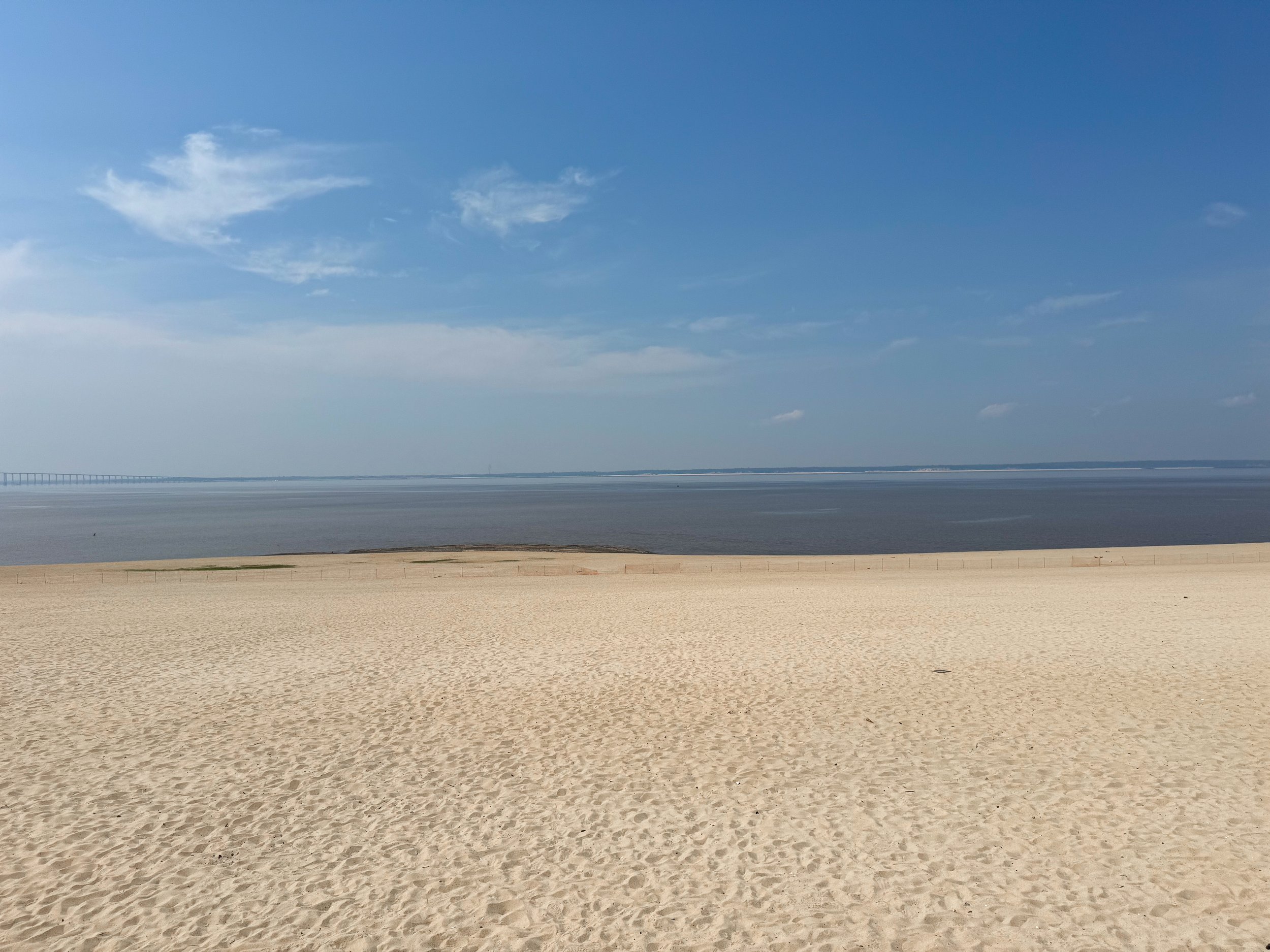
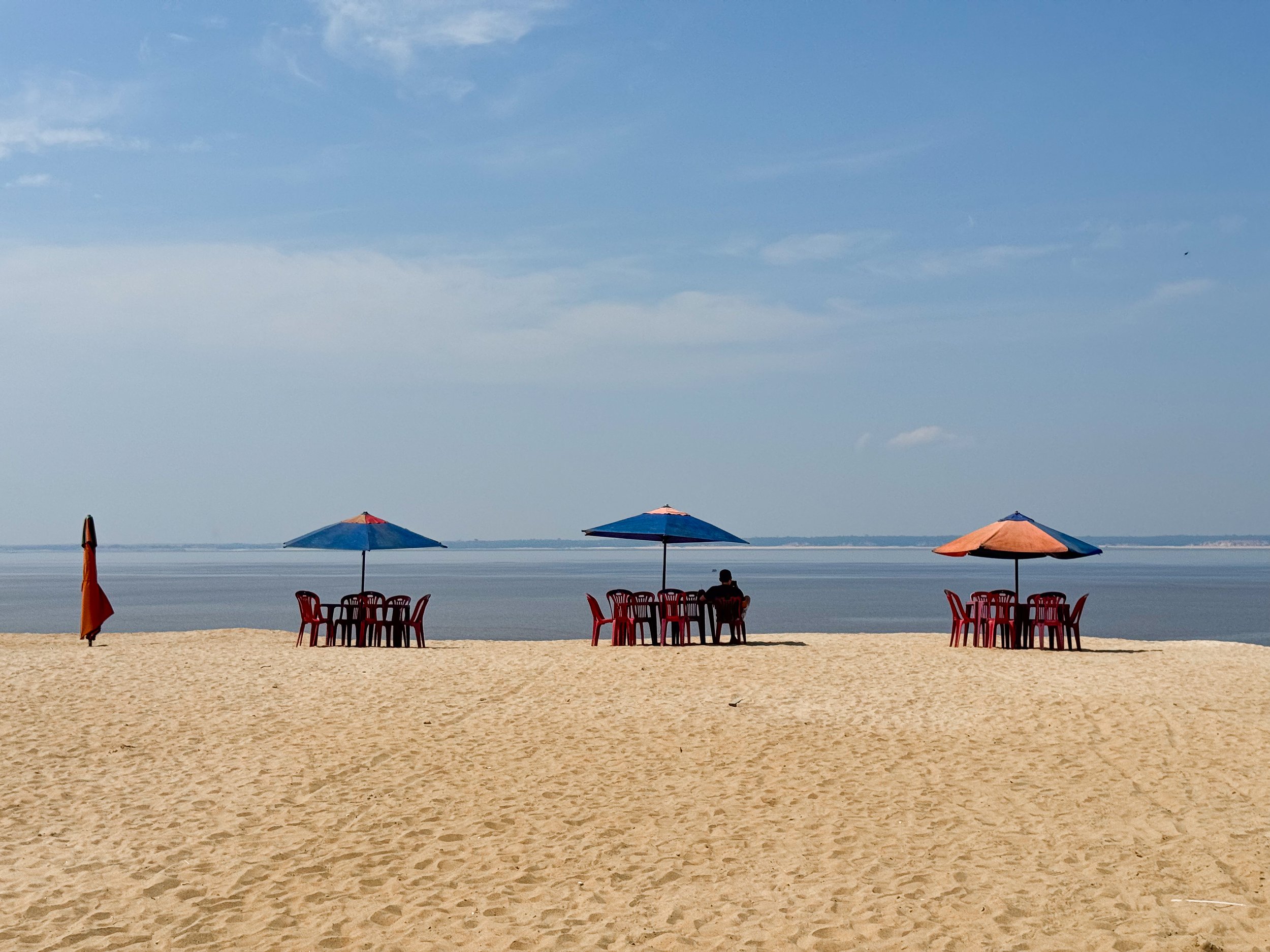
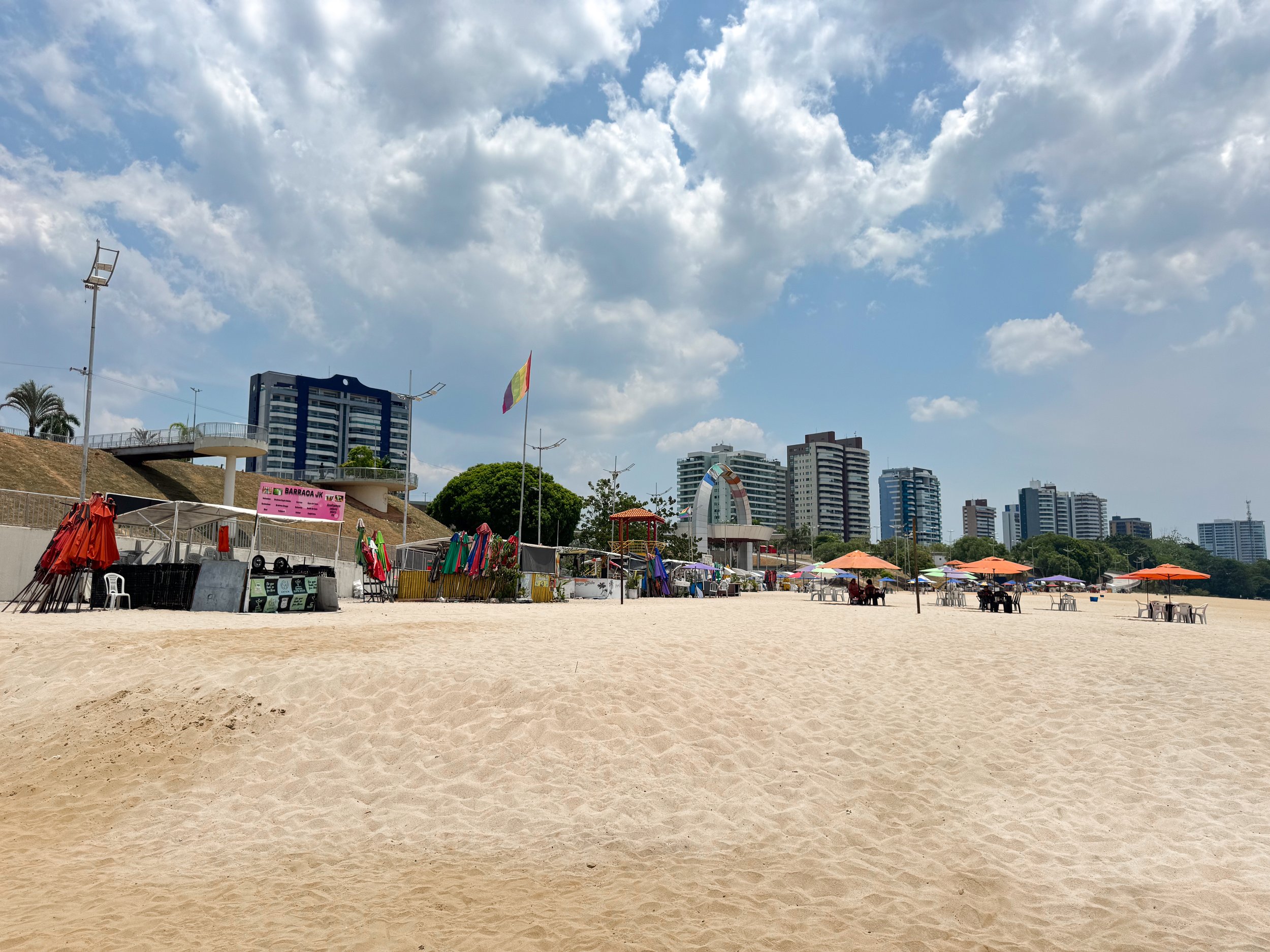
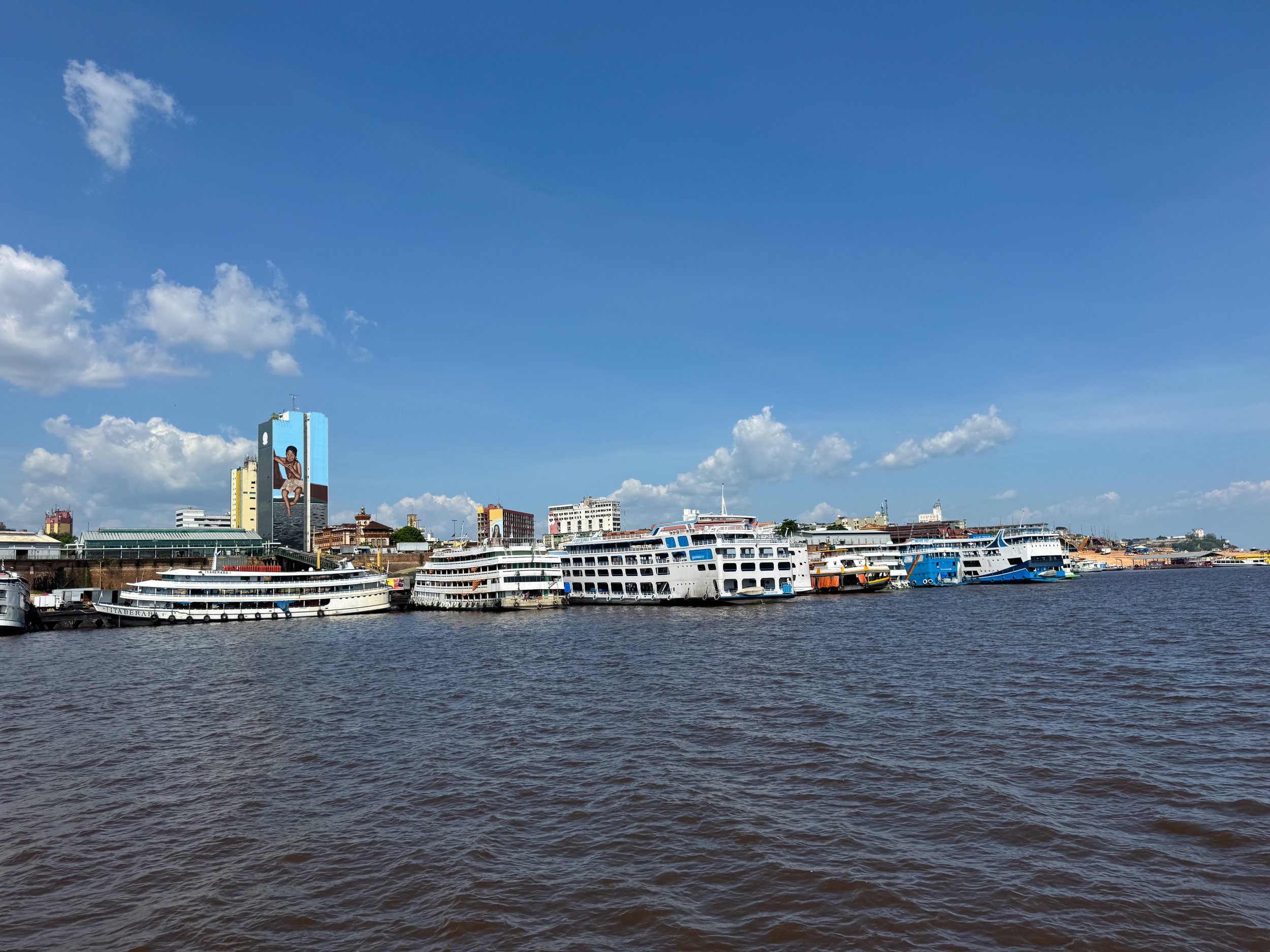
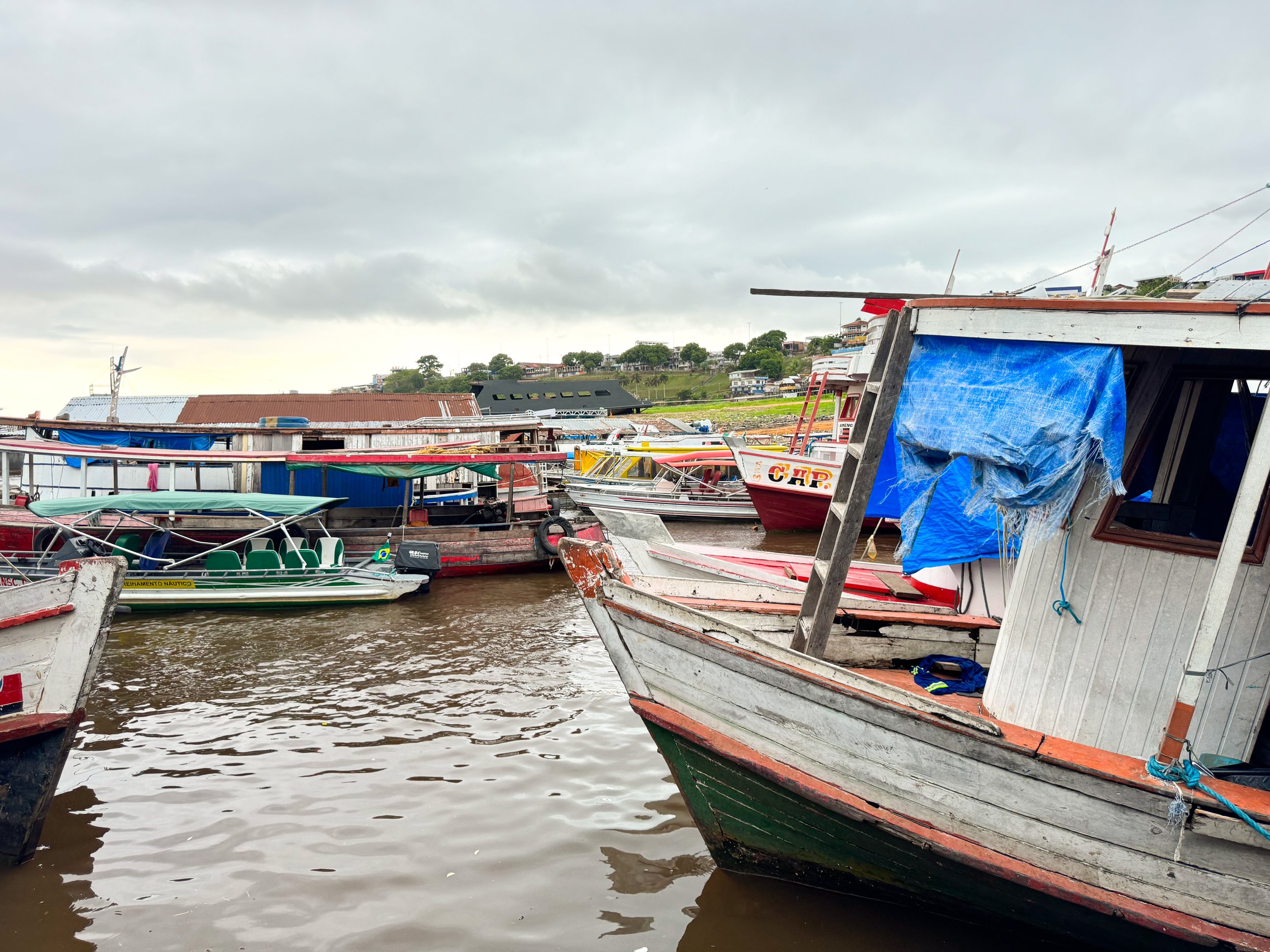
Praia de Ponta Negra Beach. A large sandy beach on the Rio Negro with a treelined promenade, volleyball courts, an amphitheater and Barracas, food vendors in beach tents. We bought fresh coconuts to hydrate and açaí sorbet to cool down. There is no shade on the beach however the Barracas also offer chair and umbrella rentals. People often come here to swim, however when we visited, swimming was banned due to the record drought. The beach is a 20 min Uber ride from El Centro.
Manaus Harbor. The harbor is the transport and shipping hub for Manaus and the Amazon region. Many tours and cruises leave from here. When we visited, the water level was so low due to the record drought that the Brazilian government had to begin dredging the harbor.
Mirante. A multi-floor complex and port for Amazon cruises with restaurants, cafes, bars, a lookout over the Rio Negro and indigenous themed artwork.
Where to Eat & Drink
One of the best ways to try Amazonian cuisine is by eating at local restaurants in Manaus, trying the street food and exploring the markets.
Tambaqui de Banda. A restaurant in Largo de São Sebastião that specializes in Amazon fish like the restaurant’s namesake, tambaqui. We ordered the fried tambaqui costela, barbecued pirarucu and shrimp vatapa with sides of farinha. The bar offers specialty cocktails and juices made from Amazonian fruits and Cachaça. Our favorite was the Todo de Amazon, made with açaí, capuaçu foam and guaraná grated using a dried pirarucu tongue. Stick around for happy hour for half off caipirinhas, discounted snacks and live music.
Biatuwi. A restaurant specializing in Amazonian dishes traditionally prepared by indigenous tribes. We ordered the tambaqui costela cooked in a cocoa leaf, toasted Saúva and Maniwara ants, and Aluá, a fermented pineapple drink similar to kombucha. All dishes and drinks came out in calabash bowls resting on a ring of dried açaí seeds.
Coreto dos Manaós. A restaurant at the Mercado Municipal Adolpho Lisboa with a lush shaded garden. We came here for breakfast to try Tapioquena. We ordered two, one stuffed with tacumã and banana, the other with egg and cheese.
Tacacá da Gisela. A popular soup stand specializing in Tacacá located in Largo de São Sebastião.
Açaí do Largo. An açaí stand specializing in “Creme de Cupuaçu with Açaí” located in Largo de São Sebastião.
Sorveteria Glacial - Self Service (Loja 1). A self service ice cream shop that sells by weight. Come here for exotic flavors only found in the Amazon including fruits and nuts like, Açaí, Castanha do Brazil (Brazil nut), Maracujá (passion fruit), Cupuaçu, Tapereba and Doce de Leite.

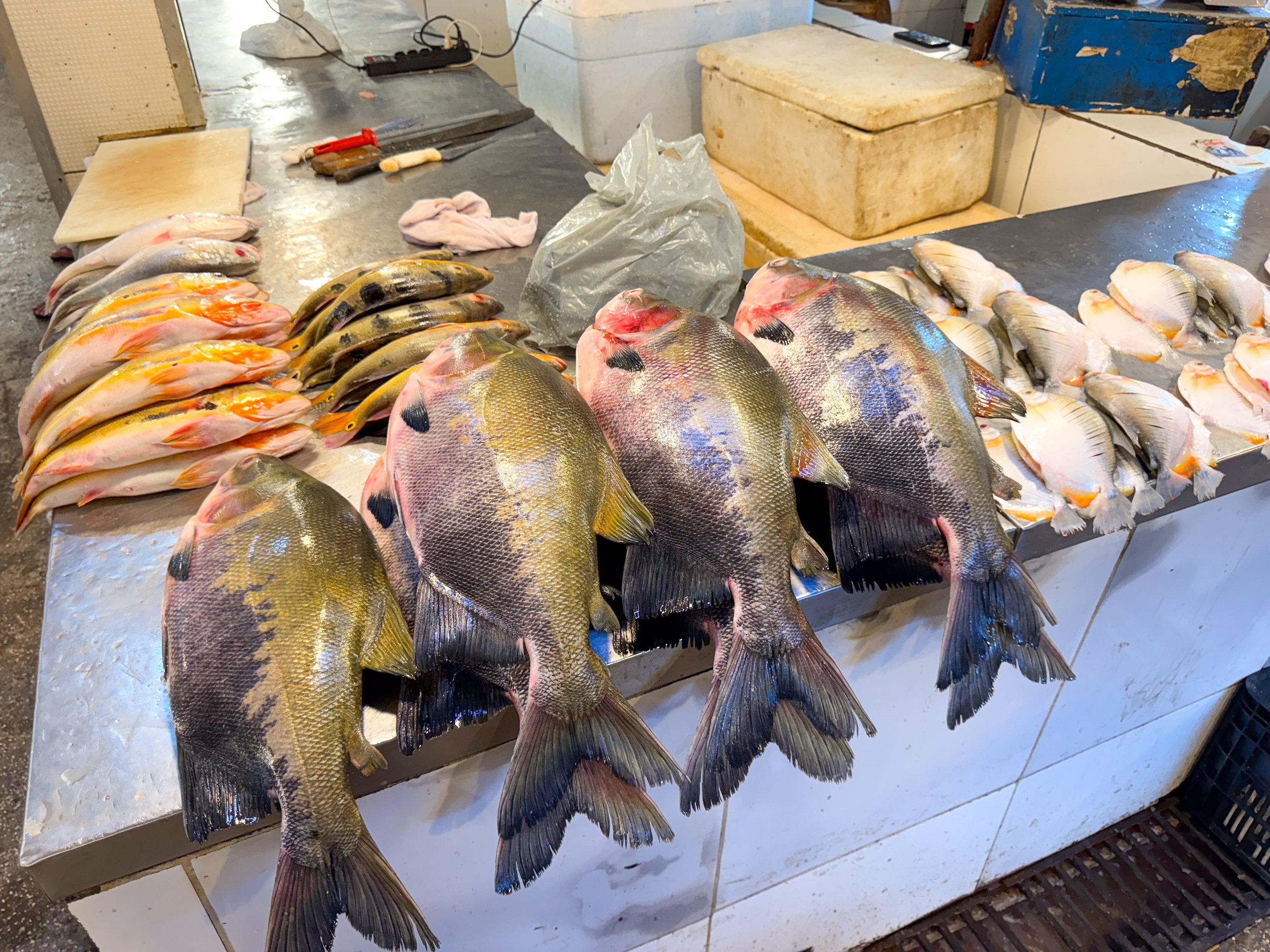

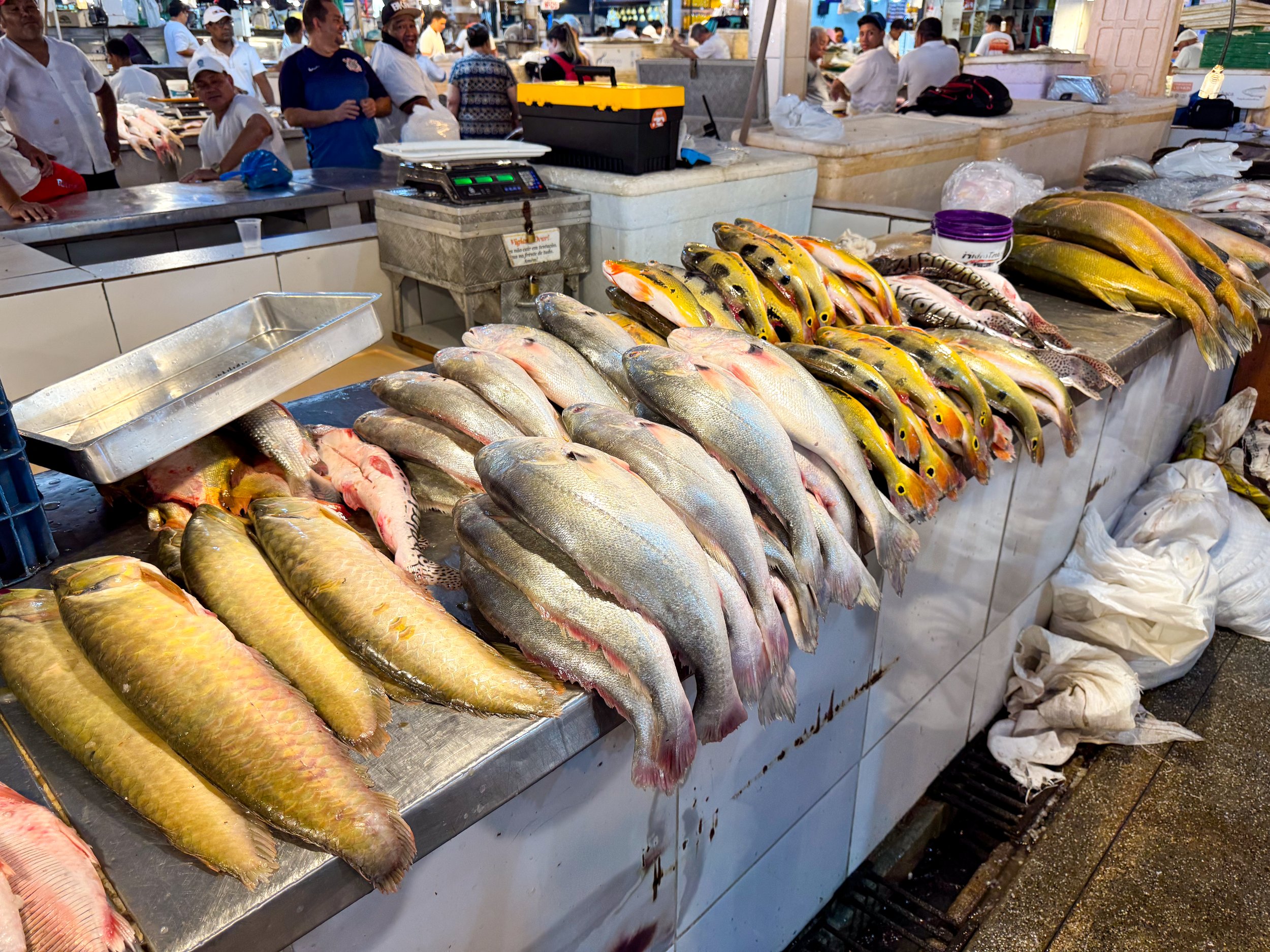
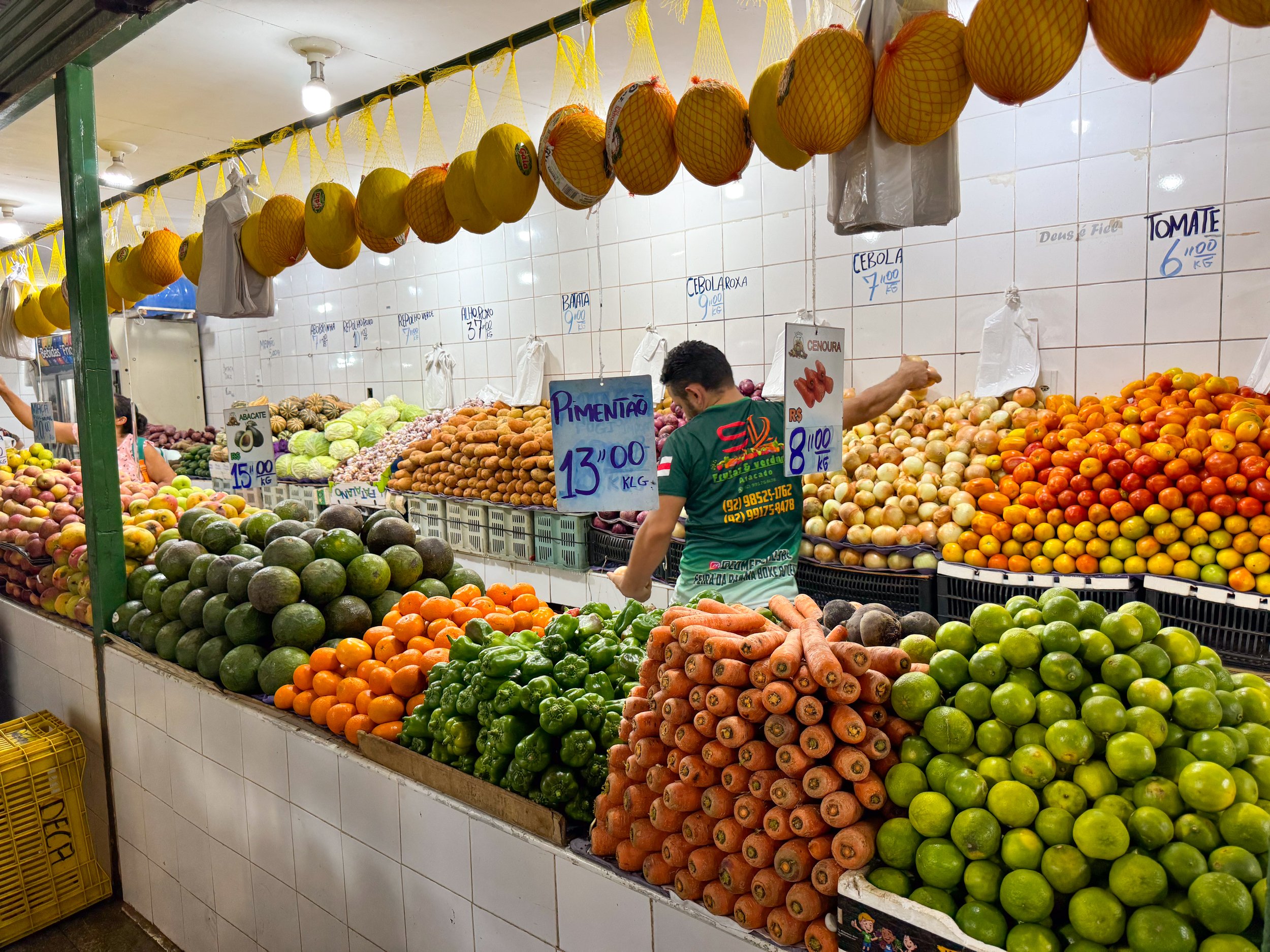
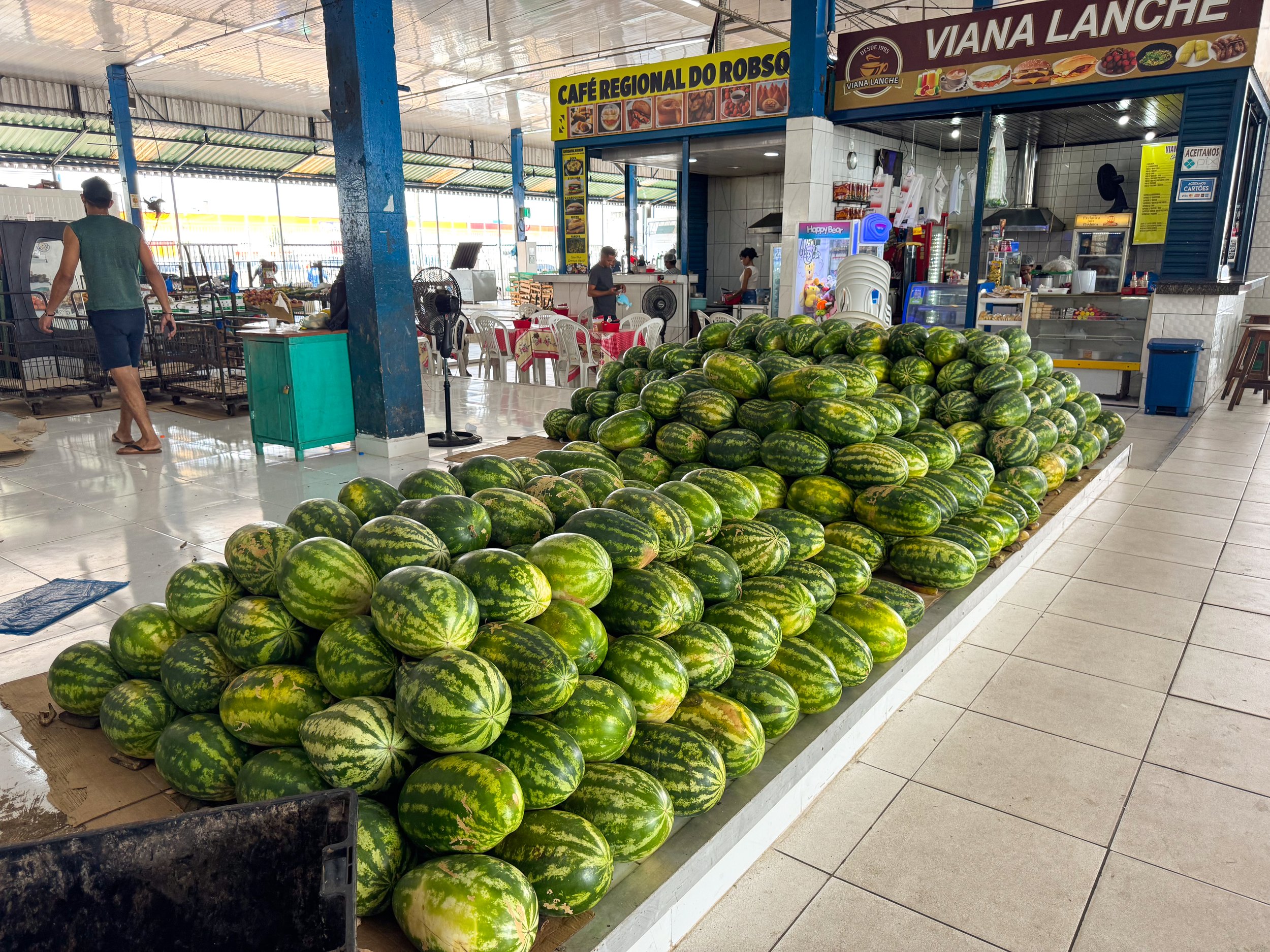
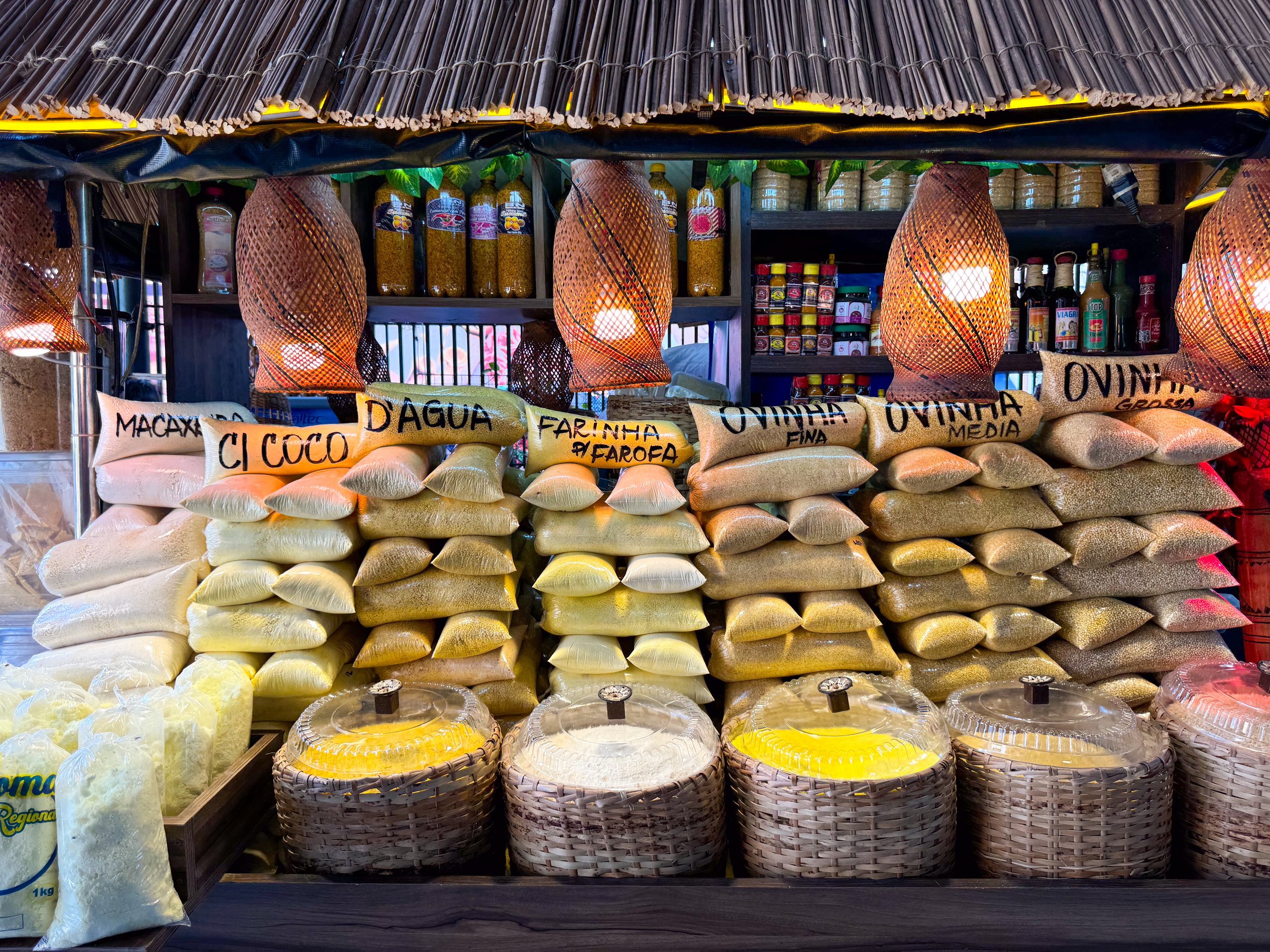
Markets
Manaus is well known across the Amazon region for its food markets, especially when it comes to Amazonian fish.
Feira Manaus Moderna. A massive and bustling food market with aisles of hundreds of vendors selling fish, meats, produce, fruit, cheese and grains. Freshly caught Amazonian fish are delivered directly from the outside pier to fish mongers sharpening knives and preparing them for consumption. Tables are covered in all manner of fish including Tambaqui, Pirarucu, Red Bellied Piranha, Peacock Bass and Spotted Catfish. Elsewhere outside the market, merchants sell fishing supplies including nets, hooks and coolers.
Feira Moderna da Banana de Manaus. A large fruit market under a shed with vendors selling bunches of plantains, crates of bananas, fresh juices, sacs of oranges, crates of mangos, piles of water melons and tables covered in papayas, pineapples and limes.
Mercado Municipal Adolpho Lisboa. A historic wrought iron market with restaurants and cafes, Amazonian crafts, meat and fish vendors and medicinal goods including oils, herbs & natural supplements.
Getting Around
By Uber. We took Ubers to get around the city. They are extremely affordable, costing $2 - $5 to get around the city and $10 to/from the airport to the city center.
On Foot. The El Centro neighborhood of the city is walkable.
Good to Know
Safety. It’s smart to be aware of your surroundings. The city has pockets of doggy areas, even around the El Centro neighborhood.
Language. Portuguese is the national language of Brazil. Very few people speak English. We got by on some basic Portuguese phrases and words combined with some Spanish and Google Translate.
LGBTQ+ We felt safe and welcomed as a gay couple in Manaus, especially in the El Centro neighborhood. We saw many queer people from across the spectrum, progress flags and even befriended another gay visiting from São Paulo.
Temperature. We visited during the dry season. Temperatures reached a peak of 102 Fahrenheit! We avoided the heat when possible and drank between 2-3 liters of water per day to stay hydrated.
Drinking Water. It’s not recommended to drink the tap water in Manaus. It should be filtered or boiled before consumption.
Wear Sunblock. During the dry season, the UV was often very high. Sunblock and umbrellas were necessary to prevent sunburns.
Insects. It’s the Amazon; there are insects and mosquitos anywhere near water and in the forest. Insect repellant and mosquito nets are necessary to reduce bites.
Vaccinations. We took malaria pills daily while visiting the Amazon as well as received the Yellow Fever vaccine prior to traveling.
Climate Change
The Amazon is directly affected by climate change through pollution, deforestation and drought. This was evident during our time in Manaus as we toured the region, spoke with locals and read recent news headlines.
Pollution Problem. Manaus has an unfortunate pollution problem. There is trash blowing around the central plaza, piling up in the streets and large amounts of waste building up in the waterways, piers and beaches. When we left for our river cruise, the Manaus Harbor looked like a landfill. Fortunately, days later when we retuned, city workers had began cleaning enough waste to fill an entire barge.
Deforestation. The signs of climate change and habitat loss were visible as we flew over the Amazon. From the air, vast regions of Amazon had been deforested, burnt down or converted to farmland. Even during our river tour, there were ash clouds rising in the distance from forest being burned for agriculture.
Record Drought. We visited during the Amazon’s worst drought on record, going back 144 years. The mighty Amazon River and its largest tributary, the Rio Negro had reached record lows. Large sand banks and islands formed in both rivers while floating houses and boats sat on the bottom of dried river beds and smaller tributaries. Even our river boat ran aground in the shallows while the city’s main beach was closed for swimming.
For Next Time…
The Rainy Season. Having visited during the during the dry season and worst recorded drought, we would love to return to the Amazon during the rainy season to see the difference in water levels and climate.
The Western Amazon. The Amazon stretches across several countries in South America. Having visiting the Brazilian and Surinamese Amazon, we have our eyes of seeing areas to the west in Bolivia, Peru, Colombia and Ecuador.








